10 Interactive Presentation Games for Students

“Welcome to Panel Island, one of my favorite sessions of all time. Not because I get to vote nice people off, but because you get to vote nice people off.” – Mark Fordham, iMeet Central
Four experts. Three rounds. One survivor. That was the wrinkle Mark Fordham, VP of Customer Success at iMeet Central, added to his company’s recurring panel discussions .
Each panelist answers specific questions related to his or her field. Then the audience votes for their favorite responses. The panelist with the fewest votes is voted off the “island.”
Discussions continue until only one panelist remains. Poll Everywhere handles the voting. Between talks, the audience selects their favorite speaker using their mobile devices, and the results appear in an animated chart in real time.
This is just one of many ways presenters and educators use interactive presentation games to keep the audience engaged. Here are eight more ideas for your next class, workshop, or meeting.

1. Process of elimination
This presentation game for 10 or more players helps the audience get to know each other

This game provides valuable insights into your audience members while also giving them a chance to stretch their legs.
Here’s how it works: Have everybody in your audience stand up. You’ll then pose prompts one at a time. Attendees’ responses to those prompts will dictate whether they stand or sit.
For example, let’s say that you’re speaking in a large auditorium-style classroom. Once your whole class is on their feet, you’d start by saying something like, “Sit down if this is your first time in this building.”
From there, you could keep thinning your students by saying, “Stay standing if you’ve had more than one class in this room,” and so on and so forth until only a few people – or only one person – remain on their feet. At that point, you could offer a prize or a round of applause.
2. Two truths and a lie
Welcome new students, or reintroduce old ones, with this presentation game

This classic icebreaker game works great with a recent Poll Everywhere addition: instruction image . Now you can present a photo alongside that person’s two truths and a lie so everyone knows exactly who they’re voting on.
Here’s how it works: create a new Multiple Choice activity in Poll Everywhere. Enter the participant’s name as the title, and two truths and a lie as the responses. Select the checkmarks next to the two truths to do a big reveal after voting ends.
After you create this activity, add an instruction image depicting the person you’re talking about. Be sure to check the box next to ‘Show instructions image on bar chart’ so the image is always visible.
In the image above, you can see that I changed the bar chart to a column chart. This improves readability on the presentation screen since the text isn’t sandwiched between the chart and image. Try to make your two truths and lies as short as possible. Shorter responses are always easier to read in the chart.
3. Telephone
See just how jumbled a phrase can get when it’s passed one-by-one around the room

Do you remember the game of telephone that you played as a kid? It’s just as fun as an adult.
Here’s how it works: Telephone starts by whispering a sentence into someone’s ear. Then that person repeats what you said to the person next to them. The chain continues on until the final person states aloud what they heard. It’s often something totally different from the original — with hilarious results.
You can use this in your presentation in an educational way by starting with a question that the audience wants to know (i.e. “How did Company XYZ increase their sales by 45%?”). Then, whisper the answer to the first person. Make sure to speak in a complete sentence — rather than just a few words — to make it tougher for your participants.
Even though you started the chain by whispering, “Company XYZ used content marketing to engage prospects,” you’re sure to end up with something quite ridiculous by the end.
A little advice: If you want to make this game go faster, you can do this by individual audience rows, instead of involving the whole room. It can also be fun to compare the different end results. Just know that the more people you have involved, the more twisted (and funny) the result becomes.
Read more: 20 staff meeting ideas that keep employees alert and engaged
4. Riddle me this
Wake up the audience with a brain-teaser, then reveal everyone’s responses at once
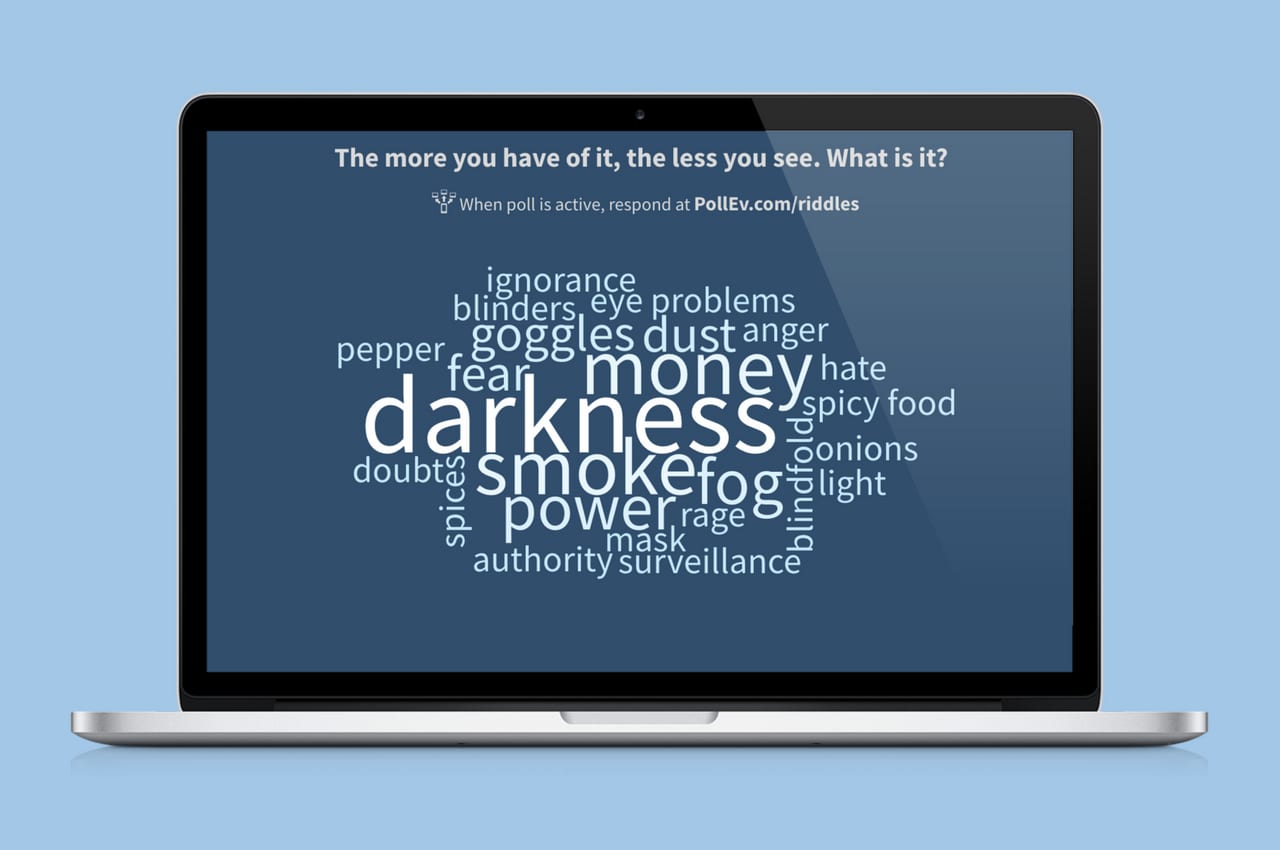
Riddles are a natural fit for Poll Everywhere word clouds . This activity transforms audience responses into a colorful, animated word cloud. Repeated words grow larger within the cloud.
Here’s how it works: create a new word cloud activity. Make the title a riddle that has a single-word answer (not a sentence or a list). Create the activity, and on the following screen locate the ‘Show results’ button. Click it so that a picture of two phones appears. Wait until everyone has responded to your riddle, then click ‘Show results’ again to reveal the finished word cloud. If the correct answer is the largest word in the cloud, that means most of the audience got it right.
By hiding the results and revealing them after everyone has voted, you prevent participants from submitting whatever seems like the most popular answer. When the results are hidden, there is a small counter in the lower left that shows you how many have responded. That way, you know when voting is finished.
5. 20 questions
Deduce a hidden image or photo by flying through 20 yes-or-no questions with the audience

Who doesn’t love a good game of 20 questions? Fortunately, it’s incredibly easy to play with your presentation audience.
Here’s how it works: display a word or picture (it could be anything from a celebrity to an animal) on the screen behind you — so that you can’t see it but the audience can. You can even ask someone to blindfold you if you don’t want to run the risk of cheating.
Now, your entire audience can see what’s on the screen, and it’s up to you to ask twenty “yes or no” questions that will help you guess exactly what’s being displayed.
Invite audience members to just yell out their answers to your questions simultaneously to create a lively game that’s sure to give your audience’s enthusiasm a boost. Double down on this by setting a 60-second timer for the questions. When time runs out, it’s time to guess.
6. Would you rather?
Learn how the audience thinks with a tricky “Would you rather?” scenario that divides the group

This presentation game is more of a conversation-starter than a traditional game. There should never be a right or wrong answer in a “Would you rather?” scenario. The winner is whoever best justifies their choice and why it’s the best one for them.
Here’s how it works: create a new multiple choice activity. Begin the title with “Would you rather…” and enter the two responses as the two scenarios. After you create this activity, locate the ‘ Visual settings ‘ button. Select it, then locate ‘ Donut chart ‘ and select that too. Doing so changes the look of your activity from a bar chart to a donut chart. Donuts are a great way to visualize the audience’s preference between two choices clearly.
To take this game a step further, start a discussion after the voting ends. Ask everyone who voted for one option to raise their hands. Then, go around the room and ask people to explain in a few words why they selected one option over the other. Save and email a copy of the donut chart afterwards as a memento.
7. Anagrams
Challenge the audience to come up with a unique solution to your anagram that on one else will guess

The crux of this presentation game is solving an anagram: a jumble of letters that can be rearranged into many different words. This is a fun mental exercise for the audience, doubly so if you’re breaking up multiple, back-to-back presentations.
Here’s how it works: create a Poll Everywhere word cloud . Select an anagram that’s at least five or six characters long, such as the one above, so that the audience has plenty of possibilities. If you want to give this a competitive edge, challenge the audience to submit words no one else will think of. These words appear as the smallest words in the cloud. If you do this, be sure to hide responses while everyone responds. Otherwise participants will copy each other’s responses.
For added fun, set the number of submissions to unlimited. Doing so rewards players for coming up with multiple unique words (thereby increasing their chances of winning) or by strategically submitting the same word multiple times to inflate its size in the cloud. You can see who submitted what on the activity’s response history page .
8. Trivia competition
Quiz the audience with multiple choice questions. A leaderboard updates live with the scores.

Nothing hooks the audience’s attention faster than putting their pride on the line. Do this with a friendly trivia competition. Trivia questions are fun. But graded trivia questions are a contest. Poll Everywhere has the perfect activity for this scenario.
Here’s how it works: create a Poll Everywhere competition . This activity is a fully customizable trivia contest. You create the questions. The audience plays for points, and a leaderboard shows everyone who is in the lead. The audience earns points for responding correctly. They also earn bonus points for responding quickly. Expect to hear gasps and cheers each time the leaderboard reveals the new point totals.
Competitions is a great interactive presentation game for energizing the audience. People can compete individually or group into teams and respond from a single phone or device. A timer adds some extra pressure and keeps the competition moving. Don’t want the added stress? Switch off the timer. Either way, when you reach the end the winner gets a fun confetti surprise.
9. Choose your own adventure
Let the audience vote to control the flow of your presentation
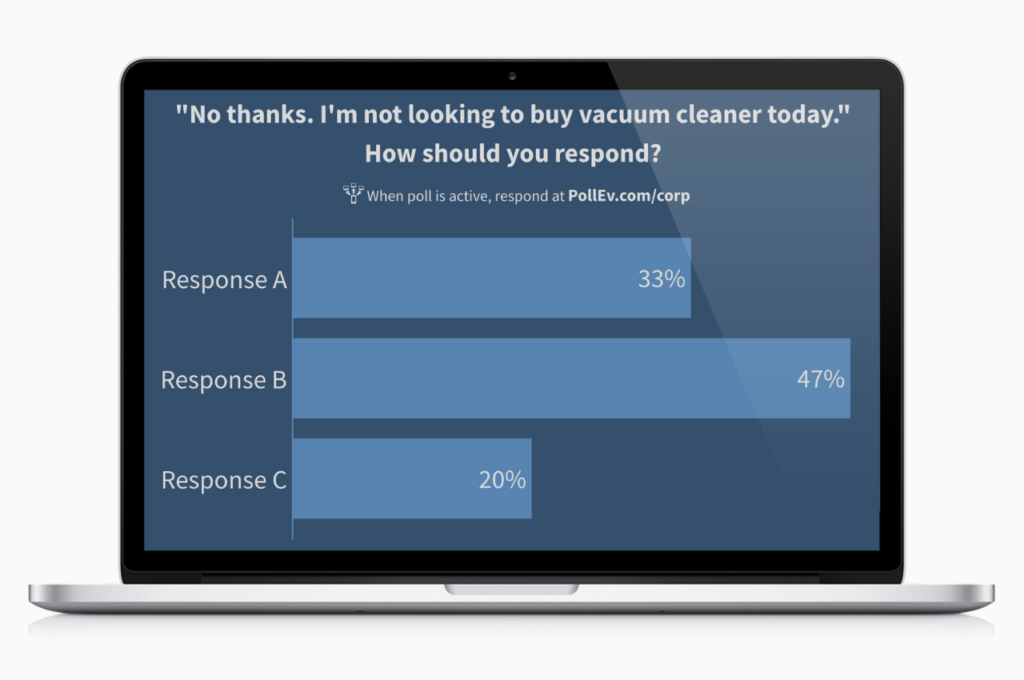
One of the best ways to reinforce new information is to give people the opportunity to use that information in some way. Poll Everywhere Multiple Choice activities are a simple, customizable way to create that opportunity for almost any topic.
Here’s how it works: Say you just finished presenting a lengthy seminar on how to sell vacuums door-to-door. Everyone in the audience has scribbled pages of notes on what to say to whom and when. But none of them has actually sold a vacuum, yet.
Create a choose-your-own-adventure conversation using a series of multiple-choice activities. Each activity is a different line from your fictional vacuum purchaser, and the audience votes on different replies. Whichever reply gets the most votes advances the conversation, for better or worse.
This style of questioning has plenty of applications besides vacuum salesmanship, but the core function should be constant: Giving the audience a simply way to reflect upon, and apply, what they just learned.
10. Fill in the blanks
A simple worksheet does double duty during presentations

Here’s how it works: Create a worksheet and print out several copies before your presentation. Each question on the worksheet should be an important line from your presentation – but there’s a word or phrase missing. Ask the audience to fill in those gaps as they listen.
This accomplishes two very important things for the audience. First, the questions on the worksheet make it obvious what the key points or takeaways are from your presentation. They know what to focus on and pay special attention to. Second, the completed worksheet doubles as a resource that summarizes what you just presented. Attendees can refer back to it later if they forget something.
You can gamify this exercise ever-so-slightly by entering everyone who completed the worksheet before the end of your presentation into a raffle. It’s up to you whether or not you announce this beforehand, or have it be a surprise at the end.
If you want to try any of the interactive presentation games yourself, create a Poll Everywhere account and start engaging your audience today!

Related articles

20 Interactive Presentation Games
- Employee Engagement , Event Planning , Leadership Techniques

Meetings and conferences can be painfully tedious and dull. So much so that the phrase “Death by PowerPoint” has made it into our lexicon. According to Thomas Sowell , an American political economist and commentator, “People who enjoy meetings should not be in charge of anything.”
But if the problem with meetings is that they tend to be boring, the solution lies in finding ways to better engage and entertain your audience. You probably know the feeling of sitting in a meeting, trying to pay attention while one person drones on for an hour.
Even if the purpose of the meeting is to train, disseminate new developments, or even get everyone up to speed on weekly goals, engaging your audience creates a motivation to pay attention.
That’s why interactive presentation games are a great way to re-energizing meetings by involving audiences in the presentation. Interactive presentation turn passive listeners into active participants. Games allow the attendees to learn new skills, think of solutions within a short time period, and solve problems together.
MeetingPulse equips your team with the tools and resources to create engaging events. With that in mind, here’s our guide to a few popular interactive presentation games.
Related: Creating a Positive Organizational Culture while working remote
1. Project Jeopardy

This game is designed to make the presentation of reports more fun and interactive. The lead person on the report creates cards that have answers from the report.
For example, the card reads “25%.” The rest of the team is supposed to ask the correct question corresponding to the “25%” answer on the card. The question could be something like, “What was the company revenue growth for the quarter?”
How to play: Give everyone the URL to your MeetingPulse meeting. Display the question on your screen and create multiple choice answers or leave it open-ended. The answers will pop up on the administrator’s screen in real-time, and you can share the answers to see how many people got it right.
2. Idea Box Game
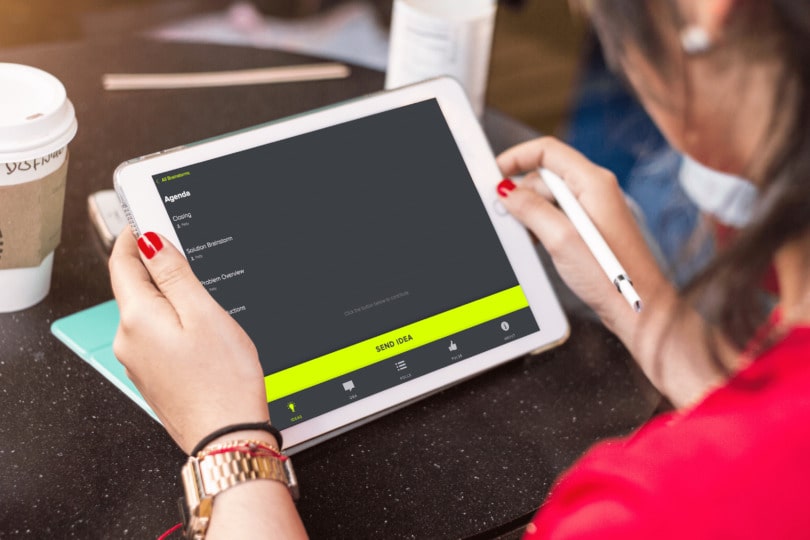
The Idea Box game is excellent for brainstorming meetings where employees can share ideas about a project or product . It helps get the creative juices flowing and might even lead to some usable prototypes. Instead of having one speaker after another speak about their idea, having a team create an idea box creates a space for collaboration to further spark innovation.
How to play: Use the MeetingPulse brainstorming tool to have teams vote and collect feedback about the products. Have each attendee log in to your MeetingPulse link — a virtual Idea Box. Give small groups thirty minutes to brainstorm, then allow submissions.
At the end of the exercise, each team should have the product name, features and functions, marketing taglines, and other vital product details.
Once each team has completed their box they’re invited to share it with the rest of the team who finally vote for the best box. Their ideas will appear on the screen right away, and participants can upvote or downvote in Reddit-style fashion and even submit emoji reactions.
3. The Introduction Game

This game is ideal for a new group of team members meeting for the first time on a mutual project or new hires joining a team. Give the new hires a chance to introduce themselves in an unforgettable manner.
How to play: Ask the new members to bring a personal item or a favorite song. During the meeting, introduce them by letting their song blare for a few minutes on the sound system and then ask them to say something about themselves. If you’re using the personal item, ask them to talk about the item and what it means to them.
4. The talking stick

This activity makes sure that anyone who has a contribution not only gets to do so, but also that they get to speak uninterrupted. Using the talking stick is a great, rapid-fire way to focus the meeting on deep and meaningful contributions.
How to play: Form a circle and make sure everyone’s seated. Before the discussion begins, everyone should agree that the moderator has the power to choose whoever speaks next. Once a member finishes talking, they should put the stick back in the center for the next person.
Use the MeetingPulse audience feedback capability to gain insight right away. Choose up to four emojis and allow your audience to react as they listen to new ideas.
5. Telephone game

The telephone game is used typically as an ice breaker or to liven up a group after a couple of mind-numbing presentations. While it doesn’t really work with a very large group, a sizable number like 10 to 15 people is just right.
How to play: The meeting leader whispers the latest company marketing strategy used to the person on their left who is then supposed to relay the message to the next person and on and on until the last person gets the message.
The last person then gets to tell the rest of the team the final message, and you can compare it to the primary message from the lead.
6. The trivia competition

You can use this game to test the attendees’ trivia knowledge of the company or of general business trends . Create a trivia competition where the members play for points and the winner gets a prize. Project the points for everyone to see the winner.
How to play: Formulate questions related to the company and use them for the trivia test. You can use MeetingPulse to create the questions with its live Q&A session software platform capabilities , and set the timer to begin the game together. To add an extra touch of fun, include images with your multiple choice questions. Visuals add to the level of engagement and give your meetings an extra edge.

7. Fill in the phrase

Check out Meeting Pulse for Cool and creative ways to make polling questions and Quizzes!
This game requires participants to fill in blanks on a survey or report. The survey or report should not be complete until the end of the presentation. This game rewards audiences for listening, and you can even provide some sort of prize.
How to play: Create a report for attendees that has blanks. As you continue with the presentation, invite them to fill in the blanks from the information you are giving. Not only does the audience remain engaged, but they retain crucial information better.
MeetingPulse integrates with Powerpoints , so you can use our single answer polling feature to play this game and display the results directly in your PowerPoint presentation.
8. Word of the day

Have a word of the day game as part of your presentation or meeting. It can be a phrase or a word.
How to play: The presenter should weave the word or phrase into their presentation and the audience acknowledges its use by shouting back. The word must come from the team and not the presenter. This activity keeps everyone alert. Sometimes shouting can be distracting in the middle of a meeting.
In this case, use the MeetingPulse emoji feature, and everyone can submit ? when you use the word “key learnings.”
9. The 20 questions game

You get 20 questions to help you identify a picture that you can’t see, but the audience can. The audience can only lead you with yes or no questions. Use this game to liven up the audience.
How to play: The audience will choose a picture that you can’t see. Have someone submit a photo and display it on the MeetingPulse user dashboard. Get blindfolded and begin to ask questions regarding the picture. You get only twenty questions to get it right.
If you’re an advertising agency, you can use this test your employees’ memory and see if they remember what you worked on. To keep track of all the questions and responses, have the audience choose “yes” or “no” by using a live audience polling tool instead of having them shout it out.
10. Call and response

This game keeps the audience focused. The leader in the meeting calls out a phrase randomly during their presentation and the audience responds to it .
How to play: Agree on the action to be taken every time the phrase is called out. The second the presenter calls out the word, your audience can dance, clap or just rise and seat. Alternatively, they can respond with a phrase, word, or an emoji using MeetingPulse.
11. What would I have done?
In this game, ask each member of the team what their alternative career would be. The point of the game is to open up to each other and foster conversation.
How to play: Each member writes down their alternative career and waits their turn to reveal. The audience collectively asks “What would you have done?” and the selected member responds explaining why they chose that alternative. This is another great game you can play virtually, especially if you’re working with a big team.
With MeetingPulse , you can find out everyone’s alternative career and even get some statistics.
12. Fabulous flags

In this game , team members draw things that matter to them on their flag. This is known as the personal flag game, and it’s an excellent ice breaker activity.
How to play: Everyone gets 10 minutes to draw objects or symbols that represent something meaningful in their lives. Each person gets two minutes to explain the items on their flag.

13. Botticelli

Similar to 20 questions, this game also tests your trivia. You keep in mind a person, place, or thing, and the audience has to guess. The game is a bit more complex because the player can talk back to the audience and distract them from the name.
How to play: The audience asks leading questions to which the player responds with a yes or no. If they ask a specific question like “Does the celebrity’s name start with B?” then the player can respond with “It’s not Brad Pitt.”
This game is logistically easy to plan because all you need to do is formulate the poll questions and integrate them into your PowerPoint with MeetingPulse .
14. Candy introductions

This is a game that allows people to get to know each other while enjoying some sweet treats. It’s excellent for training sessions where participants are complete strangers, providing general topics for introductions that employees can elaborate upon further.
How to play: The participants choose different types of candy from a bag and use each to represent different topics about themselves during the introduction. They can talk about family, career, hobbies, unexpected characteristic and dream destinations.
15. Crazy job interview

In this game, one participant tries to convince the others why they would be the best for a certain job. They have to expound on qualities given by another player and how those qualities make them a good fit.
How to play: The participant is given a career, like a supermodel. Then they are given random phrases like “angry with the queen” or “intellectually incompatible” and they have to use these phrases to explain why they would be great at being a supermodel.
16. The elimination game

The elimination game helps participants to get to know each other, using a series of questions to find out the most common and most rare similarities amongst people within your company.
How to play: The whole room is asked to stand up. The leader then asks elimination questions like “how many are attending this conference for the first time?” That group gets to sit down. The next is “remain standing if this is your fourth consecutive attendance.” The rest of the group sits down. And the elimination questions continue.
17. Would you rather

This is a fun game to liven up the room, giving participants two choices of something they can do. They have to choose the lesser evil.
How to play: The player is given a question with two very bad or very good outcomes. For example, if the employees are afraid of heights, ask, “Would you rather go sky diving or bungee jumping?”
If you want to play this game with a large group of people, you can use MeetingPulse to get answers in real time. This game can also provide valuable insight for you. For instance, you can ask, “Would you rather have a breakfast spread or small desserts for our next meeting?”
18. Anagrams
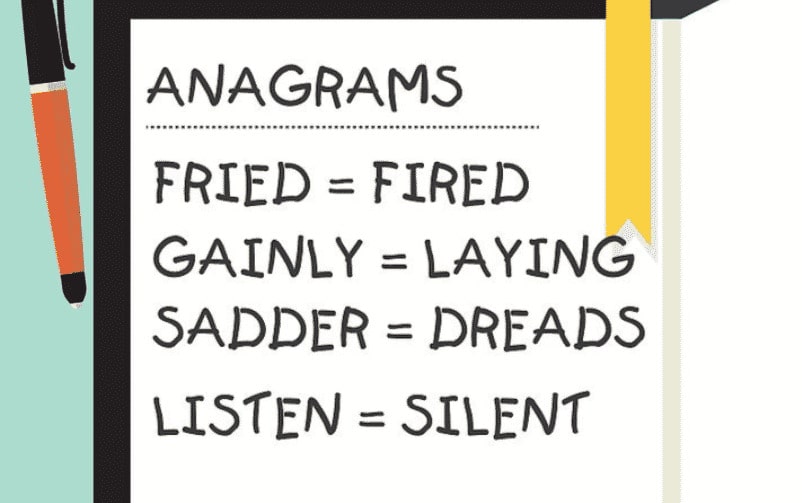
Think up a word and have everyone else try to figure it out. Expect some hilarious answers as everyone chips in.
How to play: Jumble up the letters but ensure that they create a five or six letter word anagram when correctly aligned. Only the presenter should suggest the word, and the activity should be timed. People can submit their answers live on MeetingPulse .
19. Two truths and a lie

The players get to tell two truths and one lie about themselves and the audience deciphers which one is the lie.
How to play: The player chooses a topic, like “career.” They tell two real facts about their career and one lie. The audience then decides which statement is false and why they believe that.
20. Choose the Agenda

In this activity, the participants choose the agenda of the meeting instead of being told what it is. This allow them to address burning issues.
How to play: Participants are invited to submit their agendas, which are shared by everyone and then voted on. The one with the most votes becomes the main agenda for the meeting. This gives participants control over the meeting as well.
You can use MeetingPulse’s brainstorming tool with the upvoting feature for this!
Final Thoughts
Now that you know some of the best interactive presentation games, you’re ready to host your next event with new and creative ways to keep your audience engaged. MeetingPulse is a great tool and resource for you to make your presentations more memorable and — dare we say it — fun.
Related: 25 Fun Poll Questions to Ask Your Audience
Get started with MeetingPulse today!
Share this article on your socials, latest posts.

Boosting Audience Engagement with Interactive Presentation Tools

Enhancing Employee Engagement with Interactive Meeting Software
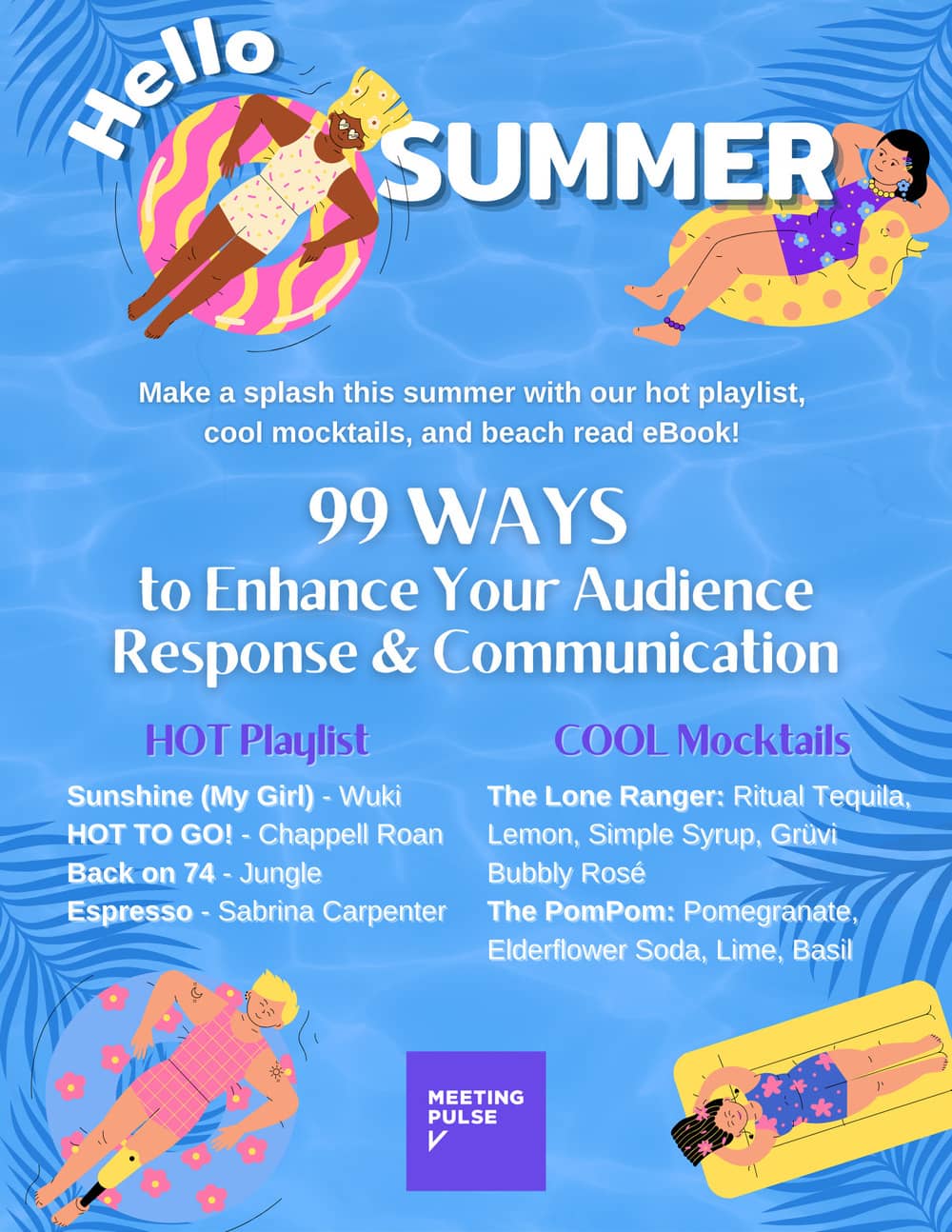
Cool Ideas for Your Hot Summer

The Benefits of Language-Inclusive Meetings and Events
Blog categories.
- Audience Response Tools
- Best Practices
- Employee Engagement
- Event Planning
- Hybrid Events
- Leadership Techniques
- Meeting Prep
- Organizational Development
- Uncategorized

To make MeetingPulse a seamless addition to your meetings, we offer custom themes. You can use your own logo and your colors in Attendee View as well as Broadcast View. Your company name can also be included in the webpage’s title. Your meeting can also have its own domain. This is great if you are going to promote your meeting offline. For example, you could use “acme2022.com” instead of “meet.ps/acme-all-hands”.

Live Product Tours
Weekly Product Tour Every Wednesday

- Success Stories
- Integrations
- Help Center
- Cvent Marketplace
- Connect with Zapier
- Trust Center
- System Status
- MeetingPulse User Reviews
- Skip to main content
- Skip to primary sidebar
- Skip to footer
- QuestionPro

- Solutions Industries Gaming Automotive Sports and events Education Government Travel & Hospitality Financial Services Healthcare Cannabis Technology Use Case AskWhy Communities Audience Contactless surveys Mobile LivePolls Member Experience GDPR Positive People Science 360 Feedback Surveys
- Resources Blog eBooks Survey Templates Case Studies Training Help center
Home LivePolls
15 Interactive Presentation Games to Engage Your Audience
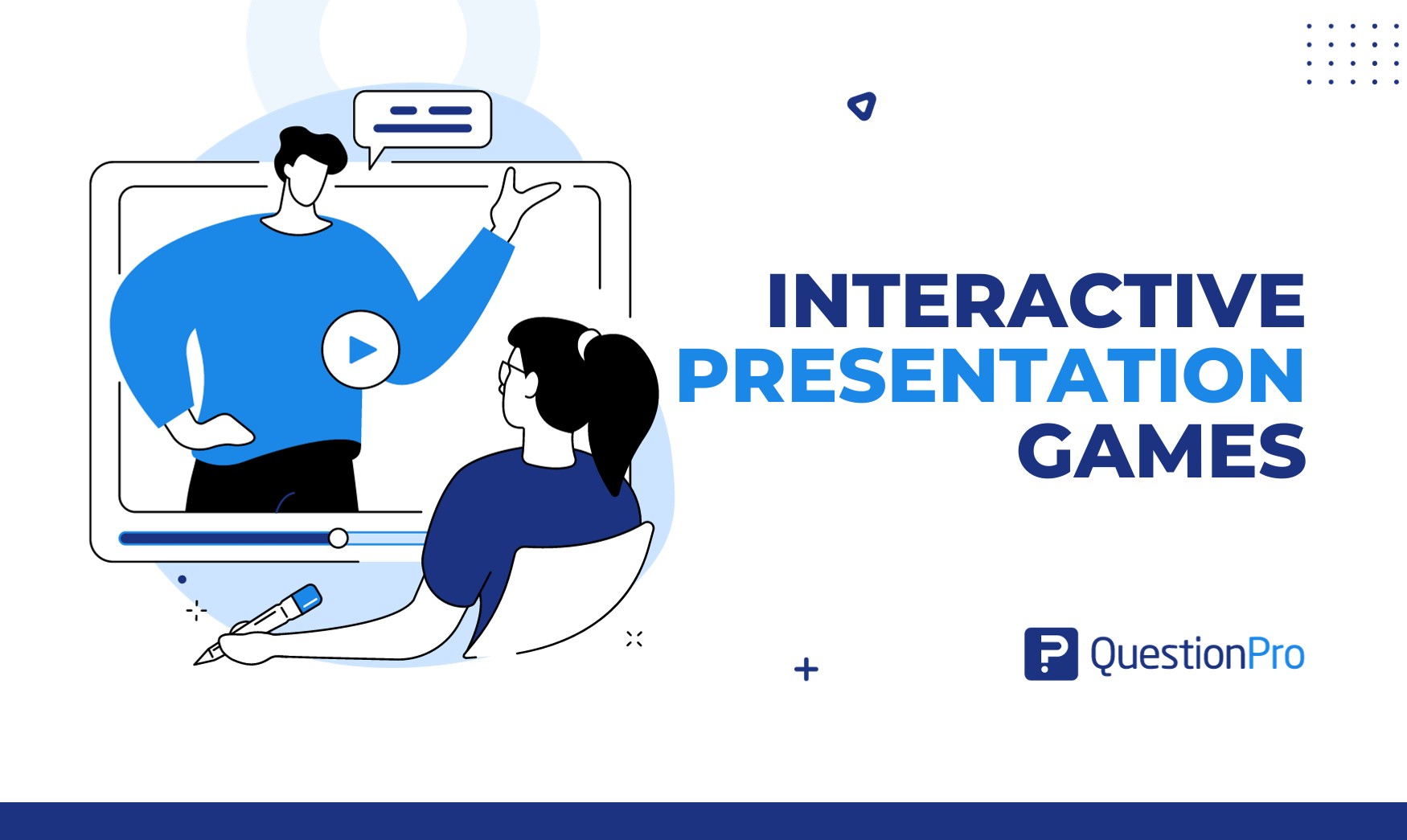
In the world of presentations and public speaking, engaging your audience is crucial. A captivating presentation can leave a lasting impact and ensure that your message is heard and retained. One effective way to achieve this engagement is by incorporating interactive presentation games into your talks.
Interactive presentation games break the monotony of traditional slideshows and transform passive listeners into active participants. In this blog, we’ll explore 15 interactive presentation games that can make your presentations more dynamic, memorable, and enjoyable for your audience.
Why Use Interactive Presentation Games?
Traditional presentations often involve passive listening, which can lead to disengagement and limited retention of information. On the other hand, interactive presentation games create an environment of active participation.
Making your presentations more memorable and impactful. They foster interaction, feedback, and collaboration, turning your audience into active participants rather than passive observers.
Benefits of Engaging Your Audience
Engaging your audience with interactive presentation games offers numerous benefits:
- Increased Engagement: Interactive presentation games grab your audience’s attention and keep them actively involved throughout the presentation.
- Improved Information Retention: Active participation enhances the retention of key information, ensuring that your message sticks with your audience long after the presentation is over.
- Enhanced Learning: Games encourage a deeper understanding of the subject matter, making it easier for your audience to grasp complex concepts.
- Better Audience Connection: By involving your audience, you establish a stronger connection, making them feel valued and heard.
- Immediate Feedback: Games provide opportunities for instant feedback, allowing you to address questions and concerns in real time.
- Fun and Entertainment: Interactive fun games add an element of fun and entertainment to your presentations, making them more enjoyable for your audience.
How to Choose the Right Presentation Games
Selecting the appropriate presentation games depends on your audience, topic, and objectives. Consider factors such as the size of your audience, the level of interactivity you desire, and the technology available. Tailor your choice of games to align with your presentation goals, ensuring they enhance your message rather than distract from it.
Now, let’s explore 15 interactive presentation games that you can incorporate into your presentations to engage your audience effectively:
01. Polling and Surveys
Polling and surveys involve asking questions to your audience and collecting their responses in real time. This game is useful for engaging the audience and gathering valuable data or opinions.
Example: During a marketing presentation, you can use polling to ask the audience which social media platform they use most frequently for product discovery, with response options like “Facebook,” “Instagram,” or “Twitter.” The results can guide your marketing strategy.
02. Quiz and Trivia
Quiz and trivia games challenge the audience’s knowledge of a specific subject. Correct-answer questions encourage competition and learning because participants’ scores are added up.
Example: In a history lecture, you can organize a trivia quiz about historical events. Ask questions like, “Who was the first President of the United States?” and award points for correct answers to make learning history engaging.
03. Interactive Q&A Sessions
Interactive Q&A sessions allow the audience to ask questions and engage in a live dialogue with the presenter. This interactive presentation game promotes engagement, clarification, and in-depth discussions.
Example: After a business strategy presentation, open the floor for an interactive Q&A session where the audience can ask questions about the proposed strategies, fostering a deeper understanding of the material.
04. Gamified Scenarios
Gamified scenarios present real-world situations or challenges to the audience. Participants make decisions, and the consequences of those choices are revealed, creating an immersive learning experience.
Example: In leadership training, simulate a business scenario where participants make decisions as managers. Their choices affect the company’s success, making the learning process engaging and interactive.
05. Virtual Reality and Augmented Reality Experiences
Virtual reality (VR) and augmented reality (AR) games provide immersive 3D experiences. Participants can explore virtual environments or interact with augmented elements.
Example: In a product launch presentation, use AR to allow the audience to visualize how the product would fit into their homes. They can use their smartphones to see a virtual presentation version of the product in their living rooms.
06. Storytelling Challenges
Storytelling challenges encourage participants to create and share their stories, fostering creativity and personal expression.
Example: In a team-building workshop, ask each participant to share a personal success story related to teamwork. This engages the audience and builds a sense of connection among participants.
07. Collaborative Whiteboard Activities
In real-time, collaborative whiteboard activities involve multiple participants contributing ideas, drawings, or annotations on a digital whiteboard. This game fosters teamwork and brainstorming.
Example: During a brainstorming session for a new project, use a digital whiteboard tool where team members can simultaneously sketch out their ideas and add comments. This promotes collaboration and idea generation.
08. Interactive Polls and Word Clouds
Interactive polls and word clouds engage the audience by having them vote or input keywords related to a topic. The results are displayed dynamically.
Example: In a conference PowerPoint presentation about technology trends, ask the audience to submit keywords related to the most exciting emerging technologies. Display the results in a word cloud to visualize the collective interest.
09. Simulations and Case Studies
Simulations and case studies replicate real-life scenarios for participants to make decisions and see the outcomes. This game is effective for practical learning.
Example: In a business strategy workshop, provide participants with a case study of a struggling company. Have them analyze the situation and propose strategies to turn the business around. The best solutions can be discussed as a group.
10. Role-Playing Exercises
Role-playing exercises involve participants taking on specific roles or characters to act out scenarios. This game promotes empathy and communication skills.
Example: In customer service training, participants can take on the roles of customers and service representatives. They act out various customer service scenarios to practice effective communication and problem-solving.
11. Breakout Rooms and Group Discussions
Breakout rooms and group discussions split the audience-focused audiences into smaller groups to discuss specific topics or tasks. This great game promotes active participation and in-depth exploration of ideas.
Example: In an educational webinar, use breakout rooms to divide participants into smaller groups. Each group discusses a different aspect of the topic and then shares their insights when they return to the main session.
12. Live Challenges and Competitions
Live challenges and competitions introduce competitive elements to the best presentation games. Participants can compete individually or in teams to solve problems or complete tasks.
Example: In a team-building event, organize a friendly competition where teams compete in a series of challenges. Challenges could include problem-solving tasks, physical activities, or trivia quizzes to foster teamwork and camaraderie.
13. Interactive Presentations
Interactive presentations incorporate multimedia elements, quizzes, and audience participation throughout the entire presentation screen to keep the audience engaged.
Example: During a product launch presentation, embed interactive elements such as polls, quizzes, and live demos within your slides. This ensures constant engagement and information retention.
14. Icebreakers and Energizers
Icebreakers and energizers are quick, fun activities designed to create a relaxed atmosphere and engage the audience at the beginning of a presentation or during breaks.
Example: At the start of a team meeting, use a fun icebreaker like “Two Truths and a Lie,” where each participant shares two true statements and one false one about themselves. It lightens the mood and promotes bonding.
15. Creative Challenges and Brain Teasers
Creative challenges and brain teasers stimulate creativity and problem-solving. They present puzzles, riddles, or creative tasks to engage the audience stand.
Example: During a creativity workshop, present participants with a riddle or a creative problem to solve as a group. Encourage them to think critically and come up with innovative solutions, fostering creative thinking.
How QuestioPro LivePolls can help in Interactive presentation games
When you use any tool for an interactive show, you need to think about how your audience votes and your presentation’s goals. Make sure the interactive elements enhance the learning or engagement experience rather than becoming a distraction.
Here are some ways a survey-based tool like QuestionPro can assist in creating interactive presentation games:
Question and Quiz Creation
Many interactive presentation game tools allow you to create questions and quizzes that you can integrate into your presentations. These questions can be multiple-choice, true/false, open-ended, or other formats. Participants can then respond to these questions during your presentation.
Interactive presentation fun game tools often include features that engage your audience. This can include things like timers for questions, leaderboards to display scores, and interactive survey elements that make your presentation more engaging and fun.
Feedback and Scoring
These tools typically provide instant feedback to participants. Correct answers might be rewarded with points, while explanations could follow incorrect answers. Scores are often tallied in real time, creating a competitive or gamified atmosphere.
Data Collection
Interactive presentation game tools can help you collect data on audience response software . This data can be valuable for assessing learning outcomes, understanding audience vote opinions, or tailoring your content to your audience’s preferences.
Customization
You can often customize the appearance and behavior of interactive elements to fit your presentation’s theme or style. This allows for creative and engaging presentations.
Audience Participation
Such tools enable audience members to actively participate and feel involved in your presentation. This can lead to higher engagement levels and better retention of information.
Reports and Analytics
Some tools provide analytics and reports after your presentation, which can help you assess the effectiveness of your interactive elements and the overall presentation.
Incorporating interactive presentation games into your talks can elevate your engagement, foster learning, and make your message more memorable. Whether you choose polls, quizzes, simulations, or storytelling challenges, tailoring the games to your audience and objectives is key.
By doing so, you’ll transform your presentations into dynamic and unforgettable experiences that leave a lasting impact on your audience. So, level up your presentations with these interactive games, and watch your audience become active participants in your message.
LEARN MORE CREATE FREE ACCOUNT
MORE LIKE THIS

Customer Experience Lessons from 13,000 Feet — Tuesday CX Thoughts
Aug 20, 2024

Insight: Definition & meaning, types and examples
Aug 19, 2024

Employee Loyalty: Strategies for Long-Term Business Success

Jotform vs SurveyMonkey: Which Is Best in 2024
Aug 15, 2024
Other categories
- Academic Research
- Artificial Intelligence
- Assessments
- Brand Awareness
- Case Studies
- Communities
- Consumer Insights
- Customer effort score
- Customer Engagement
- Customer Experience
- Customer Loyalty
- Customer Research
- Customer Satisfaction
- Employee Benefits
- Employee Engagement
- Employee Retention
- Friday Five
- General Data Protection Regulation
- Insights Hub
- Life@QuestionPro
- Market Research
- Mobile diaries
- Mobile Surveys
- New Features
- Online Communities
- Question Types
- Questionnaire
- QuestionPro Products
- Release Notes
- Research Tools and Apps
- Revenue at Risk
- Survey Templates
- Training Tips
- Tuesday CX Thoughts (TCXT)
- Uncategorized
- What’s Coming Up
- Workforce Intelligence
Blog > The 10 best PowerPoint Games to play in Workshops, Classrooms & Presentations
The 10 best PowerPoint Games to play in Workshops, Classrooms & Presentations
01.01.20 • #fun #game #powerpoint #presentation.
In our last blog post, we talked about tools and tips on how to boost the audience engagement in your presentation. One of our recommended ways to do so was to play games, as they release tension and function as a fun element that lightens the mood. That’s why today we are going to list the Top 10 best games to play in your presentation.
1. Would you rather
Is it a game that everyone knows already? Probably. But did we have to include it on the list because it is just perfect for playing with your audience? Definitely. The game is pretty much self-explanatory – You give your attendees two (or more) scenarios and they have to choose which one they’d rather experience. Combining the Would you rather – question with your presentation topic is usually very easy, but we also thought of some questions you could use for any topic (e.g. as an icebreaker, to get to know your audience a little better, to ask about their opinion or just as a fun element in between). You can let your audience vote by letting them raise their hands or by using an interactive poll tool such as SlideLizard .
- Would you rather A. travel back in time OR B. travel to the future OR C. stay in the present
- Would you rather A. have a long lunch break now OR B. have a short break and finish early
- Would you rather A. be able to read minds OR B. be able to fly OR C. be able to turn invisible
- Would you rather A. receive a letter from Hogwarts OR B. join Frodo on his journey OR C. Hog-what?
- Would you rather A. never be able to go on Social Media again B. never be able to read a book again

2. Charades
The popular game is not only great for your family’s game-night, but also for your presentations and workshops. Prepare a few cards that have words related to your presentation’s topic on them, let some volunteers in your audience draw and act them out. The rest of the audience has to guess the word. You can be sure that these terms and the associated performances will never be forgotten!

Small Trivia quizzes are perfect for checking and manifesting the audience’s knowledge at the end of your presentation. Instead of repeating and summing up what you have already said, you can let your participants test their knowledge right away. However, you can also use a quiz in the beginning to test your audience’s existing knowledge about a topic. But there are not only trivia quizzes: Questions about personality can also be interesting and work well as an ice breaker in the beginning. Again, we recommend a tool for poll creation, as that is the easiest way to conduct quizzes. In a recent article we listed 50 great questions (a mix of personality and trivia) , that you could use for your next presentation! And if you're a fan of quiz game shows, we also got a full Who wants to be a Millionaire PowerPoint template for you to download for free! You'll see how it looks like in the following video (be sure to turn up your sound!):
PowerPoint can be used for way more than most people know. Even we were amazed by people on the internet who created extensive games by animating content using PP. We don’t want to go that big today, but we are going to provide you with a free-to-download template of memory. You only have to add it to your presentation and customize the pictures or terms you want under the cards. Download free PPT Memory Template
5. Two Truths and a Lie
Here is another game that is just perfect when you play it with interactive poll tools. It is great for getting the audience to know you as a presenter better. Think of a fun, interesting or astonishing fact about yourself, and then invent two fake ones. Your attendees have to vote which statement they think is true. Be prepared to see some very surprised faces in your audience!

6. PowerPoint Karaoke
PowerPoint-Karaoke is the perfect improvisation game. Players are confronted with a set of slides they have never seen before and try to give a presentation as convincingly as possible. If you want to know all about this game and get some slides you can use for playing, check out our detailed blog post on PowerPoint-Karaoke .

7. Where do you stand?
For the game “Where do you stand?”, your attendees will actually have to stand up. Therefore, it is only convenient if you have enough space. If you want to get your participant’s opinion about something and get them to move a little, look no further! Create an imaginary line across the room. One end stands for one opinion, the other end for the exact opposite opinion. Your attendees can now place themselves on this line wherever they like (right in the middle, on either end or somewhere in between). You can then even interview people on the line (it is always interesting to choose two from opposite sites) and learn about their views. If you’re a little overwhelmed now, here are some examples you could use for this game:
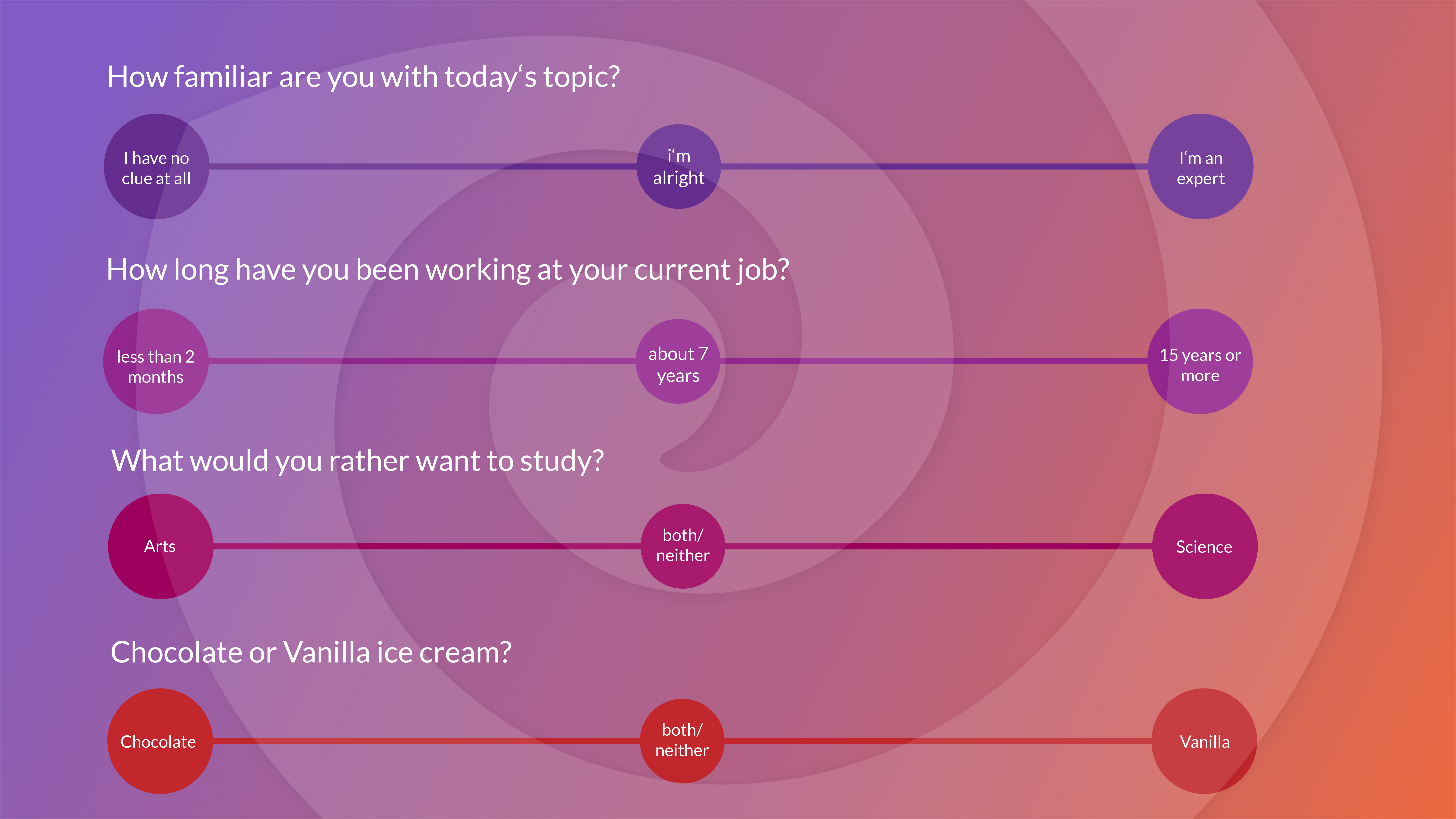
Attention – you can of course ask about political or more controversial topics, but that may escalate and turn into a fight, which is not the purpose of the game or your presentation.
8. Describe That
Let your audience draw from cards with words on them and then describe it for the other attendees. It is basically like charades, but with words instead of acting. Some may find that too easy. In that case, you can either choose terms that are extremely hard to describe or add some “Taboo-words” to the card that can’t be used for describing.

9. True and False
Have you ever heard a crazy, bizarre fact where you didn’t think that it could be true? Perfect. You can use it in the well-known “True and False”-Game. You pick out a fact (ideally something related to your presentation topic) and then let your audience vote (you know – via an interactive poll tool like SlideLizard ) if they think it’s true or not. A tip for making statements false: Change little things about the them, like numbers, dates or names or use common misconceptions and see how many of your attendees buy into them, e.g. “Bulls are enraged by the color red” (which is false, bulls are simply enraged by movement, not specific colors).

10. The never-ending sentence
The never-ending sentence is a great game that incorporates many of your attendees and awakens their brain cells. It is perfect for keeping up their engagement and interest, especially for long presentations or workshops when you feel like some people are getting a little tired. Simply start by saying a word – it can be related to the presentation’s topic if you want – and ask a person in your audience to repeat that word and add another one – the next person to repeat those two words and add another one as well , and so on, until a sentence forms. As it gets longer the game gets a lot more difficult, because there is a lot more to remember and to repeat. The sentence can’t be ended, it has to be continued until someone makes a mistake (or until the last person in the room has added a new word). We promise that you will be left with a lot of fun, creative, and straight-up weird sentences that will make your audience laugh a lot.

Related articles
About the author.

Pia Lehner-Mittermaier
Pia works in Marketing as a graphic designer and writer at SlideLizard. She uses her vivid imagination and creativity to produce good content.

Get 1 Month for free!
Do you want to make your presentations more interactive.
With SlideLizard you can engage your audience with live polls, questions and feedback . Directly within your PowerPoint Presentation. Learn more

Top blog articles More posts
Best Sources for free Icons to use in PowerPoint Presentations

How to highlight image area in PowerPoint

Get started with Live Polls, Q&A and slides
for your PowerPoint Presentations
The big SlideLizard presentation glossary
Visual communication.
If there are used images or videos for communication, it is visual communication. Visual Communication is almost used everywhere like on television, posts on social media (Instagram, Facebook), advertisement.
.odp file extension
.odp files are similar to .ppt files. It's a presentation which was created with Impress and contains slides with images, texts, effects and media.
Vocalized pause
A vocalized pause means the pause when the silence between words is filled by the speaker with vocalizations like "um", "uh" and "er".
Student Response System (SRS)
With Student Response Systems (SRS) it is possible to get live student feedback in the classroom. Questions and answers can usually be asked and given anonymously, which increases participation and engagement. An SRS may be used for any grade, including university.
Be the first to know!
The latest SlideLizard news, articles, and resources, sent straight to your inbox.
- or follow us on -
We use cookies to personalize content and analyze traffic to our website. You can choose to accept only cookies that are necessary for the website to function or to also allow tracking cookies. For more information, please see our privacy policy .
Cookie Settings
Necessary cookies are required for the proper functioning of the website. These cookies ensure basic functionalities and security features of the website.
Analytical cookies are used to understand how visitors interact with the website. These cookies help provide information about the number of visitors, etc.
5 Interactive PowerPoint Game Templates for Unforgettable Lessons
Ausbert Generoso
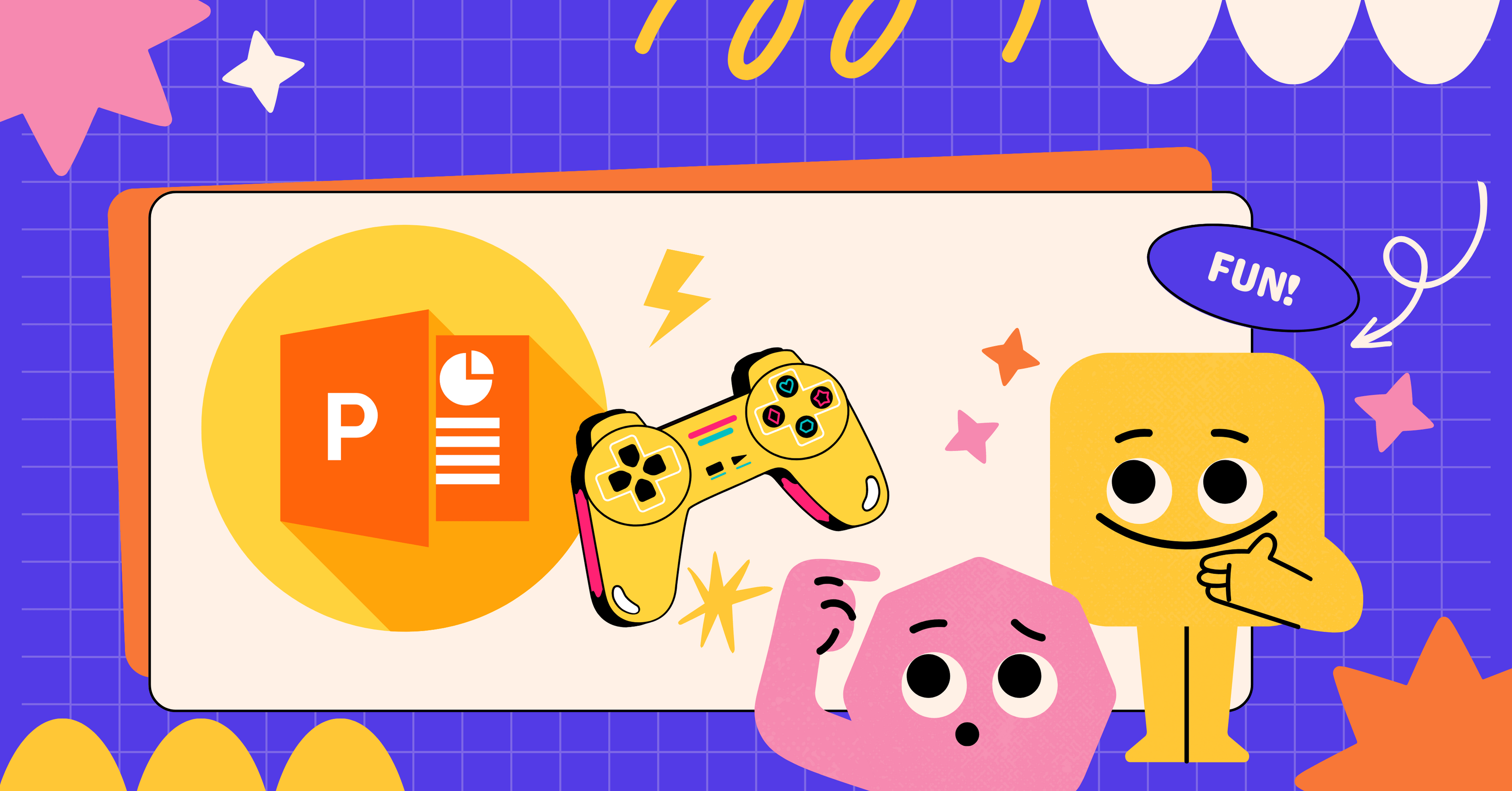
In the digital age, PowerPoint has evolved far beyond its traditional role as a static slideshow tool. It has emerged as a versatile canvas where creativity knows no bounds, and where education and entertainment can seamlessly co-exist. Imagine captivating your audience not just with information but with an interactive journey that sparks curiosity, competition, and camaraderie. This is the magic of PowerPoint games.
📸 Picture this: a classroom abuzz with excitement as students eagerly participate in a trivia quiz that feels more like a game show. Or a virtual conference where attendees don’t just listen passively, but actively engage with the content, making choices that shape the narrative. The secret behind these captivating experiences lies not just in PowerPoint itself, but in the innovative tools that unlock its true potential.

In this blog, we will explore the art and science of creating games that educate, entertain, and leave a lasting impact. We will delve into the principles of gamification with actual, downloadable PowerPoint game templates powered a subtle yet potent ally that can further elevate your game. Follow along so you would know what this power tool is!
8 Editable PowerPoint Game Templates
Engage your audience with these interactive PowerPoint Games. Customize these templates to fit your very own topic and presentation. The file includes templates for Interactive Quizzes, Family Feud, Wheel of Fortune, Memory, Hangman, Jeopardy, and a PowerPoint Puzzle!
The Power of Gamified PowerPoints
Ah, the thrill of the game – it’s not just about fun, it’s about learning too! Gamification has unleashed a revolution in education , transforming the way we absorb knowledge. Imagine turning seemingly mundane concepts into exciting challenges, where every answer unlocks a new level of understanding. That’s the magic of gamification, and it’s changing the game (pun intended 😉) in classrooms and beyond.
But here’s the twist – technology isn’t just a bystander; it’s the co-pilot on this educational joyride. In the world of PowerPoint games , technology plays a pivotal role in infusing interactivity and engagement into the learning process . With a click and a slide, we’re whisked away to a realm where questions become quests, and answers are the keys to conquering new horizons.

Now, imagine taking this gamification marvel and coupling it with the prowess of PowerPoint. Enter powerpoint games – a blend of creativity, technology, and education that opens doors to a whole new dimension of learning. And guess what? Tools like ClassPoint are your trusty sidekicks, effortlessly enhancing this gamification journey.
Are you ready to turn your lesson into an epic adventure?
We have prepared a collection of captivating PowerPoint game templates that you can use straightaway! Each one is meticulously designed to transform education into a thrilling journey. With the help of these templates and ClassPoint’s ingenious gamification features , you will be able to create interactive PowerPoint games that capture attention, spark curiosity, and foster a deeper understanding of your content.
Let’s get started!
PowerPoint Game Template #1: Memory Game
Who said memory exercises have to be boring? With our Memory Game template, you will be able to craft an engaging classroom challenge that is not only entertaining but also enhances memory recall. Using a mix of shapes and in-app icons, you will create a grid of hidden blocks, each concealing unique icons.
Memory Game PowerPoint Template
Download this PowerPoint template to start creating Memory Games in PowerPoint!
PowerPoint Game Template #2: Slide Zoom AI-Generated Quiz
Behold the Slide Zoom AI Quiz – a dazzling fusion of technology and education that will leave your audience in awe! Thanks to ClassPoint’s AI quiz feature , generating questions is a breeze. It is as simple as creating a PowerPoint slide; our AI does the rest. Whether your slide is about “marketing” or even “bananas,” our AI can create questions in a snap. Powered by OpenAI , the very technology that fuels ChatGPT , ClassPoint AI provides you with a ready-to-go quiz in seconds!
But that is not all! Transform these question slides into dynamic mini slides using PowerPoint slide zoom animation to bring your PowerPoint game to the next level. And the magic does not have to stop there – utilize ClassPoint’s Draggable Objects to reveal these mini slides, adding a dash of intrigue to your PowerPoint game.
And let us not forget the pièce de résistance – unleash the power of ClassPoint’s gamification features for the ultimate game mode. It is not just a quiz, but also an unforgettable experience in the world of PowerPoint games!
Slide Zoom AI Quiz PowerPoint template
Download this PowerPoint template to start creating AI Quiz Games in PowerPoint!
PowerPoint Game Template #3: Hidden Picture Game
Picture a puzzle where each question holds a clue to a hidden picture. But that is not all – ClassPoint’s dynamic presentations tools let you orchestrate the unveiling, turning it into a suspenseful adventure with drag & drop + live inking . As the game master, you hold the power to reveal the mystery picture.
And with an added wow factor from ClassPoint’s gamified stars , you will amplify the excitement and competition, making this template a true crowd-pleaser.
Hidden Picture PowerPoint template
Download this PowerPoint template to start creating Hidden Picture Games in PowerPoint!
PowerPoint Game Template #4: Mandela Effect Quiz
Step into the realm of the Mandela Effect Quiz – a mind-bending exploration of memory and perception. Here’s the twist: it’s all about Multiple Choice magic, brought to you by ClassPoint’s interactive quiz question buttons . Participants receive the multiple-choice question slide on their smartphones, engaging in an instant battle of wits. Which is fact, which is fiction? Let your students find out. Challenge your audience’s understanding, spark debates, and bask in the thrill of discovering the truth together.
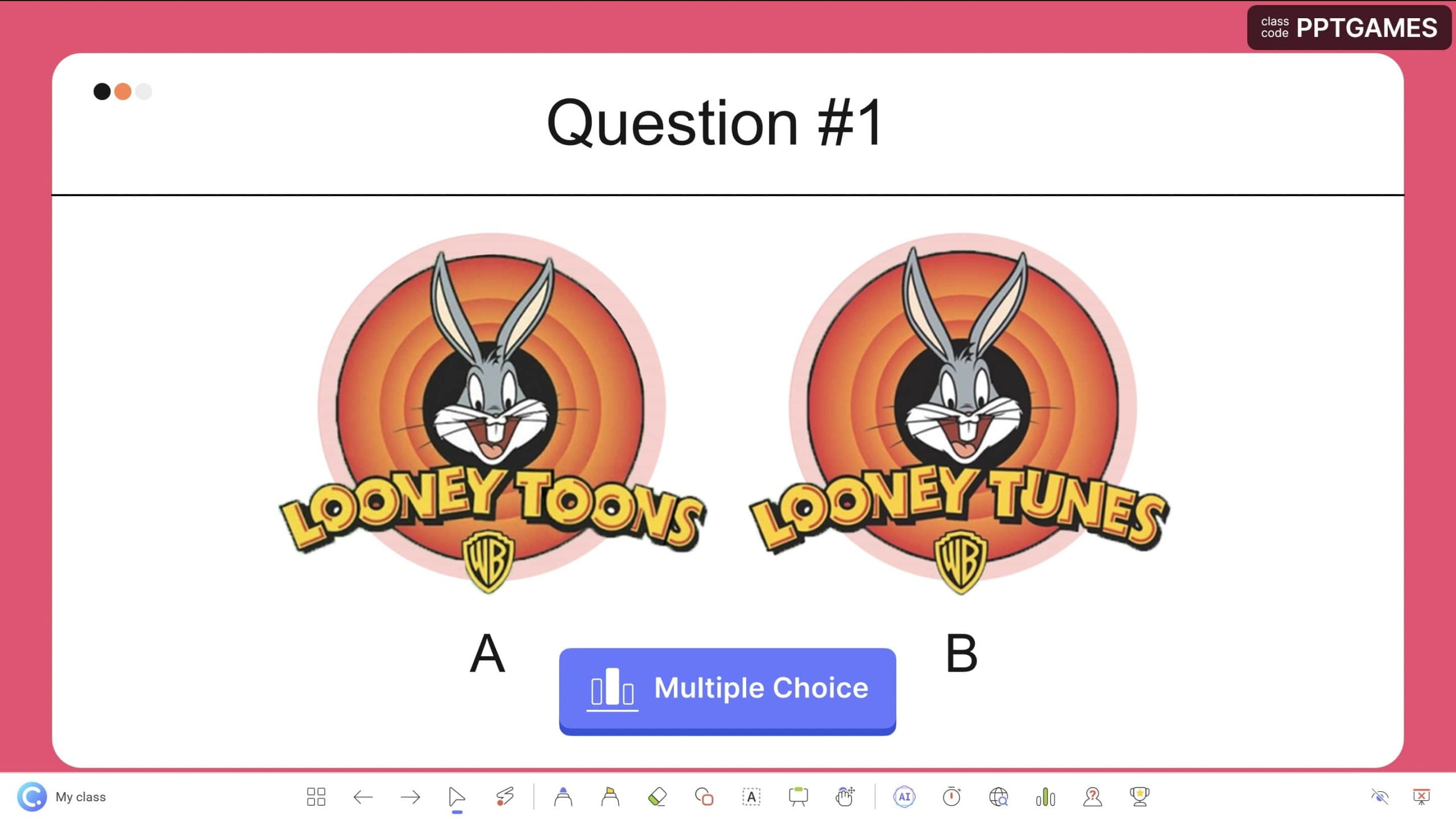
Mandela Effect Quiz Game PowerPoint template
Download this PowerPoint template to start creating Mandela Effect Quiz Games in PowerPoint!
[Bonus] PowerPoint Game Template #5: Trivia Quiz
The PowerPoint game templates list would not be complete without a trivia quiz template. Prepare for an exhilarating twist that will leave your students spellbound. Brace yourselves with the list of exciting trivia questions from easy to difficult, all orchestrated by the ingenious interactive quiz question buttons seamlessly integrated in PowerPoint from ClassPoint. Participants can easily participate in your PowerPoint quizzes simply by using their device! As the participants embark on this mental showdown, you can effortlessly spice up the game atmosphere by awarding stars and revealing the leaderboard at the end of each round!
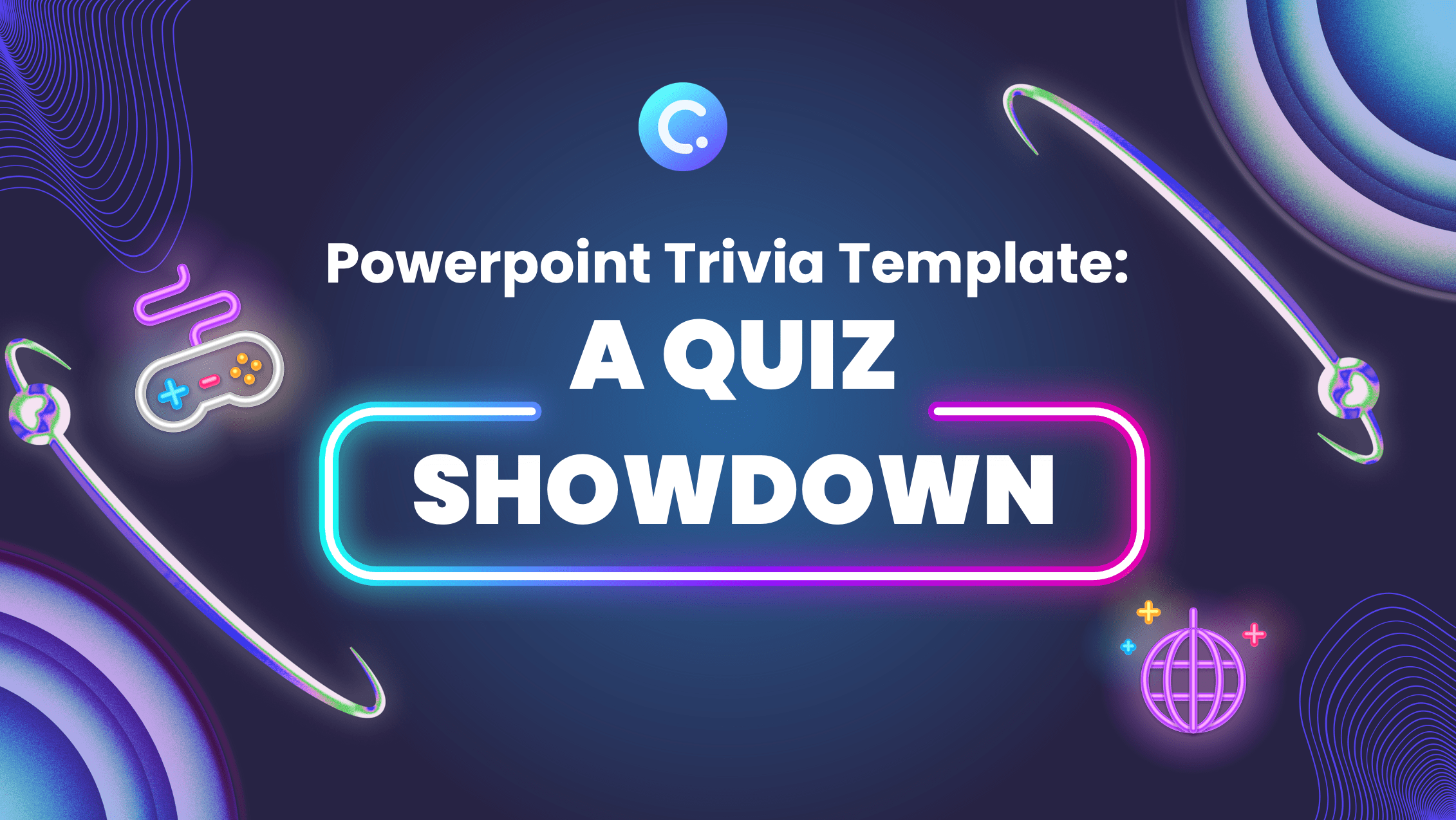
Trivia Quiz Game PowerPoint template
Download this PowerPoint template to start creating Trivia Quiz Games in PowerPoint!
To ensure a smooth experience in using the above templates, make sure you have ClassPoint within your PowerPoint app! Don’t have an account yet? Sign up here .
And now, armed with our arsenal of PowerPoint game templates, you stand poised to usher your classroom teaching into an unparalleled realm of excellence and excitement! But, before you set forth on this transformative journey, we would like to let you in to one final secret , which allows you to turn these PowerPoint game templates into more powerful game adventures. Keep reading!
Elevating Your PowerPoint Games with ClassPoint
With the PowerPoint game templates alone, you will only be able to scratch the surface of interactive and gamified teaching. ClassPoint takes this playful and gamified learning to an entirely new dimension, turning your presentations into interactive adventures that engage, inspire, and educate like never before. We will share with you a myriad of ways on how you can make use of the ClassPoint integrated features in the PowerPoint game templates and easily turn any ordinary presentations into one-of-its-kind PowerPoint games:
- Interactive Quizzing
ClassPoint’s interactive quizzes integrated inside PowerPoint allow you to turn ordinary PowerPoint slides into captivating quizzes with a mere click. Thanks to ClassPoint’s magic, question buttons become gateways to engagement and game sessions in PowerPoint. Participants can easily join any of the interactive quizzes using their smartphones or devices, while the presenter collects the responses on PowerPoint effortlessly.
- Drag and Drop
The ability to drag and drop in PowerPoint is paramount for crafting captivating interactive games. Luckily, with ClassPoint’s Draggable Objects , you can turn your PowerPoint elements into draggable objects effortlessly. With ClassPoint’s ingenious Draggable Objects feature, your PowerPoint is bestowed with unparalleled flexibility instantly. It seamlessly transforms any elements within your presentation into draggable entities, allowing them to be manipulated effortlessly during Slideshow mode.
- Handy Slide Show Tools
Wave goodbye to mundane presentations and say hello to dynamic control. With ClassPoint wide range of presentation features , you wield the power to create interactive PowerPoint game experiences that astonish. Spin the wheel to randomly select names , orchestrate live inking sessions, and indulge in dynamic drag-and-drop activities – all while your audience is on the edge of their seats.
- Gamified Learning Journey
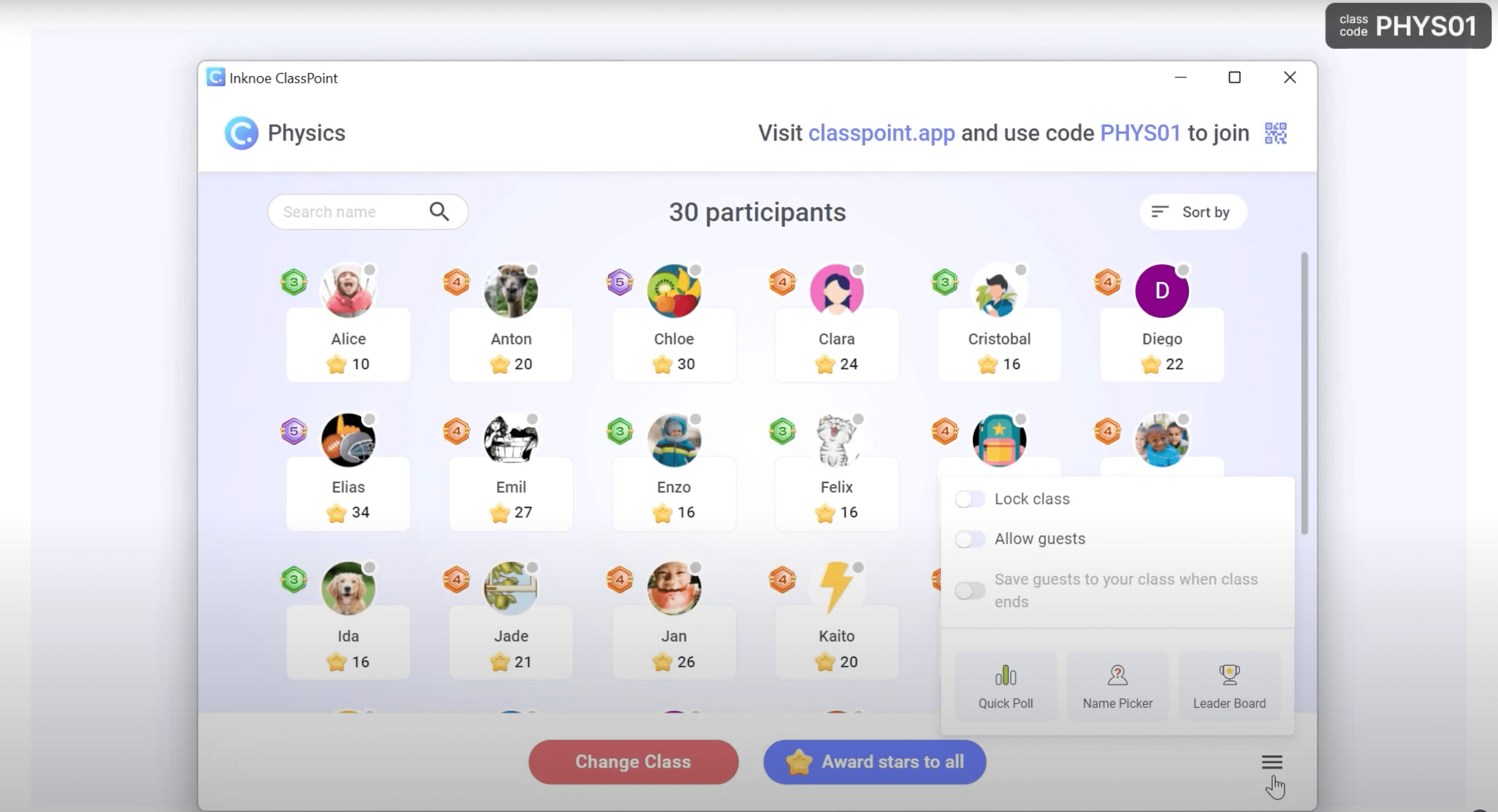
PowerPoint games reach new heights with ClassPoint’s star-studded reward system available in PowerPoint Slideshow mode. During PowerPoint games, you can award students stars , elevate them through levels , and watch as they proudly adorn badges of achievement. The competitive spirit soars as the in-built leaderboard paints a vivid picture of who’s ruling the knowledge arena.
- Student Performance Data
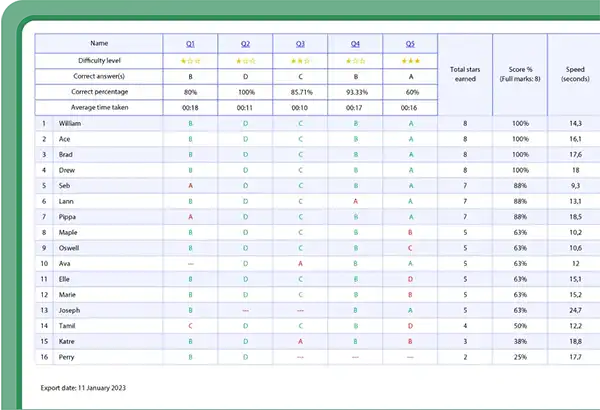
Let us not forget to keep track of student performance while we incorporate games into student learning. Luckily, ClassPoint is more than interactive bells and whistles. It is a data-driven ally, enabling you to track student performance with precision during PowerPoint games! Downloadable Excel reports and quiz summaries are available right at your fingertips to paint a comprehensive picture of your student progress.
- Real-time Game Feedback
No more waiting for post-game surveys. With ClassPoint’s quick poll , real-time feedback is your constant companion. Gauge understanding, adjust your approach, and make instant connections with your audience’s insights during or after your PowerPoint games!
The best part is — ClassPoint does not just play well with PowerPoint – it dances harmoniously within it. ClassPoint is seamlessly integrated with PowerPoint so you can turn any ordinary presentation slides into a game adventure instantly! No app-switching drama; just pure, uninterrupted focus on creating engaging content.
Interactive Puzzle PowerPoint Templates
Master the tricks to turn your PowerPoint into an interactive experience today!
The Psychology Behind Gamification
Gamification isn’t just about the thrill of competition – it is a carefully crafted blend of psychology and technology that captivates minds and fuels a hunger for knowledge. Let us explore the psychological underpinnings that make gamified PowerPoint presentations an educational powerhouse:
“Students get challenged when they see a particular colleague of theirs doing much better than others, creating a competitive yet fun atmosphere during class.” Nancy Martin, SEO Manager, FTKnowledge
🧠 Intrinsic Motivation
Gamification taps into our innate desire to learn and achieve. By framing learning as a game, students become more self-motivated, eager to conquer challenges and unlock new levels of understanding.
💭 Immediate Feedback
The instant gratification of feedback in gamified presentations is a game-changer. It satisfies our craving for knowledge validation and fuels the urge to keep progressing.
🎯 Goal-Oriented Learning
Just like a game’s objective, learning becomes purposeful. Each concept mastered is a checkpoint reached, making the learning journey feel like a series of accomplishments.
🎁 Rewards and Recognition
The allure of rewards, badges, and stars triggers a surge of dopamine – the brain’s feel-good chemical. This not only boosts engagement but also makes learning a positively charged experience.
🏆 Sense of Achievement
Accomplishments in gamified PowerPoint games create a sense of achievement that’s hard to replicate in traditional learning settings. Every correct answer and level completed becomes a mini-victory.
🙋🏻♂️ Active Participation
The interactive nature of gamification transforms passive listeners into active participants. This hands-on approach solidifies understanding, as learning becomes an experience rather than a lecture.
🎱 Competition and Collaboration
Gamification strikes a balance between healthy competition and teamwork. ClassPoint’s features, like leaderboard , inspire friendly rivalry while fostering cooperation and peer learning.
😮💨 Reduced Anxiety
The game-like environment reduces anxiety associated with learning. Students feel more comfortable taking risks, experimenting, and learning from mistakes.
⏳ Long-Term Engagement
By tapping into our psychological need for novelty and challenge, gamified presentations maintain long-term engagement, preventing knowledge decay over time.
📚 Personalized Learning
Gamification allows for tailored experiences. Students can navigate at their own pace, focusing on areas they find challenging, enhancing the feeling of individualized attention.
And so, we come to the end of our journey through the world of PowerPoint games and the magic of ClassPoint. This adventure has not only shown us the power of technology but also the incredible possibilities it brings to education. But more than just the technical aspects, remember the heart of it all – the excitement of discovery, the connections made, and the joy of learning something new.
Here’s to those “aha” moments, the animated discussions ignited by quizzes, and the sense of accomplishment that accompanies every step forward in learning.
Ready to take your PowerPoint games to the next level? Sign up for a free ClassPoint account now and embark on an educational journey where engagement knows no limits. Unleash the power of interactive design and gamification, and transform your presentations into captivating learning experiences that leave a lasting impact. Let’s make learning an adventure together!
Download All 8 Editable PowerPoint Game Templates
Engage your audience with these interactive PowerPoint Games. Customize the templates to fit your very own topic and presentation. The file includes templates for Interactive Quizzes, Family Feud, Wheel of Fortune, Memory, Hangman, Jeopardy, and a PowerPoint Puzzle!
About Ausbert Generoso
Try classpoint for free.
All-in-one teaching and student engagement in PowerPoint.
Supercharge your PowerPoint. Start today.
800,000+ people like you use ClassPoint to boost student engagement in PowerPoint presentations.
We use essential cookies to make Venngage work. By clicking “Accept All Cookies”, you agree to the storing of cookies on your device to enhance site navigation, analyze site usage, and assist in our marketing efforts.
Manage Cookies
Cookies and similar technologies collect certain information about how you’re using our website. Some of them are essential, and without them you wouldn’t be able to use Venngage. But others are optional, and you get to choose whether we use them or not.
Strictly Necessary Cookies
These cookies are always on, as they’re essential for making Venngage work, and making it safe. Without these cookies, services you’ve asked for can’t be provided.
Show cookie providers
- Google Login
Functionality Cookies
These cookies help us provide enhanced functionality and personalisation, and remember your settings. They may be set by us or by third party providers.
Performance Cookies
These cookies help us analyze how many people are using Venngage, where they come from and how they're using it. If you opt out of these cookies, we can’t get feedback to make Venngage better for you and all our users.
- Google Analytics
Targeting Cookies
These cookies are set by our advertising partners to track your activity and show you relevant Venngage ads on other sites as you browse the internet.
- Google Tag Manager
- Infographics
- Daily Infographics
- Popular Templates
- Accessibility
- Graphic Design
- Graphs and Charts
- Data Visualization
- Human Resources
- Beginner Guides
Blog Marketing 15 Interactive Presentation Ideas to Elevate Engagement
15 Interactive Presentation Ideas to Elevate Engagement
Written by: Krystle Wong Aug 04, 2023

As attention spans continue to shrink, the challenge of engaging audiences in a short timeframe has never been more significant. Let’s face it — grabbing and keeping your audience’s attention can be quite the challenge, especially when time is ticking away. But fear not, I’ve got the perfect solution: interactive presentations!
Believe it or not, creating an interactive presentation is easier than you might think. In this guide, I’ll show you how to effortlessly turn ordinary slides into captivating experiences with 15 interactive presentation ideas that will leave your audience begging for more. From quirky polls and fun games to storytelling adventures and multimedia magic, these ideas will take your presentation game to the next level.
Venngage is a game-changer when it comes to empowering interactive presentations. With just a few clicks, users can customize their favorite presentation templates , add multimedia content and create immersive experiences that leave a lasting impact. Whether you’re a seasoned presenter or a newcomer, get started with Venngage to elevate your presentation game to new heights of engagement and creativity.
Click to jump ahead:
What is an interactive presentation?
15 ways to make a presentation interactive, 7 best interactive presentation software, what are some common mistakes to avoid when creating interactive presentations, interactive presentation faqs, how to create an interactive presentation with venngage.

An interactive presentation is a dynamic and engaging communication format that involves active participation and collaboration between the presenter and the audience. Unlike traditional presentations where information is delivered in a one-way manner, interactive presentations invite the audience to interact, respond and contribute throughout the session.
Think of it as a two-way street where you and your audience have a friendly chat. It’s like playing a fun game where you ask questions, get live feedback and encourage people to share their thoughts.
To make a good presentation , you can utilize various tools and techniques such as clickable buttons, polls, quizzes, discussions and multimedia elements to transform your slides into an interactive presentation. Whether you’re presenting in-person or giving a virtual presentation — when people are actively participating, they’re more likely to remember the stuff you’re talking about.

Interactive presentations leave a lasting impression on the audience. By encouraging active participation and feedback, interactive presentations facilitate better understanding and knowledge retention. Here are 15 innovative 5-minute interactive presentation ideas to captivate your audience from start to finish:
1. Ice-breaker questions
Start your presentation with intriguing and thought-provoking questions or a fun icebreaker game. These questions should be designed to pique the audience’s curiosity and encourage them to think about the topic you’ll be covering. By doing so, you create an immediate connection with your audience and set the stage for a more engaged and attentive audience.
For example, if you’re giving a business presentation about management and leadership training, you could ask audience questions such as “What’s the best business advice you’ve ever received, and how has it impacted your career?”

2. Live polling
Incorporate live polls during your presentation using audience response systems or polling apps . This allows you to collect real-time feedback, opinions and insights from active participants. Live polling encourages active participation and involvement, making your presentation feel like a collaborative and interactive experience.
3. Q&A sessions
Encourage the audience to ask questions throughout your presentation, especially for pitch deck presentations . Address these questions in real-time, which fosters a more interactive and dynamic atmosphere. This approach shows that you value the audience’s input and promotes a two-way communication flow.
4. Clickable buttons
Add clickable buttons to your slides, allowing the audience to navigate to specific sections or external resources at their own pace. For example, you could include links to your social media accounts or extra reading materials in your education presentation to give further information about the topic and get your students engaged.
By providing this autonomy, you empower the audience to explore areas of particular interest, creating a more personalized and engaging experience through your interactive slideshow.

5. Storytelling
Incorporate anecdotes or personal stories related to your topic. Storytelling is a powerful way to emotionally connect with your audience, making your presentation more relatable and memorable. A little storytelling along with a set of creative slides draws the audience in and keeps them engaged as they follow the narrative.
6. Interactive charts and graphs
Use interactive charts and graphs that respond to user input to make your presentation interactive. For instance, allow the audience to click on data points to view more detailed information or to change the displayed data series. Creating charts with interactive visuals help the audience interact with the data, fostering better understanding and engagement.
7. Animated infographics
Add animations to your infographics, making them visually dynamic and progressive. Animated infographics reveal information gradually, keeping the audience curious and attentive. This transforms complex data into an easily digestible and engaging format.
Venngage’s extensive library of infographic templates is a powerful tool to visualize data and elevate the interactivity of your presentations. Personalizing the visuals ensures a cohesive and professional look throughout your interactive presentation. The templates are highly customizable, allowing you to adjust colors, fonts, and styles to match your presentation’s theme and branding.

8. Gamification
Introduce an interactive quiz, puzzles, or challenges related to your presentation content. Gamification adds an element of fun and competition, motivating the audience to participate actively and boosting their learning experience. Here are some gaming presentation templates you could use.

9. Virtual reality (VR) or augmented reality (AR)
If applicable, leverage VR or AR technologies to provide immersive experiences. These interactive presentation tools transport the audience into a virtual or augmented environment, making your presentation more captivating and memorable.
10. Collaborative whiteboarding
Get your audience involved in your presentation by utilizing digital whiteboards or collaborative tools to brainstorm ideas collectively. This fosters teamwork and creativity, enabling the audience to actively contribute and feel a sense of involvement in the presentation.

11. Hyperlinked text
Keep the information in your slides minimal with a simple presentation and incorporate hyperlinks to direct viewers to relevant websites or blogs , resources, or additional information. This encourages self-exploration and gives the audience the opportunity to delve deeper into topics of interest.
12. Role-playing
Engage the audience in role-playing scenarios to explore different perspectives. Role-playing promotes active learning and helps the audience relate the content to real-life situations, enhancing their understanding and retention.
13. Embedded videos
Include video clips in your slides to provide visual explanations, demonstrations, or interviews. Videos add a dynamic element to your presentation, enriching the content and keeping the audience engaged.

14. Audience-generated content
Encourage the audience to contribute ideas, stories or examples related to your professional presentation . Audience-generated content fosters a sense of ownership and involvement, making the presentation more interactive and personalized.
15. Slide transitions
Use slide transitions to create smooth animations between slides. Well-planned transitions maintain the audience’s interest and keep the presentation slides flowing seamlessly.
Interactive elements aside, enhance your presentation with these guides on how to summarize information for a captivating presentation and how to make a persuasive presentation to captivate your audience.

If you’re looking to create engaging and interactive presentation slides that captivate your audience, these presentation software options are sure to elevate your game:
Prezi is renowned for its dynamic and non-linear presentation style, enabling users to craft visually stunning and interactive presentations. With an array of templates and animation effects, Prezi enhances audience engagement, making your presentations more captivating and memorable.
2. Mentimeter
Mentimeter serves as an audience response system, empowering real-time interaction during presentations. Users can create interactive polls, quizzes, word clouds and more, allowing the audience to respond using their smartphones or other devices. This fosters active participation and provides valuable feedback instantly.
3. Google Slides
Google Slides is a free cloud-based presentation software that not only offers collaboration features but also enables real-time interactions. It includes add-ons and third-party integrations to further enhance interactivity, making it an excellent choice for collaborative and engaging presentations.
4. Microsoft PowerPoint
PowerPoint, a classic presentation software, has evolved to incorporate more interactive features like live captions, real-time collaboration and interactive elements such as quizzes and forms. With its familiar interface and versatile functionalities, PowerPoint remains a reliable choice for interactive presentations.
5. Prezentor
Prezentor caters to sales-oriented presentations focusing on interactive storytelling and data-driven content. It offers analytics to track audience engagement and behavior during presentations, allowing you to fine-tune your approach and keep your audience hooked.
6. Opinion Stage
Opinion Stage is a visual and interactive data collection tool designed to engage and excite audiences whether sitting in a lecture hall, participating in a live Zoom, or watching an on-demand webinar. The Opinion Stage tools are simple and intuitive, making it easy to create attention-grabbing quizzes, surveys, and polls in minutes. A great way to spice up any presentation, encourage audience participation, and collect authentic feedback.
7 . Venngage
Venngage stands out as a versatile design tool that facilitates the creation of interactive infographics, data visualizations and presentations with ease. Offering various interactive elements and animations, Venngage empowers you to craft visually appealing and engaging presentations effortlessly.
With these interactive presentation software options at your disposal, you can unleash your creativity and deliver presentations that leave a lasting impact on your audience. So, go ahead and make your presentations interactive, captivating and memorable!
For more presentation software options, check out this blog on the 12 best presentation software for 2023.

Creating interactive presentations can be a game-changer for engaging your audience and enhancing your presentation skills, but steering clear of common pitfalls is essential. Here are some key mistakes to avoid when crafting your interactive presentations:
1. Overloading with interactivity
While interactivity is fantastic, bombarding your audience with too many interactive elements can backfire. Strive for a balanced approach that enhances engagement without overwhelming your listeners.
2. Ignoring audience relevance
Failing to tailor interactive elements to your audience’s interests and preferences can lead to disconnection. Make sure your interactions resonate with your specific audience for a more meaningful experience.
3. Not testing interactive elements
Skipping thorough testing of interactive features before showtime can spell disaster. Avoid technical glitches by diligently testing all interactive components in advance.
4. Poor timing and pace
Timing is everything, especially with interactive activities. Ensure seamless integration by planning your key points and the timing of your interactive elements carefully.
5. Lack of clear purpose
Every interactive element should serve a purpose and contribute to your presentation’s objectives. Don’t add interactions just for the sake of it — ensure they add value and align with your message.
6. Failing to engage beyond interactivity
While interactive elements are powerful tools, remember that content is king. Combine your interactive features with compelling storytelling and valuable insights to create an immersive and impactful presentation.
Incorporating animated slides into your interactive presentations enhances the overall appeal and interaction, turning an ordinary presentation into an engaging experience. Try it out with one of our animated presentation templates to get started.

How do you start an interactive presentation?
Begin by grabbing the audience’s attention with an intriguing question or a surprising fact, setting the tone for a dynamic and engaging session.
Which type of presentation is the most interactive?
Workshops and seminars are often the most interactive types of presentations as they encourage active participation, discussions and hands-on activities.
How can interactive presentations enhance audience engagement?
Interactive presentations foster a two-way communication flow, involving the audience through polls, quizzes, discussions and multimedia elements, leading to increased interest, attentiveness and better retention of information.
What are some common interactive elements to include in a presentation?
Common interactive elements include clickable buttons, hyperlinked text, polls, quizzes, interactive charts, multimedia content and audience participation activities.
Can interactive presentations be used for educational purposes?
Absolutely! Interactive presentations are highly effective for educational purposes as they promote active learning, encourage critical thinking, and provide real-time feedback and knowledge exchange opportunities.
Need inspiration on how to give an engaging presentation ? Here are 120+ presentation ideas you could use.

Venngage makes it easy for anyone to infuse interactivity into their presentations. From clickable buttons and hyperlinked text to interactive infographics and dynamic charts, Venngage offers a diverse range of interactive elements to captivate and engage the audience. Here’s how you can make your presentation more fun and interesting with Venngage:
- Sign up or log in to Venngage to access the platform.
- Choose a presentation template or start with a blank canvas to begin designing your interactive presentation.
- Add and edit slides in the Venngage editor to structure your presentation content effectively.
- Customize the design by selecting themes, fonts, colors and backgrounds to match your style and branding.
- Use interactive elements like buttons, links, pop-ups and hover effects to engage the audience during the presentation.
- Enhance engagement by incorporating interactive media such as videos and audio clips.
- Preview and test your entire presentation to ensure everything works smoothly before presenting it to your audience.
- Save your interactive presentation on Venngage and share it online or download it in various formats for presenting purposes.
Well, I hope these 15 5-minute interactive presentation examples can help unlock a new level of audience engagement for your next presentation. From fun quizzes and interactive storytelling to multimedia magic and gamified challenges, the possibilities are endless. So, don’t be afraid to experiment, tailor the ideas to suit your audience members and let your creativity shine.
That said, remember to strike a balance and keep the interactivity purposeful and relevant. Some common mistakes to avoid when creating interactive slides include overloading the presentation with too many interactive elements and failing to align the interactive elements with the overall presentation goals and content.
Got it? Great. Now let’s turn that boring presentation around!
Discover popular designs

Infographic maker

Brochure maker

White paper online

Newsletter creator

Flyer maker

Timeline maker

Letterhead maker

Mind map maker

Ebook maker

Awake and interested: 21 Interactive presentation games

Have you ever worked hard on an important presentation, only to look out at the audience and see that they’re barely awake?
Don’t take it personally. It’s hard to get talked at for a period of time, especially if it’s been a long day already. That’s why experienced presenters often come to the table with interactive presentation ideas. These interactive presentation games will add a little extra fun to an otherwise straightforward presentation, and might be just what you need to keep your audience awake and interested.
Let’s face it: public speaking and presenting is rarely anyone’s favorite activity. Fearing that your audience isn’t engaged or is drifting off to sleep only makes things worse. Get creative with some interactive presentation games to engage your audience, keep them interested, and help them to actually retain the important information you’re sharing.
21 Interactive presentation games
These ideas are great for any kind of event - from a sales kickoff meeting to a work retreat . If you are planning a seminar or industry event, consider some of these options as additions to conference activities that attendees love.
1. Live trivia
A trivia competition is a safe and easy way to get people engaged and involved in the information. You can start your session with a trivia quiz based on any topic, or you can pause periodically and share trivia questions based on what you’ve presented already. For example, if you are presenting at a certain conference, you might choose questions that deal with the subject matter of the event. It’s pretty much fail-safe to pick some simple trivia questions to get everyone chatting at the beginning of your presentation, and if you want to create a competition you can break everyone up into small teams to see who knows the most. Tip: If you go the competition route, people will always be more engaged if there’s a prize involved.
2. Presentation singalong
This is a silly idea that’s sure to infuse your presentation with some fun and laughs. Start by choosing a popular song with a melody that will be easy for most people to pick up on. Then write down the lyrics, and swap some of the words out with concepts from your presentation. Essentially, you’ll keep the beat but change the words to items from your talk. Then create a slide to share during your presentation and “teach” everyone the song. People will be singing along and likely remember your presentation all day! You’ll want to know your audience fairly well for this one; not everyone likes singing in public and some people will only feel embarrassed, not entertained. For people who are comfortable laughing at themselves, it’s a winner!
3. 20 questions
This is a simple and classic question game that doesn’t require any preparation or investment. You can be the subject and the people you’re presenting to can help you to answer. Choose someone from the audience and have them write down or draw something on the board behind you. Then, ask the audience a series of questions to get to the answer of the mystery item. The game traditionally allows yes or no questions rather than open-ended ones. For example, “Is the item an animal?” or “Is the item bigger than my fist?” You might try to have them keep the answer relevant to your presentation, but that can be tough depending on the subject matter. If you go that route, try to make the game a mid-session break, where they focus on something from your presentation so far.
4. Same-room scavenger hunt
For a twist on a classic game (that doesn’t require leaving the presentation room), put together a scavenger hunt full of items that people will either have on themselves, or ask other attendees for. Things like a certain style of pen, a diet coke, a cellphone photo of a famous landmark, a green hairband, etc. Try to choose things that people will have in their bag or on their person - but pick a few things that they’ll likely have to ask around for. That way they can move about the room a little bit, as well as strike up conversation with others. You might be surprised how much people are able to grab without having to leave the room! Set aside a few prizes for the winners, and bonus points for people who get extra resourceful.
5. Show and tell
This game can serve as a sort of icebreaker and is ideal for smaller groups , or groups who don’t know each other well. It requires a little preparation, as before the event you’ll ask everyone to bring an item such as a favorite song or beloved photo - anything that tells a bit about what matters to them. Then, before your presentation begins, have everyone introduce themselves and explain why they brought the item they chose. Have your technology lined up in advance, so that if it’s a photo, you’re able to enlarge it on a screen, or if it’s a song, it can be played. This is a great way to learn more about your fellow attendees and find commonalities that can form friendships.
6. Periodic poll questions
Break up a lengthy presentation by having people share their opinions. Throughout your presentation, place a few polls or surveys that people can take informally. You can keep things simple by just having members raise their hands for their chosen option, or you can download an app so that you can collect responses in real-time. Try to make the topics pertinent to your presentation, and choose questions that are engaging and likely to have different opinions. You don’t want to choose questions where the answer will be obvious; that doesn’t lead to great conversation - which is your goal.
7. True or false game
This activity is another one that allows people to move and stretch, which can be really beneficial during long or dry presentations. Prepare some slides in advance with one statement per slide. The statements can be just for fun, like about pop culture, or about the subject matter of your presentation (this is a good way to see who is paying attention). The key is that some should be true and some should be false. Think of it like a true or false quiz based on the information you’ve shared. Have the entire audience stand up, and then display the slides one-by-one. Tell them to stay standing if they believe the statement is (rightfully) true, and sit down if they believe it’s false. After each round, say whether the comment was true or false. Anyone who was wrong must now sit down permanently. Continue this process until only one person is left standing as the winner.
8. Controversial questions
A bit of light-hearted controversy is a good way to get people engaged and to get conversation flowing. Energize your group with some questions that will spark debate. Obviously, you don’t want to create discomfort or irritation, so it’s good to avoid topics like politics, religion, current world events, etc. Keep questions on the fun side like “Mountains or beach - and why?” or “Coffee is overrated - yes or no.” Have everyone decide which side of the debate they are on and then join their “teammates”. Have the groups debate and see if anyone ends up changing their mind.
9. Word of the day
If you want to ensure people pay more attention to your talk, start things off with a word of the day. This is particularly effective if you are doing a multi-day engagement and can change the word each day. At the beginning, tell everyone what the word of the day is. Then make sure it’s interspersed throughout your presentation. Have everyone keep a tally of how many times the word was mentioned, and whoever gets the right number wins.
10. Process of elimination
This activity is simple, yet fun, and can help people get to know each other as well. You can choose to kick off your presentation with it, or use it as a break part way through your presentation. It requires a little preparation; before your event come up with a list of “yes or no” questions. On the day of, have everyone begin by standing up. Then ask each question one by one, and have people continue standing if their answer is yes, and sit down if their answer is no. If you want to thin the crowd earlier and make the game move faster, try suggesting scenarios instead of a question. For example, “Stay standing if you have ever seen a reindeer in real life”. Eventually you will get down to one person, who can be crowned the winner.
11. Large group icebreakers
Not all icebreakers are the same. Some are great for meeting new people and interacting with the person next to you; others are good for getting an entire group engaged. Research icebreakers designed for large groups (our blog is a great place to start).
12. Interactive Q & A session
An activity that’s actually really valuable to your attendees is a live question and answer session. This way they can learn more about what you’ve presented and gain a deeper knowledge. Plus, more outspoken people tend to ask questions that everyone is thinking, so it can be really helpful for everyone present. Let everyone know that at the end of your speaking portion you’ll leave time for questions. Make sure to allot about 20 minutes or more and encourage people to share any questions they have, letting them know you’ll answer to the best of your ability.
13. Business case study
Simulations and case-studies represent real-life scenarios that people must solve. This can be an interesting and educational activity for people who are at an industry conference or other learning-style event, particularly with a business focus. To encourage really practical learning, try providing participants with a case study about a struggling company. Participants should analyze the situation and come up with a few suggestions for turning things around. Have everyone share their insights and then dive deeper into the best ideas from the group.
14. Storytelling challenge
If you want to focus on fostering creativity and personal expression, try a storytelling challenge where everyone must create and share a story. For example, if you are hosting a team-building workshop , have each individual talk about a time they were part of a really effective team. What made them successful and what can other people take away from their story? This also helps to build a sense of connection among the audience.
15. Collaborative whiteboard
This real-time activity involves having everyone present work together to contribute ideas, drawings, or annotations to a white board. It can really add an element of teamwork and brainstorming which can be powerful. If coming up with suggestions is part of your event, try having a large whiteboard and allowing people to come up and add their thoughts one by one. You can also use a digital white board tool to keep things a bit cleaner. Then share the ideas generated and consider giving people a few minutes to write down all of the results.
16. Role-playing exercise
To promote empathy and communication skills, try coming up with role-playing games where participants will take on different roles or act as characters in various scenarios. For example, if you want to do customer service training, you might have one person play the role of a customer service representative and another of the role of a difficult customer. Allow them to act out various scenarios to practice problem-solving .
17. Breakout tables
If you are presenting to a larger audience, why not try breaking them up into smaller groups to facilitate more discussions on specific topics or tasks? This is a good way to facilitate teamwork, collaboration, and a deeper dive into topic exploration. If the space allows, you can have separate breakout rooms instead of just tables. In a smaller space, divide the room with tables at the four corners so each group has room to speak comfortably without disturbing the other groups.

18. Brain teaser
Flexing creative muscles and problem-solving are always welcome skills, no matter what the subject matter is. Come up with some challenges or brain teasers to present to your group (or smaller groups if presenting to a larger audience). Puzzles , riddles , creative tasks, or critical thinking exercises are all welcome additions that will get people moving, chatting, and thinking. Try some of these guessing games for extra fun.
19. Interactive quiz
Want to see how much people are paying attention? Why not spring a pop quiz on them, just like in high school? We are only partly kidding. If you are presenting during a particularly long day, or on a complex topic, take periodic breaks and toss out a few quiz questions. This is especially valuable if you announce at the beginning of your presentation that you’ll be sharing some quiz questions throughout the day - then people know they need to pay attention. Pick a few key points from your talk and ask some fairly simple questions that the audience can answer.
20. Topic of the day
If you are part of a multi-day event covering a variety of topics, you’ll get better engagement if your audience can help direct the material. Let them know in advance that you are going to keep your presentation fluid and reserve the last 20 minutes (or whatever amount of time makes sense) for a discussion on a topic of their choice. At this time, ask your audience what they want to learn more about. This is a great idea for events that last more than one day because you can build on what you previously shared. For example, if you present on Topic A on Monday, and Topic B Tuesday, ask your group on Tuesday if they would rather dive deeper into Topic A or if they want to spend more time on Topic B. Leaving it up to them will ensure they find real value in whatever is discussed.
21. Partner assignment
For a business-focused conference, networking and meeting other professionals is part of the appeal. Kick things off well by having everyone pair up with someone they don’t know. Then assign a simple exercise where they need to work together. For example, task them with coming up with a new name for a traditional product. They’ll get to work on communication and critical thinking skills while building a bond with someone in the same industry.
Make your all-company meeting complete
Anytime that you can bring your entire group together for a team meeting or all-hands event, you have the opportunity to insert a little fun. Try some of these ideas during your next team building retreat or even when you just need some quick team-building ideas.
If you need help in figuring out the flow, and how to plan an event that all of your attendees will be talking about for years, reach out to Surf Office for expert event advice .

free course
How to plan your first company retreat

Retreat Budget Spreadsheet
Are you organising a company retreat and want to make sure you have all the costs under the control?
Get a copy of our free Budget Calculator spreadsheet.

160 One must go questions for every working environment!

Scout out your future-leaders with 20 leadership icebreakers

37 Fun Zoom icebreaker games for virtual meetings

29 Watercooler talk topics + Do’s and Don’ts!

180 Engaging team-building questions for work
Organize your next company retreat with surf office, 💌 join 18,000+ managers receiving insights on building company culture that people love., stay in touch, work with us.
50+ Fun Icebreakers For Your Next Presentation

If you’re looking for the perfect icebreaker to open your presentation and connect with your audience from the get-go, look no further! With the help of our presentation experts here at 24Slides, we have compiled the ultimate list of icebreakers you can use in your next presentation, meeting, or conference.
We’ll also go through some quick icebreakers 101, solving questions like:
What is an icebreaker?
- Why should I start my presentation with an icebreaker?
- What makes a good icebreaker for presentations?
And, of course, you’ll get our compilation of over 50 icebreaker examples for your next presentation. Since there’s no one-size-fits-all, we’ve divided our presentation ice breakers into categories depending on the context of your presentation, so you can go straight to the ones that will work the best for you!
In this article, you’ll find:
Icebreakers for one-on-one presentations
Icebreakers for small group presentations (2-10 people), icebreakers for medium group presentations (11-30 people), icebreakers for large groups (31+ people), icebreakers for business and sales presentations, icebreaker ideas for training sessions and workshops.
- Virtual presentations icebreakers
- Fun icebreaker examples for playful presentations
- Great simple icebreaker questions
So, are you ready to become an expert in using icebreakers in your presentations?

Imagine you’re in a room with a bunch of people where you know only a few of them or even none at all. You’d probably start feeling awkward and self-conscious, uncertain to interact with those around you. When you’re uncomfortable, your attention will probably be divided between wanting to listen to the speaker and making sure your elbows don’t touch your unknown neighbor.
And, if you’re the speaker, you might feel pretty awkward too. Speaking in front of an audience is never easy, and you might wonder how to approach your presentation’s topic, especially if it’s dense or very important.
An icebreaker is precisely what its name suggests: it breaks the ‘ice’ of uncomfortableness between you and everyone else around you. Icebreakers are usually short activities meant to help your audience to connect first as people before approaching your presentation’s topic - making your audience more relaxed and likely to hear out your ideas.
Icebreakers can take many forms and shapes, from simple questions to engaging games. They can require people to talk with each other, answer a poll, or even move around the room. Anything that will make your attendees open up could be an icebreaker as long as it makes people feel more at ease!
Benefits of icebreakers
The main objective of using an icebreaker in a presentation is to help people get more comfortable and avoid the common awkwardness when first speaking to a new audience.
Icebreakers can accomplish many things - presenting yourself, getting people more at ease, and even as an introduction to your presentation’s topic. But they also offer a wide array of side benefits, like getting people more involved with your presentation and making it more memorable.
If you’re thinking to yourself, ‘Why should I add an icebreaker to my presentation? I’m just fine without one!’ here are 6 of the top benefits of using an icebreaker in your next meeting.
- It breaks down the awkwardness
For people who aren’t 100% an extrovert, presentations and meetings are likely to create a certain degree of awkwardness. And having a room full of people who feel uncomfortable around each other can be detrimental to your presentation. Icebreakers help lessen this feeling in your presentation – making people relax and be more at ease so they can put all their energy into listening.
- Icebreakers help people relax and have fun
When people relax, they’re more likely to entertain new ideas. An icebreaker may be the turning point to make them feel more receptive to what you’re going to say. It also opens up more possibilities for inviting your audience to participate and ask questions. Icebreakers are a great way to make them feel welcomed and more likely to volunteer or join whatever activity you’ve prepared for them onstage.
- Help you connect with your audience
A presentation where the speaker starts right away can feel a little jarring. Icebreakers are the perfect way to introduce yourself and your topic without throwing your audience headfirst into the presentation. A good icebreaker can help you connect better with your audience – making them, in turn, more likely to hear you out!
- Gives your audience an energy boost
Some presentations can feel like they take forever. When you’ve been sitting down for what seems like hours, you might feel yourself starting to nod off. An icebreaker doesn’t necessarily happen just at the start of the presentation. It can be a great way to wake up your audience after a quick break and bring them back to the topic at hand.
- Gives a chance to network with others
The right icebreaker can get your audience talking and help them find things in common. After all, your audience is all in the same meeting for a reason! By giving them the opportunity to interact with one another, you are also giving them the extra value of finding people who can work with them in the future.
And, of course, icebreakers are great ways to get the ball rolling, so by giving your audience a chance to talk with one another, you might also get more interesting and unique takes on questions and ideas later on.
- Creates a positive atmosphere
A positive atmosphere is created when people lower their barriers and defense mechanisms, making it more conducive to learning. A negative atmosphere, on the other hand, is felt when people don’t feel at ease and give their neighbors the cold shoulder. ‘Breaking the ice’ needs to get done as soon as possible!
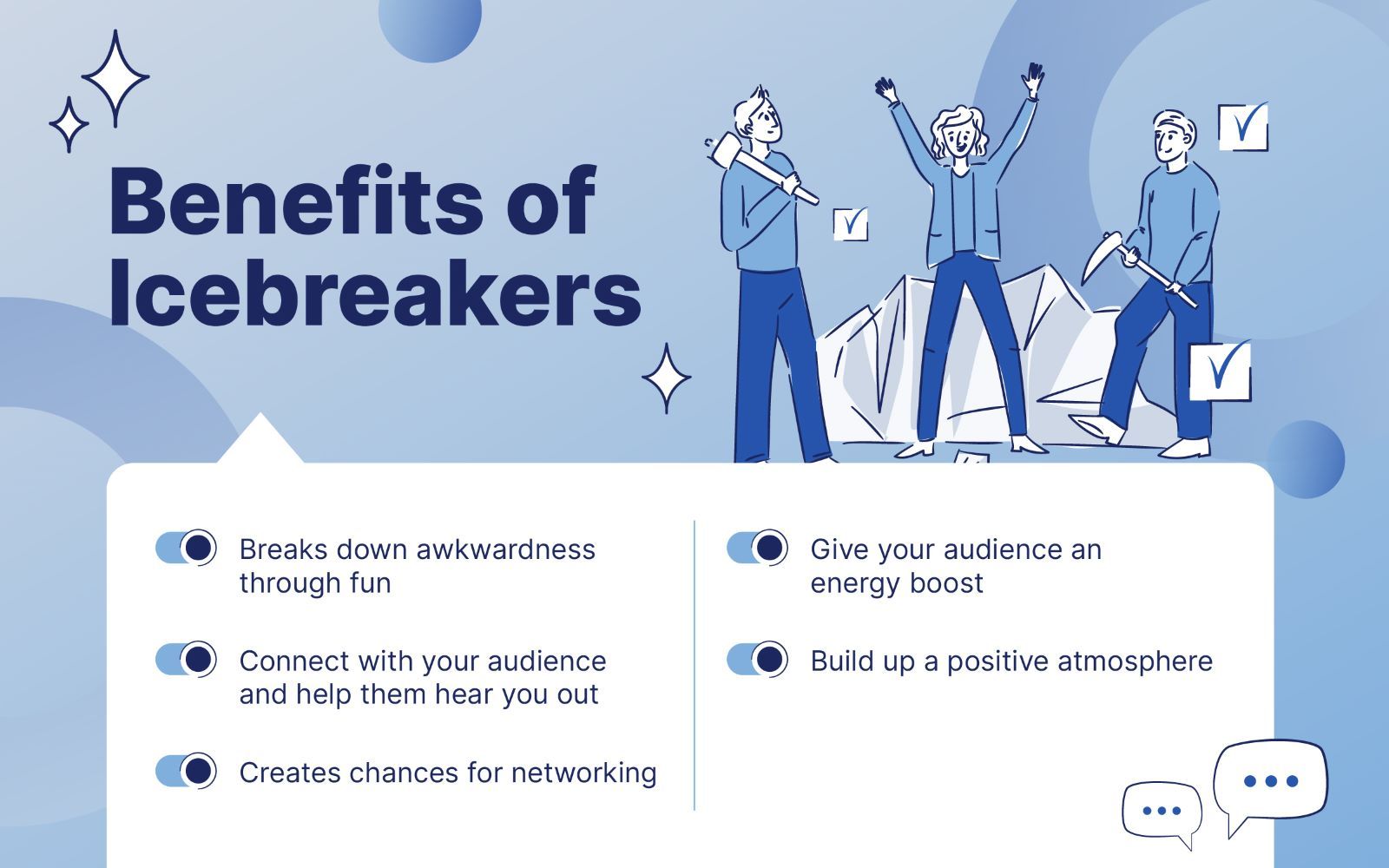
5 Practical Tips for a Good Icebreaker
What makes a good icebreaker? This is a tricky question to ask. Many icebreakers that work in certain situations will not work in others, as their use depends on context.
Here are key factors to consider when planning your next presentation’s icebreaker:
- Know your audience
Take the time to research your audience. The most important thing when planning your presentation’s icebreaker is to remind that you want your audience to feel less awkward — not more.
Taking your time to learn about the people in front of you is the easiest way to avoid doing or saying something that could potentially offend your audience. Even if you do it unintentionally, the damage will still be done.
- Identify your presentation objective
The right icebreaker will help you achieve your presentation objective, so take some extra time to think about it. For example, if you’re giving a presentation on cooperation and teamwork, you can do a game where your audience needs to rely on one another. Or conduct a poll to ask your audience how confident they are in their teamwork skills.
Making your icebreaker closely relate to your presentation’s topic will not only open up your audience but also allow you to transition smoothly to the rest of your presentation.
- Involve everyone
The icebreaker should be inclusive, meaning it shouldn’t exclude anyone from joining. For instance, if you have a disabled person in the crowd, then you wouldn’t want him or her to feel awkward for not being able to join.
Have a backup icebreaker just in case the first one excludes someone. The point is that fun icebreakers should make everyone feel more at ease — and not at the expense of the outliers of the crowd.
- Make sure you understand the context
To pick the right icebreaker for your presentation, you must know the overall setting in which it will take place. A presentation to the board of directors where you need to explain where the sales have been going down is probably not the best place to use a joke as an icebreaker. Or, if you’re giving a quick 15-minute presentation, you might not want to begin with a game that will take at least 10 of them.
Taking into consideration general setting cues like time frame, space and resources availability, and presentation tone, will help you pick the perfect icebreaker.
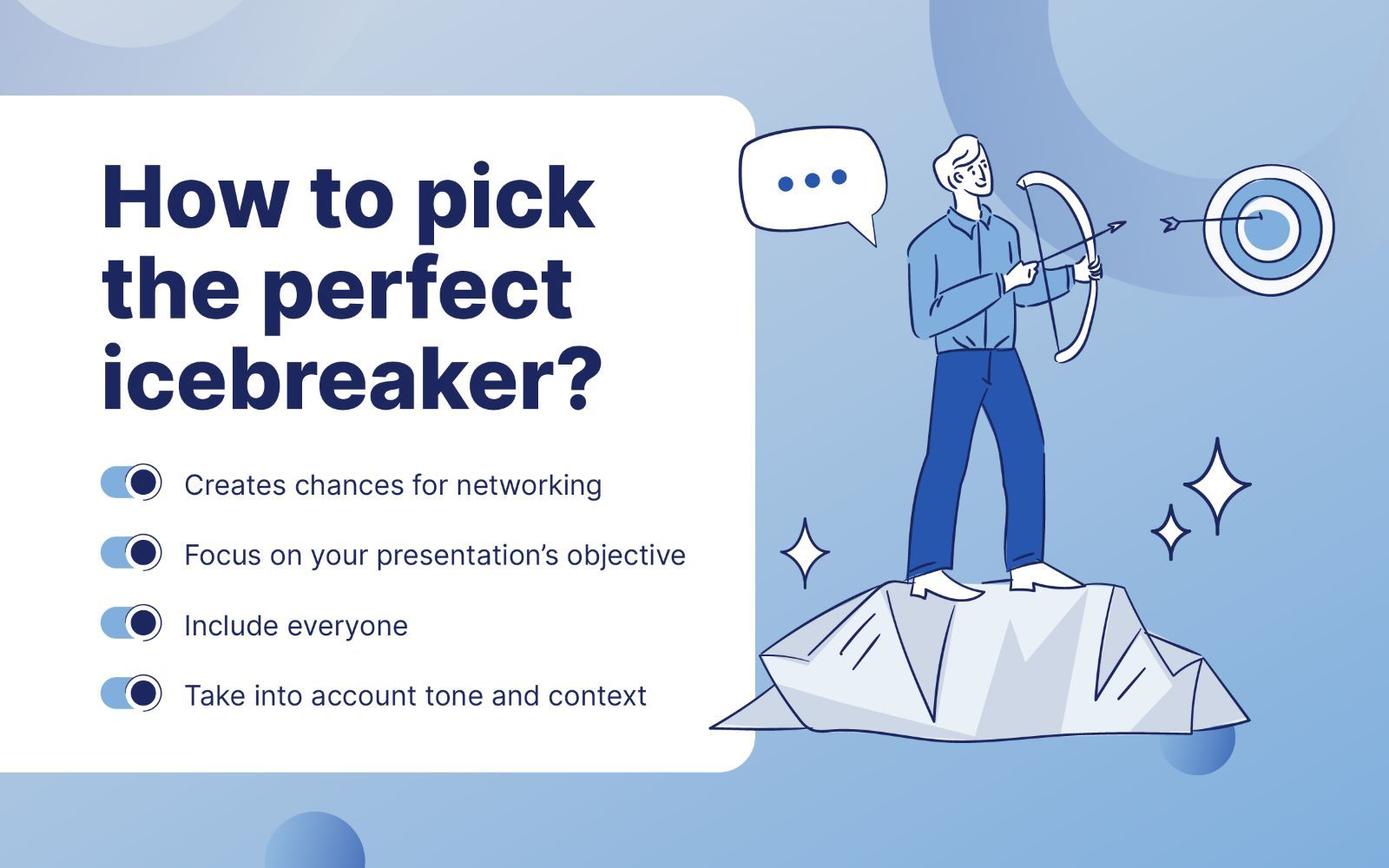
The Ultimate Presentation Icebreakers List
Here you’ll find the perfect icebreaker for your presentation. Since not every icebreaker will work on every situation, here you’ll find them divided into several categories:
- Icebreakers depending on your audience size
- Icebreakers depending on your presentation’s tone and context
- Quick and easy questions to break the ice
Do feel free to browse through the entire list: most icebreakers will be easy to adapt to fit your specific needs and your presentation!
Presentation Icebreakers for Every Audience Size
While in a small crowd, you might be able to ask person by person their input, this will most likely not be the case in large groups. On the flip side, a game that needs the audience to divide into teams might be a good pick for a medium-sized crowd, but not a one-on-one presentation.
Among the many options of icebreaker options all over the web, we’ve compiled and edited a list of which ones will work the best for each audience size:
- Introduce yourself. Unless you already know each other, introducing yourself is the easiest way to look proactive and get your presentation going. After all, it’s in your best interest for your prospect to warm up to you before your pitch or presentation!
- Have a conversation . Don’t go straight to your topic. Always warm up your prospects and engage them in conversation first. Try to ask open-ended (instead of just ‘yes’ or ‘no’) questions. You can tackle topics like current events, or even just the weather! Just talking in a more casual way will make the person feel more at ease and more likely to give you their undivided attention.
- Ask them about their personal life. If it’s someone you already know, build rapport by showing you care about them. You can ask about their kids, vacations, or even their favorite sports team. Remembering what they care about can be a huge plus when building a better atmosphere!
- Let them tell you what they expect from your presentation. It’s the easiest way to make sure you live up to your expectations! It also allows you to introduce the topics of your presentation seamlessly. Even better, you’ll feel and look more confident and under control by taking charge of the presentation’s rhythm and agenda.
- Ask something related to your presentation topic. Ask them if they know anything about your company, product, competitors, or something to that effect. It’s not only a great way to start your presentation without spending too much time on what they already know, but it’ll also help you gauge their knowledge so you can decide how in-depth you need to get in your presentation.
- Give them a small present just for showing up. Especially if the meeting is not an obligation for them, being appreciative if they show up can go a long way. After all, they’re investing their time and energy into you!
- Compliment them. It’s always nice to get compliments. But don’t overdo it, and always, always be genuine. If your prospect feels like you’re using flattery to get the sale, then it can seriously backfire on you later on. You’ll lose face and credibility.
- Introductions but with a twist. Ask everyone to introduce themselves and state something unusual or a fun fact about them. Towards the end of the presentation, ask them if they remember anything other people said during the introduction. If they get something right, reward them.
- Ask people to line up alphabetically . You can do this with their first names or last names. Or even their nicknames. This gets people talking and getting to know each other’s names.
- Charades . This is one of the best fun icebreakers on this list. It’s a party favorite but can also be used in presentations, meetings, and conferences. You probably already know how this works, but if not, here’s a funny charades video on Jimmy Fallon’s show.
- String a story together . Storytelling is a powerful element in presentations. But for this icebreaker, you’ll need everyone’s help to create a story. Start the first sentence yourself and then ask the first person in front of you to continue the story. Each person gets to decide the direction the story takes, one sentence at a time.
- Play word games . There are many different kinds of word games. But this is something you may find useful. Identify the subject or category the words should belong to, like animals or food. If the first person chooses ‘DOG,’ the next person must identify an animal that starts with the last letter of the previous word. In this case, it would be something that starts with the letter G, like GOAT.
- One word to describe him or herself . Give your audience one minute to think about the perfect word that describes them. And let the others assess if they agree with that word or not.
- Social media icebreaker . Let people open up their favorite social media accounts and then share a photo they’re most proud of. Ask them to share a line or two about why they love that photo.
- Switcheroo. Ask everyone to stand up and switch seats with the people in front of them. Do this when you notice people are starting to get drowsy and need some stimulation.
- Human bingo. This is a fun way to get to know people. Prepare the cards and the pen/pencil. The cards should already be filled out with various traits, characteristics, hobbies, etc. Then, your participants will need to go around and interview each person and check off a box that applies to them. The person who completes their card first gets a prize.
- Friendly debate. Group your participants into two. One should be the ‘pro’ group and the other is the ‘anti’ group. For instance, you can choose pizza lovers and pizza haters. Give them a few minutes to present their arguments and let the great debate begin!
- Two truths, one lie. Just like the title says, make your participants come up with 3 things about themselves, in which one of them is false. Then, in groups or pairs, the others would have to try and guess which one is the lie. It’s a great icebreaker to make your audience interact more with one another.
- Guess game. Just like the last one, it’s easier to make participants interact with one another through a game. Make everyone write on a piece of paper something fun, like an unlikely hobby or the oddest job they ever had. Your audience must try to guess who wrote which one. It’s not only a fun icebreaker, but it also helps people find out the things they have in common.
- Going to the beach. It’s an easy game, but a fun one! Each person will start by saying ‘I went to the beach and I took…’ plus an object, like a beachball, a towel, or a surfboard. Then, the next person must repeat the same sentence and add a new object to the list. The more people, the more the list will grow, and the first person who forgets an item loses! It’s also a good icebreaker for making attendees learn each other’s names by adding who brought what to part of the list they need to repeat.
- Paper planes. Make your audience write something about themselves on a piece of paper, and then instruct them to make a paper plane out of it and throw it! When they pick up a new paper plane, their goal will be to find the correct person. It’s the perfect icebreaker to get people moving and getting to know each other!
- Stretch. This one’s easy and straight to the point, but it does help break the boredom. Ask people to stand up and stretch for a few minutes. You can lead the exercise or play a short video on stage. After this short exercise, you can expect to see a bunch of awake and attentive faces.
- Treasure hunting. Hide a few prized items throughout the venue and send your participants on a treasure hunt. It’s always exciting to look out for a prize! Even better, by making them solve clues, you’d encourage your audience to work on their teamwork skills.
- Stress buster. Hand small slips of paper to everyone and ask them to write down the things that are causing them stress lately. Then, during or after the presentation, ask them to rip it to shreds.
- Snowball fight. Divide your group into two sides, and give each person 3 pieces of paper to crumple. Give them 1 or 2 minutes to try to get as many ‘snowballs’ into the other team’s side. A healthy amount of competitiveness will help you break the ice in no time!
- This or that. Another great icebreaker to highlight the things in common! Ask your audience to stand in the middle of the room, and ask them questions that will make them pick a side of the room. Things like ‘Dogs or cats?’ or ‘Night Owl or Early Bird?’ will have them jumping from one side to the other.

Icebreakers depending on your presentation’s tone
When planning your next icebreaker, you must always take into account the context of your presentation. After all, giving a sales report to your boss is not the same as giving a fun workshop on teamwork.
If you’re looking for the perfect icebreaker for a specific situation, here you might find the one you’re looking for!
If you’re looking for a more professional way to warm up your audience for your work presentations, these icebreakers are the one for you. Most business presentations are more serious and straight to the point, just like these icebreaker ideas!
- Storytelling. This one is the king of icebreakers for business presentations and for a good reason! Storytelling is an incredibly powerful tool to add to your presentations, as it helps to both exemplify your point and connect emotionally with your audience. And of course, this makes it the perfect option to break the ice and get their entire attention from the get-go.
- The highlight of the week. This icebreaker is great for getting your audience into a positive mood. When planning your next business presentation, take some extra time to find something good that happened that week or that month. Maybe you record sales for that month, or you got an exceptionally good review from a customer.
- Would you rather? When planning your sales presentation icebreaker, this one will help to get your potential customer right where you want it. Highlight the value they’ll get from your product, and how they are missing out on it. From our experience, asking, ‘What do you prefer, struggling 5 hours per week on PowerPoint, or getting your presentations done by a professional team of designers in 24 hours or less ?’ really puts things into perspective!
- Give kudos. The best way to put people in a good mood is to spread out some positivity! Giving the spotlight to someone who has done outstanding work recently can be a great way to break the ice.
- Brainstorming session. Group brainstorming is another great way to get people to exchange ideas. You hit two birds with one stone – an icebreaker and an idea generator rolled into one!
The best icebreakers for training presentations and workshops are those that incentivize teamwork and learning skills. These icebreakers will help your team get to know each other better and work together in tandem.
- Live polls. There are many apps that allow your audience to make live polls and display the results immediately. This is a great icebreaker, as it can be as serious or lighthearted as you want. You can use it to ask the audience’s mood, their favorite food, and how much they know about the topic at hand.
- Word cloud. Just like a poll, a word cloud can be a great option to explore what your audience thinks about a prompt or concept you give them and to get the ball rolling. You can make them write down in groups, have them add their ideas to a board, or even make one through an app !
- Problem-solution icebreaker. Present a real or hypothetical problem, and ask people to pitch in their solutions. You can ask them for their input individually, or you can divide them into pairs. As the saying goes, two heads are better than one.
- Finish a puzzle together. This is great for group work as everyone can contribute. For example, you can give them a few pieces each, and they’ll then work as a team to complete the puzzle.
- Pop quiz. This icebreaker is the best to keep your audience on their toes and on a learning mood. You can add it at the end of your presentation, before or after a coffee break, or even at the beginning to see how much previous knowledge your audience has.
Virtual presentation icebreakers
Not sharing a physical space can make breaking the ice even more of a challenge, especially since many icebreaker ideas would not fit an online presentation. So here you’ll find some icebreaker options that are specifically designed for virtual meetings!
- Drawing battle. You don’t have to be a professional artist to enjoy this one! There are many apps and websites that allow you to add this game to your virtual meetings. Just propose a topic and let people try to guess what one of them is drawing! You can even divide them into teams to make it more interesting.
- Try a virtual escape room. If you have time, try giving your audience this challenge to build cooperation and teamwork. It’s not only great for learning to work together but also to have fun and loosen up.
- Count till 20. Your team must try to count to 20 by shouting one number each… but without agreeing in which order they’ll go. This icebreaker will definitely make people wake up, and probably also laugh as they try to avoid talking at the same time.
- Emoji movies. Just like charades, your audience must try to guess the movie or book. But instead of someone acting, they must guess it from the emojis. It’s a great adaptation of a classic game for virtual meetings!
Fun icebreaker ideas for playful presentations
Icebreakers can also help your presentation be more playful and fun! If you like your icebreakers a little silly to make sure people loosen up their inhibitions, then take a look at these ideas.
- The no smiles challenge. If you’re making a fun, playful presentation, a great way to make it even funnier is to tell people smiling and laughing aren’t allowed in your presentation. This will most likely have the opposite effect, making people even more ready to laugh at your jokes!
- Human rock paper scissors. This is a fun, high-energy game, but may not be feasible for older participants. Check this video to see if this is something you can use in your presentation.
- GIFs mood barometer. If you want your audience to be a little bit playful, having them share their mood as a GIF is the perfect way. If you want to keep some control of what they share, you can also use a live poll to give them options to choose from. It’s the perfect lightweight activity that still gives you valuable insights into your audience and their energy levels.
- Bad jokes contest. The only thing funnier than a good joke is an extremely bad one. Have your audience try to use their best dad jokes on each other while avoiding laughing at the jokes of the rest.
10 Great Icebreaker Questions for Any Presentation
Sometimes simpler is better, and the easiest way to get people talking is to ask them to do so! These icebreaker questions will help your audience open up without taking much time or extra preparation.
- If you could have any superpower, what would it be, and what would be your superhero name?
- What's the most random piece of trivia you know and why?
- What is the oddest job you ever had, and how did you end up working there?
- If you could make a reality show, what would it be about?
- What cartoon character would you like to hang out with?
- Where is the most embarrassing place you ever fell asleep?
- If they made a sitcom about your life, what would the theme song be?
- What were the best and worst workshops/meetings/conferences you ever attended?
- If the zombie apocalypse began, what three people in this meeting would you want on your team?
- If you had to teach a class right now, what would the subject be?
As a speaker or presenter, it’s important that you prepare fun icebreakers for your audience. You want people to be comfortable not just with you, but with their neighbors and groupmates as well. The icebreakers in this list are just the tip of the iceberg concerning the wide array of possibilities you can choose from. Don’t be afraid to think outside the box and get creative with your icebreakers!
Need more time to prepare for your presentation? 24Slides has you covered!
Now that you’ve begun thinking about your presentation, and the best way to break the ice with your audience, you might wish to have more time to prepare for it. Luckily, 24Slides can help with that !
You can focus on your presentation’s content and how to make your audience as comfortable as possible, and 24Slides professional designers will tackle the visual aspects of it all. In less than 24 hours , you can get a custom-made, fully editable presentation that will wow your audience and make it even more memorable.
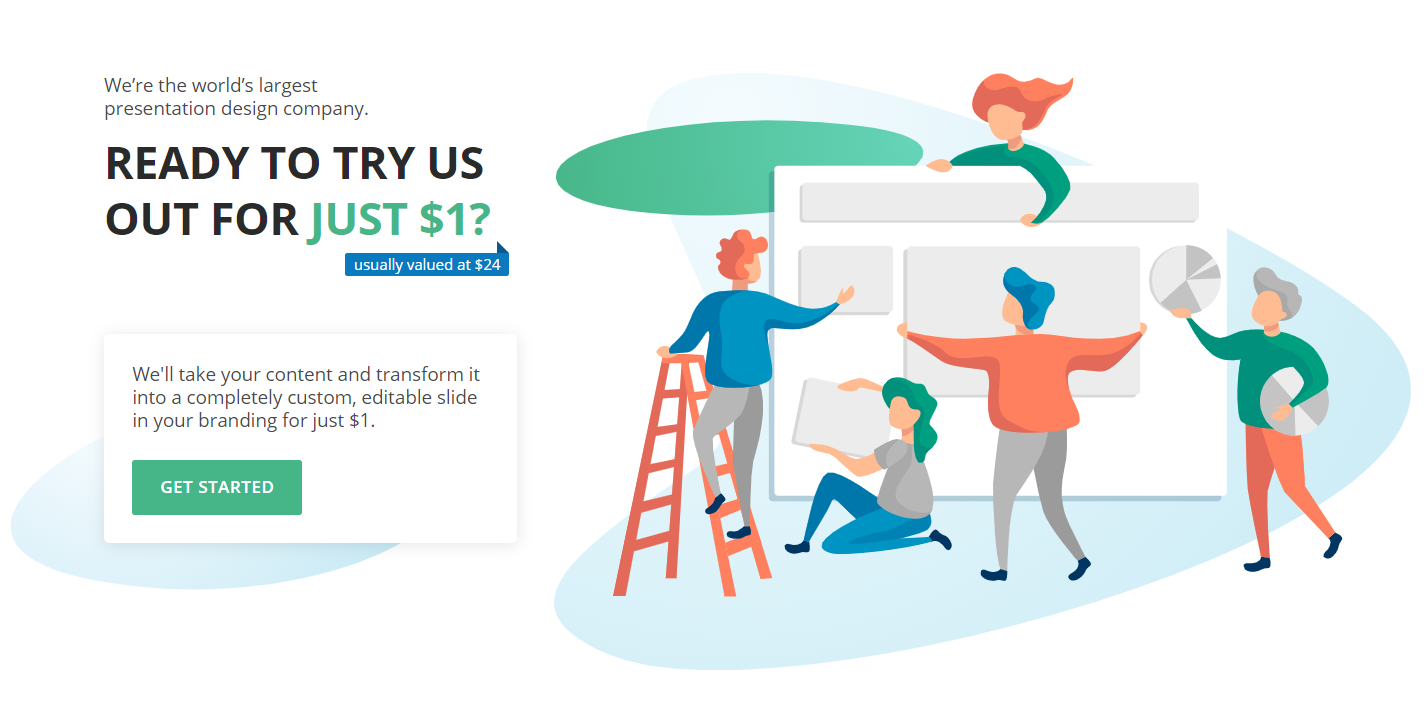
You might also find these articles interesting:
- 7 Essential Storytelling Techniques for Your Business Presentation
- How to Deliver the Perfect Online Presentation
- Improve Your Presentations' Body Language!
Create professional presentations online
Other people also read

6 Presentation Styles of Famous Presenters

How to create and deliver a powerful presentation introducti...

The seven worst presentations of all time and why they went ...

- Interactive Display
- Accessories
- myViewBoard
- Multi-touch Series
- Professional - VP Series
- Business - VG Series
- Home and Office - VA Series
- USB-C Series
- Home Entertainment
- Sports Viewing
- Installation
- Presentation Displays
- Direct View LED Display
- Pen Display
- ViewSonic Education Solutions
- ViewSonic Workspace Solutions
- Personal Display Solutions
- TeamJoin Meeting Solution
- ViewSonic Library & Blog
- myViewBoard Resources
- Case Studies
- Solution Briefs
- White Papers
- Press Center
- Knowledge Base
- Product Warranty
- Español ( Spanish )
- Deutsch ( German )
- Türkçe ( Turkish )
Education | Sep 21 2019
5 Interactive Presentations Ideas that will Engage Students
Interactive presentations should always be an educator’s goal. Dry, teacher-centered lectures lose students’ interest, while interactive presentations grab and hold attention. Getting students involved improves retention, understanding, and enjoyment. And it’s remarkably easy to involve the audience with just a few easy principles (especially with the right technology at your disposal).
Start creating interactive presentations with the tips and tricks below or get more insights on modern education technology.
Students today expect the classroom to be both educational and enjoyable at the same time. Interactive presentations help engage students by having them participate in the lessons instead of passively listening to lectures. This reduces boredom and gives students a sense of responsibility to be attentive.
A Gallup Poll of about 3,000 schools shows that around the 5 th grade 74% of students feel they are engaged in school, but by the 10 th , 11 th , and 12 th grade those numbers fall to the 30% range. It is important for educators from K-12 and on to higher education to recognize that keeping students engaged in the classroom is important and the adoption of interactive learning environments can be a key driver.
Millennials and Generation Y students are especially accustomed to being a part of the lessons and not just a spectator. Students are encouraged to talk and offer their ideas to create a collaborative atmosphere where both teachers and students are sources of knowledge and insight. The teacher plays more of a facilitator role in moving the lesson along and encouraging students to participate in their own learning outcomes. Students offer their own input, additional information, and give examples of how they would apply the key concepts.
The learning task is the central aspect of the interactive presentations (instead of the teacher’s energy level and hold on the students’ attention spans) and the lessons evolve around it. Even though the teacher is normally, the ‘presenter’ in most cases the ‘interaction’ part comes in a variety of ways to get students participating in the lesson. Many activities, games, role-plays, quizzes, and discussions can be integrated into the presentation flow and the lessons will take different directions from there. We will discuss later many examples of tools and techniques to encourage collaborations.
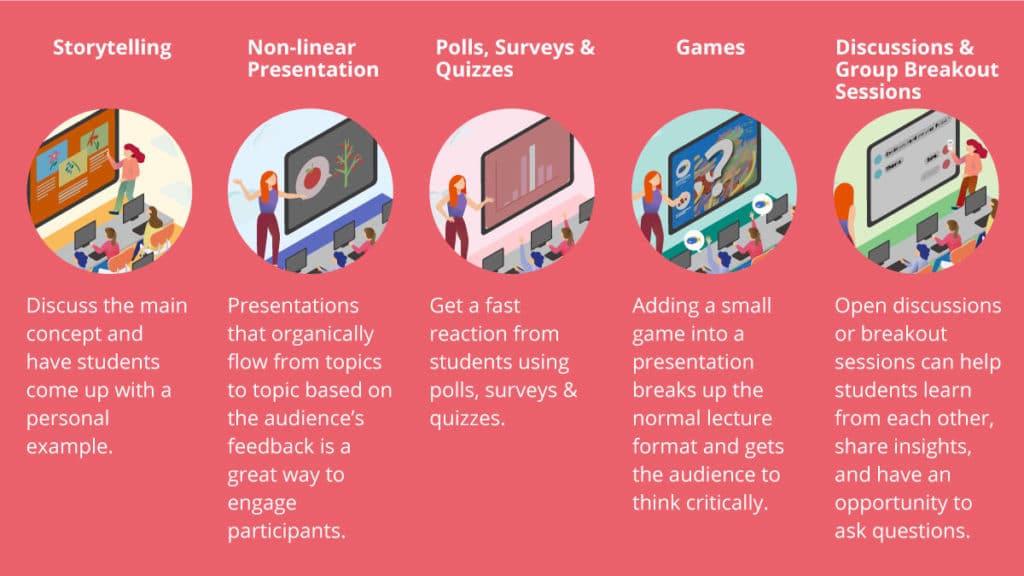
Technological Aid in Interactive Presentations
Although interactive presentations can be done without technology, it is greatly aided with the adoption of tools designed to facilitate the learning process. For example, a quiz is given in the middle of the presentation. On one side, traditionally a teacher can write the quiz before the lesson starts, print out copies for all students, pass out the quiz, and collect answers. To provide feedback for the exercise the teacher will also need to grade and start a discussion on the results before moving on to the next topic. This process is time-consuming and restrictive.
With technological aid such as an interactive digital whiteboard or a classroom quizzing application on individual devices, the students and teacher can come up with the quiz questions on the spot. This digital quiz can be administrated wirelessly to all students and within seconds, the results can be shared with all participants to discuss. This greatly increases spontaneity, variability, and class involvement.
5 Interactive Presentations Ideas and Corresponding Technology Aids

1. Storytelling
The teacher does not have to be the only star. The glory of the presentation can go to all participants who have a story to tell. The main concepts can be discussed and students should be given time to come up with a personal example. This exercise helps students relate to the subject matter and getting to listen to other students’ examples will drive home the concepts further. The need for the teacher to plan extensive examples and be the only one talking during the presentation is reduced. Teachers can also judge by the stories shared how much the students are understanding.
Storytelling with technology: Many digital whiteboards have Cast and Throw functions that will allow students to work on their own examples on their devices and send this to the whiteboard when sharing. This allows students to quickly go up and share their stories without sending files by email, wires, or USBs.

2. Non-linear presentation
Presentations that do not follow a strict order but organically flow from topic to topic based on the audience’s feedback are a great way to engage participants. Once prepared, the presenter can flow from one topic to the next by asking questions, polling, or receiving requests at the end of each key point. This allows the audience to ‘build’ their own presentation on what they want to hear not in a rigid manner as with traditional slide-based presentations.
Non-linear presentation with technology : There are non-linear presentation applications like Prezi which helps presenters build presentations on easy-to-customize templates. They offer a zoomable canvas (not slides) to help people share knowledge, stories and inspire audiences to act. The canvas shows relationships between points and offers a recommended flow but not a set path to follow.

3. Polls, surveys, and quizzes
One of the most recognizable and used tools in the classroom to get a fast reaction from students are polls, surveys & quizzes. For polls, simple questions that have limited answers are used to gather a consensus. This could be in the form of a raise of hands, ballots, or having students form groups. Surveys would require printed paper sheets with multiple choices, scales, or short answers to gather opinions. Quizzes are used to quickly test a student’s knowledge on what was just covered, so the class can identify weak areas and crystalize main concepts.
Polls, surveys, and quizzes can be anonymous or not. Openly requiring students to share their ideas on results such as a debate or open discussion would increase the interactives of the activity. Students can also be tasked to create questions and grade their own surveys and quizzes for an added layer of participation within the presentation.
Polls, surveys, and quizzes with technology : Many classroom management software such as Google Classroom has built-in tools to create polls, surveys, and quizzes along with assignments, communication, and other educational features. Once submitted, the collection and grading are instantaneous. The results can be shared easily with students both individually or as a group.
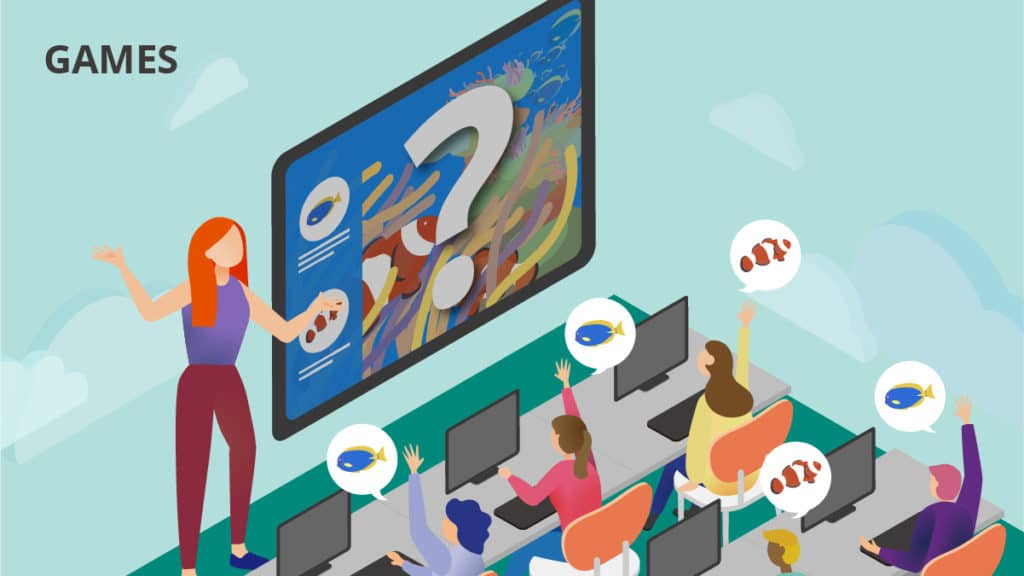
Is there a student – of any age – who does not like a good game, contest, or competition? Adding a small game into a presentation breaks up the normal lecture format and gets the audience to think critically to help their team win. There are many versions and adaptions of basic educational games . Teachers can take games such as Pictionary, Jeopardy, Casino, and Bingo then adapt them to their needs.
ViewSonic Originals
Free interactive teaching materials
Gamifying your interactive presentation : By integrating into the presentation links to applications like ClassCraft or Kahoot a teacher can quickly launch an interactive digital game. These applications help teachers tailor their own games by adding their questions, facts, and materials for individuals, small teams, or the whole class to participate.

5. Discussions and groups breakout sessions
Having the class only listen to a lecture marks the end of any interactive presentation. Adding sections where students can have an open discussion or breakout sessions can help students learn from each other, share insights, and have an opportunity to ask questions to their peers. It is also an opportunity for the teacher to take a break from talking and help small groups or students individually as the rest of the class converse.
Taking the discussion online for interactive presentations : Live discussion applications like NowComment allow students to markup and discuss a text in real-time which is great for peer-review activities and gather student input into one place quickly. Alternatively, Yo Tech is great for teachers to create and moderate real-time chat rooms. Students can send text-like messages, reply to other messages, and share pictures and drawings. Online chat groups are a great way for large groups of students to collaborate and interact in one place while keeping the noise level down in a classroom.
Tips for Creating Interactive Presentations
Here are some tips when creating a presentation that has interactive components:
Add in places within your lecture notes or presentation slides reminders for you to engage the audience. This could be a small image or phrase. When using digital whiteboards or other display technology you could also use a sound, empty slide, or pop-up link to prompt you to start.
Time Limits
It is great to keep going a good game or discussion in the class where everyone is really engaged. However, keep the maximum amount of time you can dedicate to these activities in mind. Have a watch or a timer on hand and keep things moving. Give enough time for students to get engaged without overdoing it. Spread out chances for students to talk and share. When it is time to move on to the next topic prepare a transition to the next part of the presentation.
Think of ways to let all students have a chance to share. You can select students randomly or have them take turns in some kind of order. Remind students that this is a learning activity and not everyone will get it right the first time. The interactive activity should be open and inclusive. Students who are introverted may be given activities that can be done without going to the front of the class or public speaking.
Benefits of Having Interactive Components in Your Presentation
- Retention: Actively having students engage with the concepts of the presentation in different ways and hearing it from different people (besides the teacher) helps with long-term retention.
- Personalization: Students are given the choice of where the presentation is heading and participate in their own learning outcomes.
- Fun: Having a break from the routine, getting a chance to move around, developing teams, and sharing are all much better than sitting silently and taking notes.
- Feedback: Adding interactive activities into a presentation gives you instant feedback about students’ comprehension.
- Vocalization: Having students actually vocalize their ideas helps them internalize the concepts.
- Summarization: Students review and summarize their own main points while doing the activities so there is less need for repetition.
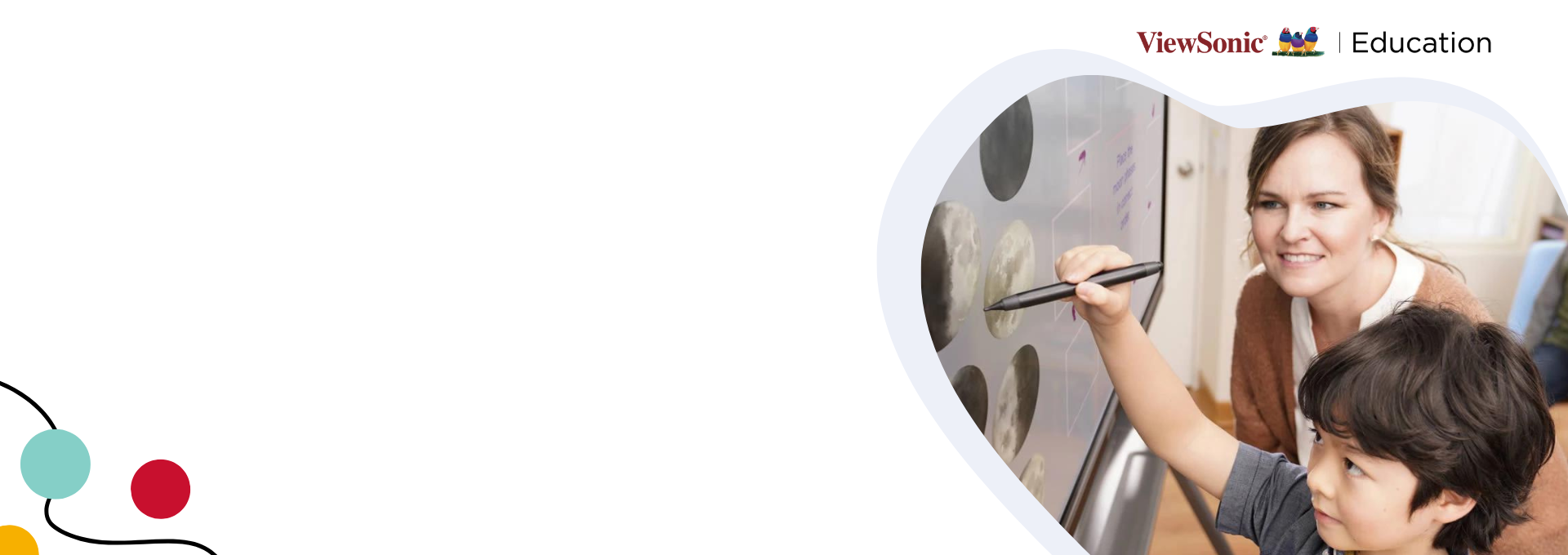
ViewSonic Education
Learning Solutions For the Future
Build Your Own Version of Interactive Presentations for Your Next Lesson
Bringing in the interactive components and increasing the engagement of your presentations will both help you – a teacher – and your students. Make presentations both educational and entertaining with Edutainment! With or without technology, consider incorporating some new ideas into your next interactive presentation.
If you liked reading this article, you might also want to explore our complete guide to technology in the classroom or gain more insights on engaging lessons with ViewSonic’s education solutions.
RELATED ARTICLES
Tech | Aug 12 2024
Strengthening Campus Safety: 3 Ways to Leverage Device Broadcasting
Discover how centralized device management systems can enhance campus safety by improving communication and emergency response times.
Technology in the Classroom | Aug 05 2024
Integrating Active Learning Spaces in Modern Classroom Design: 3 Essential Pointers
Discover how active learning spaces can transform classroom engagement and collaboration through flexible layouts and interactive tech.
Education | Jul 22 2024
Preventing Learning Loss Over Summer Break: How to Prevent the “Summer Slide” in Science
Explore fun ways to combat summer learning loss with science activities and challenges, using hands-on projects and online resources.
Technology in the Classroom | May 23 2024
Creating Modern Classrooms: 3 Contemporary Approaches to Classroom Design
Discover how modern classroom design transforms education with adaptable, inclusive, and sustainable spaces where every student can thrive.
SELECT YOUR REGION
Asia pacific & africa.

- What solution is best for me?
- Download the Government eBook

13 Interactive Presentation Ideas to Engage Students in Class
If you’re a teacher, you’ll know that there’s a lot to think about when you’re in class. It’s important to ensure that what you’re teaching the children is as educational and as interesting as possible - with the aim of engaging the students in the subject and hopefully even enabling them to enjoy learning!
This can be a very difficult balance to strike. However, it’s made easier by these interactive presentation ideas listed in this article, which can engage even the most distracted of students!
How to display presentations
The best classroom gadget to show these presentations on is an interactive display. These are large devices that are mounted to the wall and can connect seamlessly with any video collaboration applications. You can connect interactive displays to the internet and further use them as a powerful classroom teaching tool, to help students learn in a fully interactive and efficient way. We sell interactive displays for classrooms here at Avocor.
Interactive class presentation ideas
Ice breakers.
Many work-related presentations start with an icebreaker, and there’s no reason why a presentation to a class of students should be any different.
The icebreaker question will depend on the class and age of students, but could be something like the following:
- If you could be an animal, what would it be and why?
- What would be your dream place to go on holiday?
- If you could have dinner with three historical characters, who would they be and why?
- If you could make any kind of potion, what would it do?
Incorporating video is one of the best interactive presentation ideas for students. Even if the video is about the same topic as the presentation, the fact that it’s a different type of media will interest the class.
You can either find a suitable video on YouTube or another video software or, if you have a file saved, paste it directly into the presentation .

Questions and answers
Questions and answers are a great way to get the whole class involved. You could invite one student to ask a hypothetical question about the topic, and another could answer.
For example, if you’re learning about Henry VIII and his six wives , you could ask a student to ask a question about them. Their question could be “what was Henry VIII’s favourite food?” or something similar.
When another student answers, you could ask them to explain their answer - for example, if they say “meat and bread”, they might carry on to explain that that was the main diet for royalty at the time.
Songs are a good way to interest younger kids in a topic. You can find songs about all sorts of subjects on YouTube. For example, this seven continents song could be suitable for a Geography song.
Many songs on YouTube have lyrics, so you could encourage your class to practice their reading as they sing along.
Some presentations are made more interactive by external objects - and if you want to engage younger kids, bringing some props can really help the lesson to come alive.
For example, if you’re doing a history lesson about the Ancient Egyptians , you could bring some figures of Tutankhamun, the Sphinx and the ancient pyramids for everybody to see.
Class involvement
Asking for direct class involvement throughout the presentation is a good way to ensure that students stay engaged. For instance, if you’re doing a presentation about animals, you could ask students to make a noise every time you mention a certain animal.
You could ask them to roar each time you mention lions, or make a monkey noise each time you talk about monkeys. This is a great way to ensure that the students are paying attention!
Transitions and animations
A simple way to ensure that your students are paying attention is to use different transitions and animations throughout your presentation.
If you’re teaching older kids or teenagers, you might not want to have too many of these, but younger kids will love seeing every item bounce onto the screen. It’s a wonderful way to get them interested in technology in the classroom !
Quizzes are an effective way to engage students of any age. You can include these at the end of the presentation and they can include questions that you’ve covered in the session.
If your students know that there will be a quiz at the end of the class, they may be more likely to pay attention throughout it! You could also ensure maximum engagement by telling students that there will be prizes for the winner of the quiz - such as stickers or sweets.
Interactive games
Interactive games for class presentations are always a popular way to ensure that students stay engaged! Some examples include:
- noughts and crosses or tic tac toe
- pictionary
- hangman or an alternative like spaceman
- 21 questions
It’s best to make these games related to the subject. For example, the game “21 questions” involves you thinking of a character and students asking questions with a yes or no answer about what character you are.
If you’re teaching a history class, the character could be somebody from history (such as Florence Nightingale or Queen Victoria), or if you’re instructing a science lesson, the character could be a famous scientist (like Einstein or Steven Hawking).
Brainstorming
Brainstorming is another great way to get the class involved. You can use an interactive display to create the brainstorm diagram on. Students can take turns writing on the board, and it can securely connect to any external devices, so any remote class members can join in.
With an interactive display, you can also immediately share the diagram to the rest of the class once it’s finished, so they can keep it to refresh their knowledge of a topic.
For example, if you’re teaching your class about Australia in geography , you could ask their students what they may already know about Australia. They could come up with some items like the following:
- Sydney Opera House
- Aboriginal art
- outback
You could then create a spider diagram with different legs depending on the topic. For this list, there could be an “animals” leg for kangaroos and koalas, an “architecture” leg for the Sydney Opera House, a “landscapes” leg for the rainforest and outback, a “culture” leg for Aboriginal art and a “food” leg for BBQ.
Make a story
Making a story about the topics covered can encourage creativity around the topic. To do this, write down a couple of opening lines to a story related to the topic that you’re teaching.
For example, if you’re teaching students about the Ancient Roman Empire, you could start by saying “Ronald the Roman lived in the British City of Bath, where the Romans had arrived 20 years before. He spent most of his time at work, where he built houses for the rest of the Romans”.
Then, you could invite a student to continue the story, encouraging them to stay as on-topic as possible. You could even give out a prize to the student with the best part of the story. Depending on the size of the class, you could ask every student to contribute.
Stories also work well for English lessons. In these classes, the topic of the story doesn’t matter as much, but you could encourage students to use whatever language they’ve been learning.
For example, if your class has been focused on adjectives, you could ask students to put as many adjectives as possible in each part of their story.
Have a short play
You could take your stories to the next level by creating a short play on one of your slides. This could be based on whatever topic you’re learning about, and you could select a few students to come to the front of the class and read out the lines.
You may wish to create this personally, find a relevant play online or you could even turn a well-known story into a play!
Virtual field trip
One of the most creative interactive school presentation ideas is to take the class on a virtual field trip. This is particularly valuable for geography lessons, where you may learn about places that students might not be able to visit in person, like the Amazon rainforest or even under the sea!
You could link to Google maps, where you could use Google Earth to explore a particular area. Alternatively, there are some YouTube channels that specialise in virtual tours and field trips, such as this one which details all you need to know about rainforests .
If you have a classroom full of students and want to keep them as engaged as possible while teaching them new material, try some of these interactive games for classroom presentations and other ideas!
By incorporating some of these interactive ideas into your presentation, you’ll have the students’ full undivided attention and ensure that they not only enjoy the class but retain the information.
Related Articles
9 tips for effective interactive workplace communication, flexible working advantages: 7 key benefits for your business, how to create a flexible working environment: ultimate guide, interactive wall ideas for offices: how to decorate for inspiration, what does the future of flexibility at the workplace look like, get in touch, sign up for our newsletter.
Keep up to date with all the latest from Avocor and partners and get information on upcoming events and exciting product news.

Latest Updates
Useful links, ready to talk.
To provide the best experiences, we and our partners use technologies like cookies to store and/or access device information. Consenting to these technologies will allow us and our partners to process personal data such as browsing behavior or unique IDs on this site and show (non-) personalized ads. Not consenting or withdrawing consent, may adversely affect certain features and functions.
Click below to consent to the above or make granular choices. Your choices will be applied to this site only. You can change your settings at any time, including withdrawing your consent, by using the toggles on the Cookie Policy, or by clicking on the manage consent button at the bottom of the screen.
Top 10 Presentation Games for Large Teams
A large audience. Difficult topics. For many speakers, it is difficult to keep their attention on the talking topics during a presentation to a large team or audience. As a result, it is common for people to slip into passive listening mode and grab their smartphones. They simply stop paying attention to your presentation. Interactive games for group presentations can help keep the audience focused. In this blog we will give you a top 10 presentation games to help you keep their attention when you are presenting in front of a large group of people. From a simple game where all the audience has to do is raise their hand, to an interactive presentation game that will help you gain new insights. Choose one or more and find out which presentation game works best for your audience.
Key Takeaways:
- Engage audiences with interactive games like 'Elimination' and 'Assumptions' to start presentations dynamically.
- Incorporate audience content choices using 'Topic of the Day' for tailored discussions.
- Utilize practical application games like 'Bring into Practice' for theory reinforcement.
- Encourage creativity and networking with 'Duo Assignment' and 'Sing & Swing'.
- Maintain attention with end-of-presentation quizzes and the humorous 'Phone' game.
- Leverage Sendsteps for interactive polls and enhanced presentation engagement.

1. Elimination game
This game will introduce you to the audience. A fun idea to start any presentation with.
How it works: Have everyone in the audience stand up. Then display on the presentation screen statements where the answer will determine wheter the audience must sit down. For example, are you speaking at a conference that has already taken place several times? Then start with: "Sit down if this is your first time attending this conference." You can then filter the audience by asking follow-up questions such as: "Sit down if you have attended this congress 3 times." Continue until a few are left.
2. Topic of the day.
You can let some of the content of your presentation be determined by the audience. By asking them beforehand what they think is an interesting topic, you adapt the presentation in no time, to their interest which will make them listen even more attentively. Such short games for presentations are easy to implement, but have a great effect.
How it works: At the beginning of your presentation, show three related topics on the screen. For an entertaining presentation, these can also be unexpected words that have relatively nothing to do with the topic. The audience votes through an online poll which topic or word the speaker should cover in the final presentation.
3. Assumptions
You can run the first game in a similar form with statements.
How it works: First, the whole audience stands up. Show statements on the screen and ask the public to raise their hands when they think a statemwnt is correct, and not to raise a hand when it is incorrect. If their answer is wrong, they should sit down. Continue until there are one or a few participants left and reward them with a big round of applause from the audience or even more fun: an appropriate prize.

4. Fill Gaps
With this game, you kill two birds with one stone. You will keep the interest throughout the presentation and the audience will leave with the most important knowledge points.
How it works: Make a spreadsheet containing one or more key sentences from your presentation. One word is missing from each sentence. Before the presentation, put a workpaper on each chair. Ask the audience to fill in the missing words as they listen and give the correct answers at the end of the presentation.
5. 30 Seconds
Who doesn't love the game "30 Seconds"? In the category of audience games during presentations, this game is easy to play. The time pressure also boosts the enthusiasm of your audience.
How it works: Invite one person to come forward. He or she will stand with his or her back to the screen. Now show a picture on the screen showing an object or familiar person related to your topic. The participant may now ask the audience "yes or no" questions about the image for 30 seconds and try to guess. Set a timer for this. After 30 seconds, is the correct answer still not given? Then the participant may take one more guess. Tip: Double the time when the answer is harder to guess.
6. Bring into practice
Are you giving a presentation in which a lot of theory is discussed? Then it is useful to bring the knowledge into practice. This way you give your audience a chance to think about what they have learned and how they can apply it.
How it works: In a presentation on writing persuasive content, useful tips can be given for writing a catchy title. Listeners usually take notes on what factors are important here, but none of them have written a title based on this. On the screen, show 3 titles that are slightly different from each other, one of which is completely correct based on the theory. Have the audience vote for the correct answer via an online poll on their smartphone and show the results. Then discuss which answer is right or wrong and why.

7. Duo assignment
Participants in a large audience most likely do not know each other. With this game you can easily introduce them and exchange useful information at the same time.
How it works: In a presentation about a new product, you can assign your participants to come up with a name for the product. Have everyone come up with one name. Then they discuss it with their neighbor. Together they choose the best one. The speaker then assigns each pair to speak up their made-up name out loud. With a group of 30 people, this is feasible; with a larger audience, a few pairs can be formed.
8. Sing & swing
Singing is healthy! It gives energy and it puts your audience in a positive flow. Ideal when a presentation is long.
How it works: Rewrite the lyrics of a popular song and show it on the presentation screen. For example, take the chorus and replace it with a few phrases that are the essence of your presentation. Invite the audience to sing it with you. Even more fun presentation game ideas: for extra fun, add a simple choreography, for example clapping or waving your hands.

9. Quiz game
A quiz is an often used but very effective interactive presentation game. Announce in advance that a quiz game will be played at the end of the presentation. This keeps the audience paying attention throughout the presentation.
How it works: Ask about 10 questions and make it interesting by alternating between [multiple choice](/en/questions/multiple choice/), 'right or wrong' questions and 'yes and no' questions. Display these on the screen and let the audience answer with an online poll. Show the scores after each question. This encourages competitiveness in your audience!
Often attention drifts away at the end of a presentation, especially when there are questions from the audience. With this game, everyone pays attention to each other's questions.
How it works: Have all listeners sitting at the left end of the rows think of a question for the speaker. They whisper this question into the ear of the person sitting next to them. The question is whispered through to the person at the other end of the row. The people at the right end of each row may now ask the question out loud. Chances are, the question is nothing like the one initially thought of. This can produce hilarious moments!

Interactive presentation games with Sendsteps
The above mentioned games for presentations will make every presentation a true success. Get started and try out an online poll with your audience. Use our free tool and start presenting interactively right away. Not sure which presentation game is right for your presentation? Then please contact us. We are happy to give advice on how you can increase interactivity with your audience. In addition, Sendsteps offers even more smart features to deliver a perfect presentation.
Related Blogs

How to Create Stunning Presentations with AI?

How to Create Engaging and Educational Quizzes

Exploring the Future of Online Quizzes with AI Technology

AI Presentation Makers A New Tool for Educational Success

How to Engage Your Audience with an Innovative AI Quiz Creator

The Impact of AI Quiz Tools on Data Collection and Audience Insights
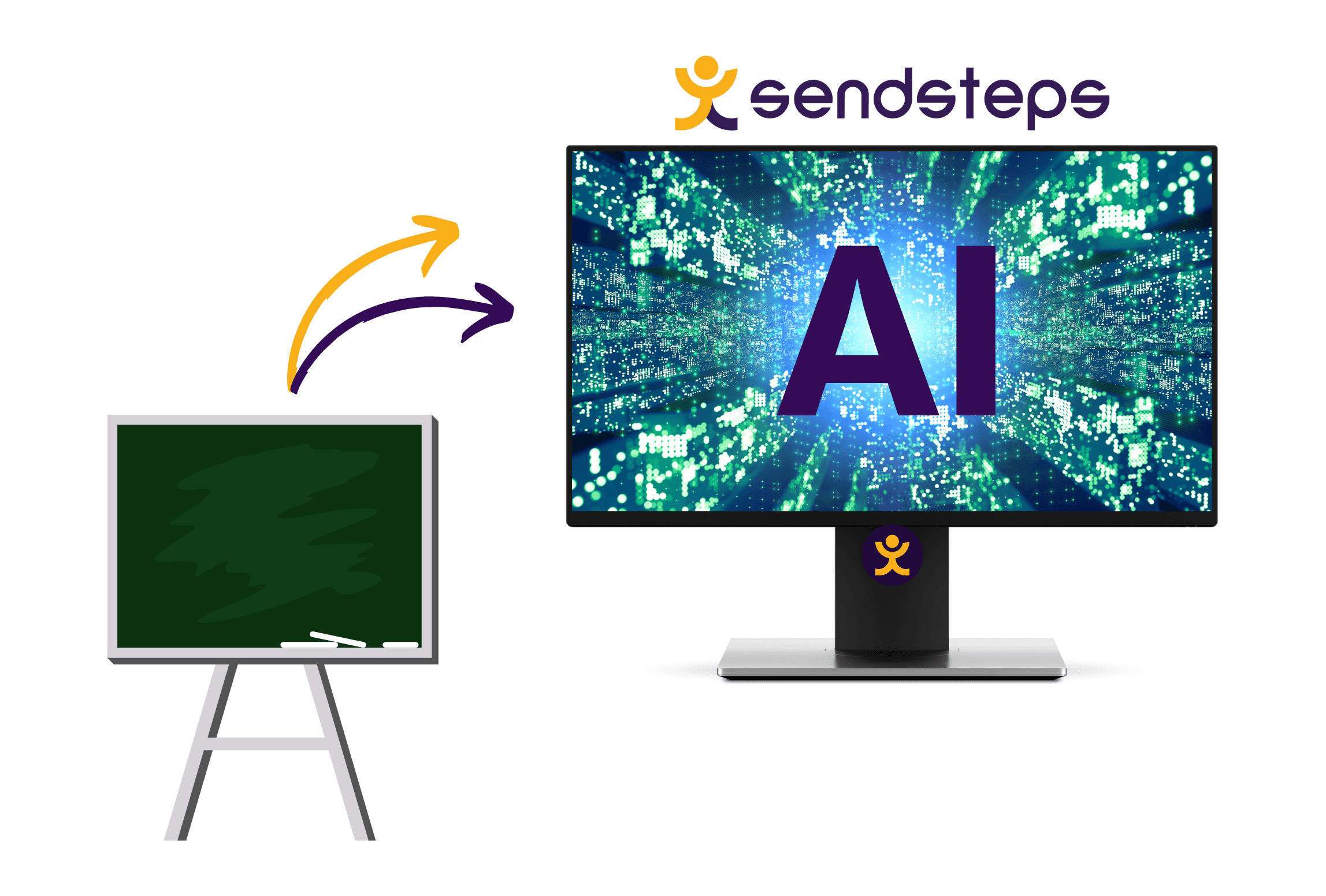
The Benefits of AI-Powered Presentation Makers in Education
Leveraging ai for fun and engagement innovative uses of quiz generators.

Exploring the Top 5 AI Quiz Makers: Revolutionizing Knowledge Assessment
What are effective presentation games for large teams, and how do they enhance audience engagement.
Effective presentation games for large teams include 'Elimination', 'Topic of the Day', 'Assumptions', 'Fill Gaps', and '30 Seconds' for dynamic interaction. These games keep the audience engaged, encourage participation, and make complex topics more approachable. 'Bring into Practice' and 'Duo Assignment' stimulate practical application and creativity, while 'Sing & Swing', a quiz game, and the 'Phone' game ensure ongoing attention and fun. These games, especially when combined with Sendsteps for interactive polling, significantly enhance the overall engagement and effectiveness of presentations for large audiences.
How do games enhance team-building and collaboration in a large group setting?
Games in a large group setting enhance team-building and collaboration by providing a shared experience that breaks down barriers and encourages open communication. They create a fun and relaxed environment where team members feel comfortable interacting and working together.
What strategies can be used to ensure that all team members are engaged and participating in the games?
To ensure all team members are engaged in the games, it's important to choose inclusive activities that cater to diverse interests and abilities. Facilitators can also actively encourage participation and create small groups within the larger team to ensure everyone is involved.
How can the effectiveness of these games in achieving presentation goals be evaluated or measured?
Measuring the effectiveness of these games can be done through feedback surveys, observing the level of engagement during the games, and assessing the improvement in team dynamics and communication post-activity.

Roksanna van Dam
Roksanna works as an intern and mainly focuses on making content and the company's socials. Roksanna loves to teach herself and her audience new discoveries and has a creative mindset, which she combines with her work to create unique, fun, relevant blogs and templates.
- Alternatives
How to Make a Presentation Interactive | 7 Great Ways
Lakshmi Puthanveedu • 29 July, 2024 • 11 min read
Are your presentations putting people to sleep faster than a bedtime story? It’s time to shock some life back into your lessons with interactivity🚀
Let's defibrillate “Death by PowerPoint” and show you lightning-quick ways how to make a presentation interactive .
With these tips, you'll be able to activate that dopamine drip and get butts in seats leaning in - not delving deep into the chairs!
Table of Contents
What is an interactive presentation.
- Why Use an Interactive Presentation?
#1. Create icebreaker games🧊
- #2. Make use of props 📝
#3. Create interactive presentation games and quizzes 🎲
#4. tell a compelling story, #5. organise a brainstorming session, #6. make a word cloud for the topic, #7. bring out the poll express, easy interactive activities for presentations, more presentation examples you could learn from.
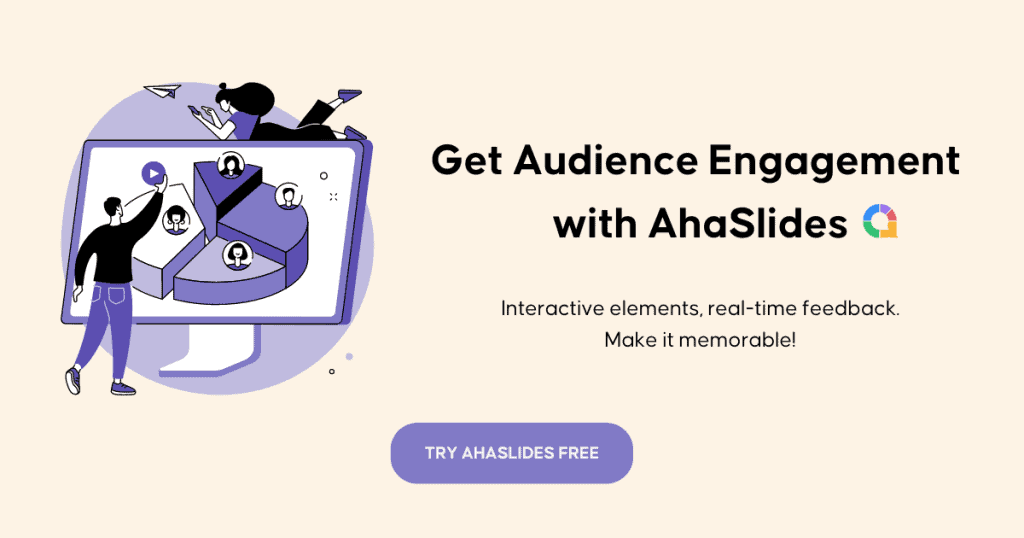
Keeping your audience engaged is the most critical and challenging part, regardless of the topic or how casual or formal the presentation is.
An interactive presentation is a presentation that works two ways. The presenter asks questions during the production, and the audience responds directly to those questions.
Let's take an example of an interactive poll .
The presenter displays a poll question on the screen. The audience can then submit their answers live through their mobile phones, and the results are immediately displayed on the screen, as shown in the image below. Yay, it's an interactive slide presentation .

Making an interactive presentation does not have to be complex or stressful. It’s all about letting go of the static, linear presentation format and using some tools and techniques to create a personal, more involved experience for the audience.
With software like AhaSlides , you can easily create interactive presentations with tons of interactive quizzes, polls, and live Q&A sessions for your audience. Keep reading to find out fired tips on how to make a presentation interactive 👇
Why Interactive Presentation?
Presentations are still one of the commonly used methods to pass on information. Still, no one likes to sit through long, monotonous presentations where the host doesn’t stop talking.
Interactive presentations can help. They...
- Increase audience engagement , allowing them to connect with you and the purpose of the presentation. 64% of people believe a flexible presentation with two-way interaction is more engaging than a linear one.
- Improve retention capacity . 68% say that it’s easier to remember the information when the presentation is interactive.
- Tips: Use a rating scale to gather feedback !
- Act as a break from the routine and allow participants to have an enjoyable experience.
How to Make a Presentation Interactive
Whether you are hosting a virtual or offline presentation, there are many ways to make presentations interactive, exciting and two-way for your audience.
Starting a presentation is always one of the most challenging parts. You are nervous; the audience might still be settling, there might be people not familiar with the topic - the list could go on. Get to know your audience, ask them questions about how they are feeling and how their day was, or maybe share a funny story to get them hooked and excited.
🎊 Here are 180 Fun General Knowledge Quiz Questions and Answers to gain better engagement.
#2. Make use of Props 📝
Making a presentation interactive does not mean you have to let go of traditional tricks of engaging the audience. You could bring a lighting stick or a ball to pass around to the audience when they want to ask a question or share something.
Games and quizzes will always remain the star of the show, no matter how complex the presentation is. You don’t necessarily have to create them related to the topic; these could also be introduced into the presentation as fillers or as a fun activity.
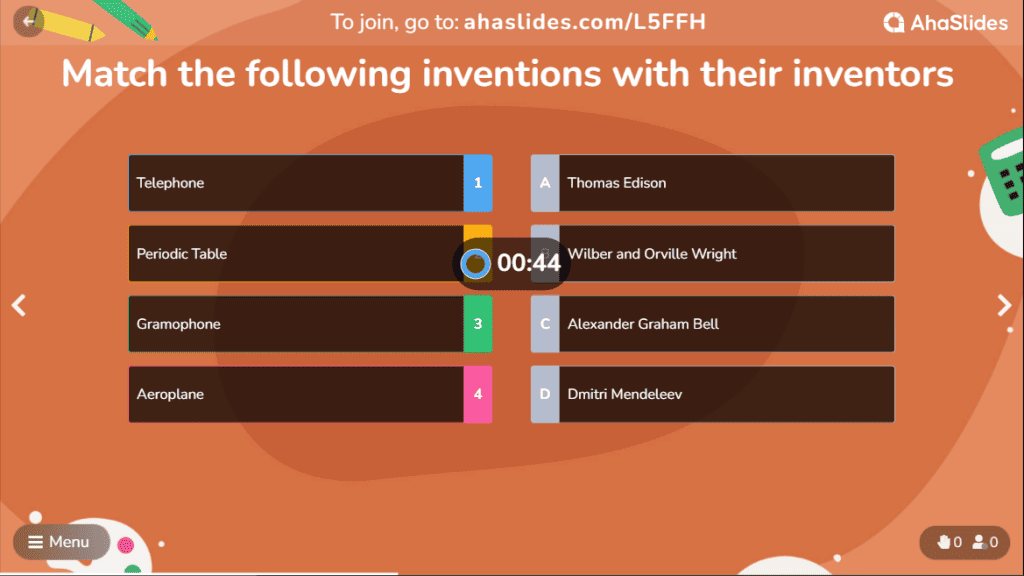
💡 Want more? Get 10 interactive presentation techniques here!
Stories work like a charm in any situation. Introducing a complex physics topic? You could tell a story about Nicola Tesla or Albert Einstein. Want to beat the Monday blues in the classroom? Tell a story! Want to break the ice ?
Well, you know… ask the audience to tell a story!
There are many ways you could use storytelling in a presentation. In a marketing presentation , for instance, you can create empathy with your audience by telling an engaging story or asking them if they have any interesting marketing stories or situations to share. If you're a teacher, you could pitch an outline to the students and ask them to build the rest of the story.
Or, you could tell a story till just before the ending and ask the audience how they think the story ended.
You’ve created a stellar presentation. You’ve introduced the topic and are mid-way through the exhibition. Wouldn’t it be nice to sit back, take a break and see how your students put some effort into taking the presentation forward?
Brainstorming helps get the students excited about the topic and allows them to think creatively and critically.

💡 Get an engaged class with 6 more interactive presentation ideas
Want to make sure your audience gets the concept or topic of the presentation without making it feel like an interrogation?
Live word clouds are fun and interactive and ensure the main topic is not lost in the presentation. Using a word cloud free , you can ask the audience what they think is the main topic for the production.
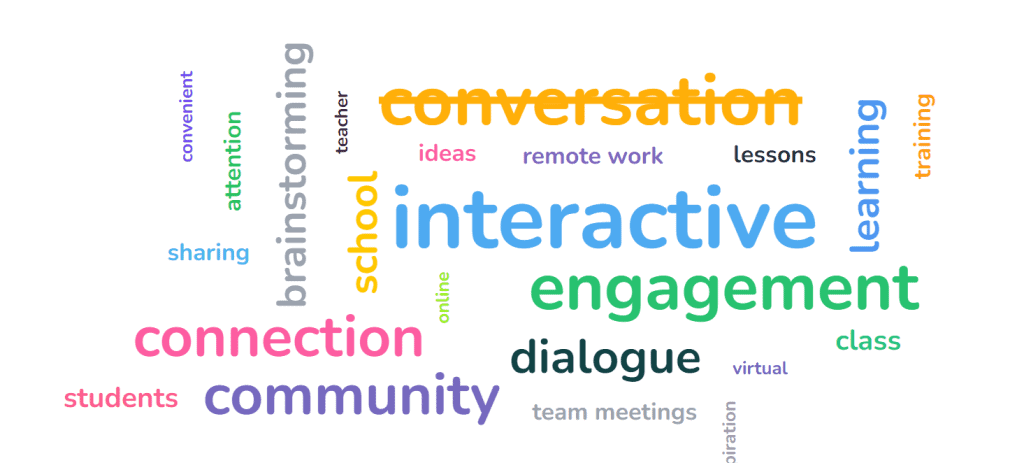
How do you feel about using visual aids in your presentation? It's not anything new, right?
But what if you can merge funny pictures with an interactive poll? That's got to be interesting!
“How do you feel right now?”
This simple question could be turned into an interactive fun activity with the help of images and GIFs describing your mood. Present it to the audience in a poll, and you could display the results on the screen for everyone to see.
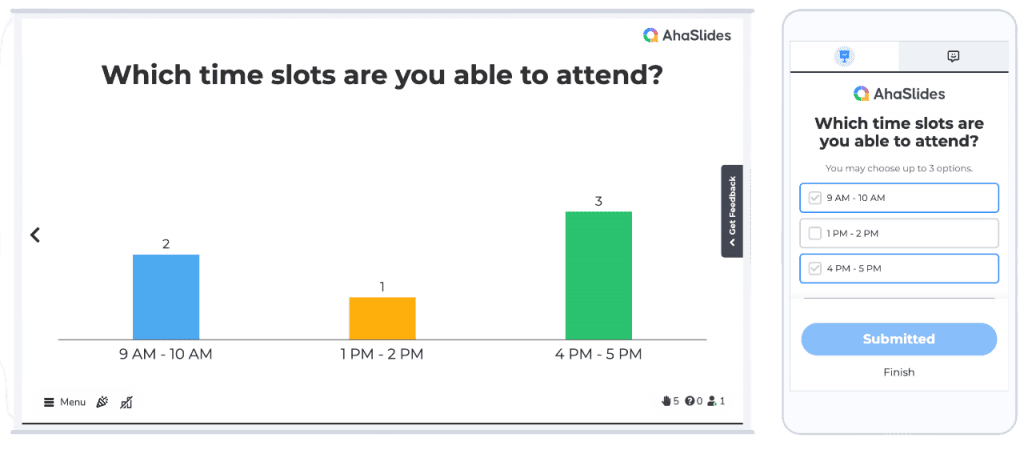
This is a great, super simple icebreaker activity that can help revitalise team meetings, especially when some folks are working remotely.
💡 We've got more - 10 interactive presentation ideas for work .
Whether you’re hosting something for your colleagues, students or friends, retaining their attention for a while can be a daunting task.
Games such as What Would You Do? and 4 Corners are easy interactive activities to help the audience get back on track with your presentation …
What Would You Do?
Isn’t it interesting to know what someone would do in a particular situation or how they would handle it? In this game, you give the audience a scenario and ask how they would deal with it.
Say, for example, you are having a fun night with your friends and family. You could ask questions like, “What would you do if you could be invisible to the human eye?” and see how they handle the given situation.
If you've got remote players, this is a great interactive Zoom game .
This is a perfect game for anyone with an opinion. It’s a great way to start a conversation on your presentation's topic before diving into the meat of it.
You announce a statement and see how everyone feels about it. Each participant shows how they think by moving to one corner of the room. The corners are labelled ‘strongly agree’, ‘agree’, ‘strongly disagree’, and ‘disagree’.
Once everyone has taken their place in the corners, you could have a debate or discussion between the teams.
🎲 Looking for more? Check out 11 interactive presentation games !
The 5 Best Interactive Presentation Software
Making a presentation interactive is so much easier with the right tool.
Many interactive presentation websites let your audience respond directly to the content of your presentation and see the results on the big screen. You ask them a question in the form of a poll, word cloud, brainstorming or even a live quiz, and they respond with their phones.
#1 - AhaSlides
AhaSlides presentation platform will let you host fun, interactive presentations for all your needs, with quizzes, live Q&As, word clouds, brainstorming slides, and such.
The audience can join the presentation from their phones and interact with it live. Whether you are presenting to your students, a businessman who wants to hold team-building activities, or someone who wants to have a fun quiz game for your friends and family, this is a great tool you can use, with a ton of fun interactive options.
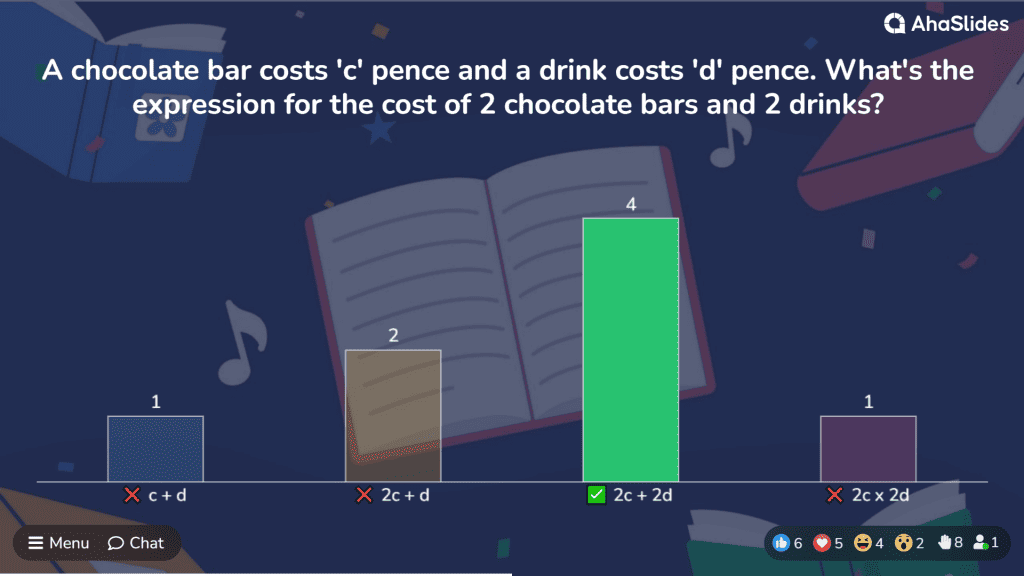
If you are looking for ways to boost your team’s creativity at your workplace, then Prezi is an excellent tool.
It is a bit similar to how a standard linear presentation would be but more imaginative and creative. With a huge template library and many animated elements, Prezi lets you create a cool, interactive display in no time.
Although the free version does not come with many features, spending a little on the tool is worth it to create content for any occasion.
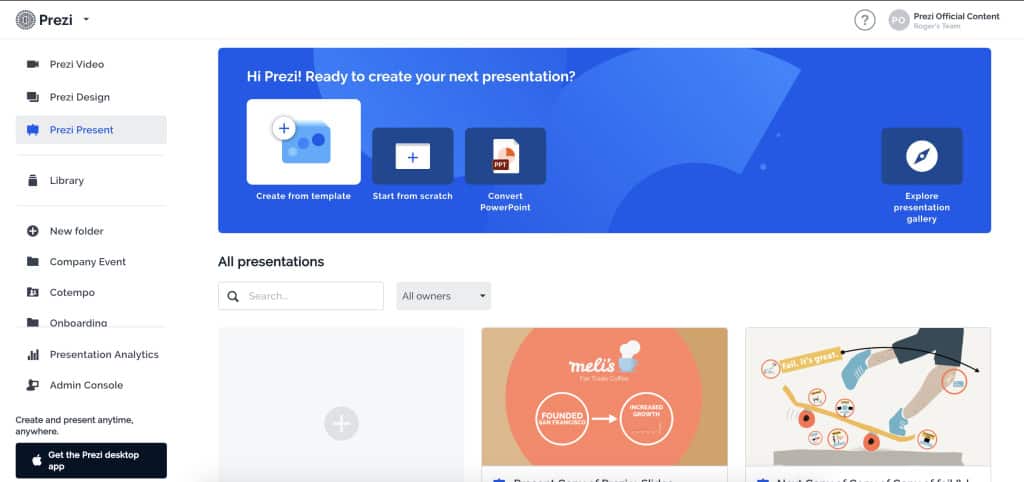
🎊 Learn more: Top 5+ Prezi Alternatives | 2024 Reveal From AhaSlides
NearPod is a good tool that most educators would get a kick out of. It is specifically designed to cater to educational needs, and the free basic version lets you host a presentation for up to 40 students.
Teachers can build lessons, share them with students and monitor their results. One of the best features of NearPod is the Zoom integration, where you can merge your ongoing Zoom lesson with the interactive presentation.
The tool also has various interactive features such as memory tests, polls, quizzes and video embedding features.
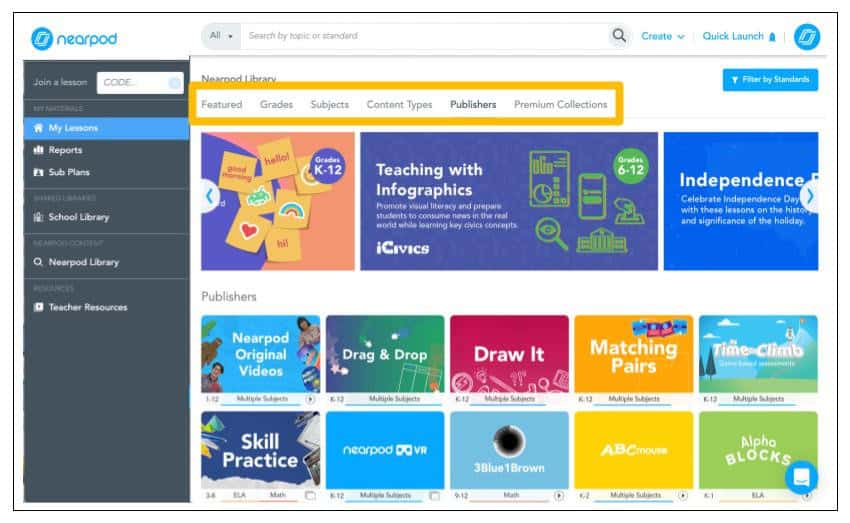
Canva is an easy-to-use kit that even a person with no design experience could master in a few minutes.
With the drag-and-drop feature of Canva, you can create your slides in no time and that too with copyright-free images and a ton of design templates to choose from.
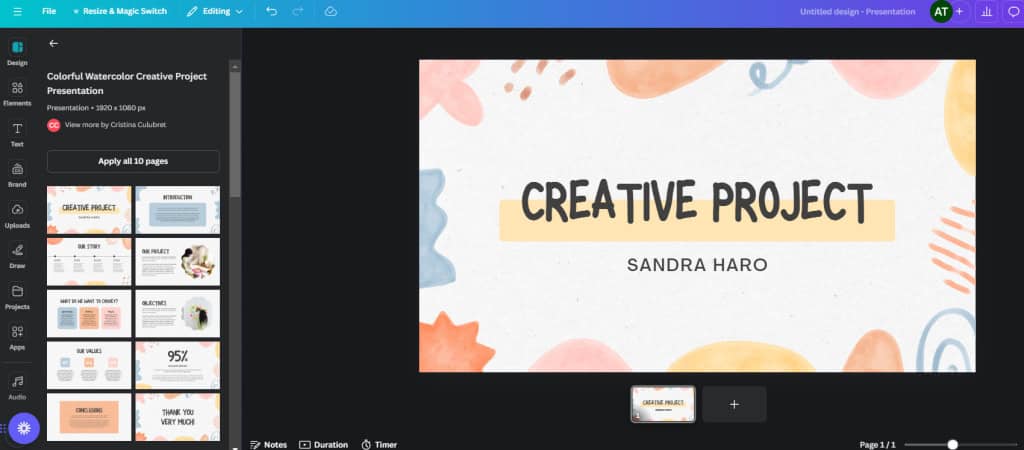
🎉 Learn more: Canva Alternatives | 2024 Reveal | Updated 12 Free and Paid Plans
Keynote for Mac
Keynote is one of the most popular bits of presentation software for Mac . It comes pre-installed and can be easily synced to iCloud, making it accessible across all Apple devices. Along with creating engaging presentations, you can also add a little bit of creativity by adding doodles and illustrations to your presentation.
Keynote presentations can also be exported to PowerPoint, allowing flexibility for the presenter.

Frequently Asked Questions
How do i make my presentation more interactive.
You can make a presentation more interactive with these 7 simple strategies: 1. Create icebreaker games 2. Make use of props 3. Create interactive presentation games and quizzes 4. Tell a compelling story 5. Organise a session using a brainstorming tool 6. Make a word cloud for the topic 7. Bring out the Poll Express
Can I make my PowerPoint interactive?
Yes, you can use PowerPoint's AhaSlides add-in to save time and effort while still being able to create interactive activities like polls, Q&A or quizzes.
How can you make presentations interactive to get students involved?
Here are some effective ways to make presentations more interactive and get students involved: 1. Use polls/surveys 2. Use quizzes, leaderboards, and points to make the content feel more game-like and fun. 3. Pose questions and cold call on students to answer and discuss their thinking. 4. Insert relevant videos and have students analyse or reflect on what they saw.
- Presentation outfit
- TED talks presentation
- Body language during a presentation
- How to get over Stage Fright
- Personality in a presentation
- Benefits of presentation software
- Zoom presentation tips
- Easy topic for presentation
To help you craft an impactful presentation, let's explore some common pitfalls and how to overcome them
- Bad speeches
- Bad presentation at work
- Death by PowerPoint

Lakshmi Puthanveedu
A small-town girl enthralled by culture, languages, and sunsets. Casual artist and musician looking to make memories every step of the way. Now changing the way humans live and have virtual interactions with AhaSlides.
Tips to Engage with Polls & Trivia
More from AhaSlides

Virtual Icebreakers Your Team Will Love
Rated 4.9 Stars
USED BY TOP REMOTE AND HYBRID TEAMS

"I am always searching for fun, engaging, and unique experiences to facilitate with a group. I discovered Slides With Friends and was blown away! What a great way to get all session attendees laughing, sharing, and connecting."
Elaine Schwartz, Digital Enablement Leader

"My team absolutely loves Slides With Friends. The interactions are so fun and it's easy to create custom polls & quizzes just for our group. This has quickly become one of my favorite tools for online team experiences."
Matthijs Keij, CEO

"As someone who’s been professionally gathering folks for years, I can 100% say that Slides With Friends is a huge breakthrough for any group looking to connect more deeply."

Najva Sol, Head of Product & Marketing

"Slides With Friends has been such an amazing addition to our team's remote stack. This tool brings people together in a way that is rare across the internet."

Steph Smith, Head of Paid Products
How to play these icebreakers, pick or build an icebreaker deck.
Grab a great, ready-to-play game, and start a presentation like you would for any typical slide deck. Your team can join in on their phones with a simple QR code or link (no downloads or logins required).

Play and interact seamlessly
It's easy for your group to join in from their phones or laptops and actively participate with these interactive icebreaker questions, trivia games, live photo show & tell, word clouds, and more.
See real engagement & enjoyment
Elevate your icebreaker into something engaging and fun, without any extra work. Your remote team, hybrid workers, audience, students, (or any group) will love interacting and having their voice heard.
Ready-to-play Icebreaker Decks
Try out our pre-made icebreaker games — just launch and play! Or you can customize with personal touches to make any deck your own.
Make icebreaking easy and interactive
A great, engaging icebreaker is one where you're hearing from everyone, and enabling everyone to actively participate. SlidesWith lets your team join in without needing to download or learn any new systems, and interact easily and enjoyably as a group.

Know how it went
It's just as important to know the results! Get automatic ratings & feedback, so you have real insight into your team's experience. You can even review your event stats and export post-event data. It's not "just playing games" — SlidesWith gives you tangible results you can show your boss or board.
Remote & hybrid friendly
From a conference hall to a Zoom call, you can use these interactive slides to give everyone a voice. Hear from everyone in your group, not just the loudest, fastest ones in the room. You can use SlidesWith anywhere you can share your screen, from Microsoft Teams to Webex to Google Meet.

Bring everyone together
It can be easy to feel disconnected if your team is hybrid or remote. This just means that we need to put more energy into bringing our group together. Fortunately there are great, easy ways to do this! Here are some tested and loved interactive slide deck icebreaker games that you can use to create team alignment, engagement, and enjoyment.
Customer Stories
Brings people together.
Slides With has been such an amazing addition to our team's remote work. This tool brings people together in a way that is rare across the internet. We use it for trivia at The Hustle, but could easily see how it could be expanded to other use cases!

Favorite of my team
My team absolutely loved SlidesWith. The interactions were so fun and it was easy to create a custom “around the world quiz” just for our group. SlidesWith has quickly become one of my favorite tools for online team experiences.

Great for education and young adults
Slides with Friends is a great tool for anyone wanting to connect with and engage a live audience, whether online or in person. The user interface is easy and intuitive, and the outcome is fun, interactive, and involving. (Oh and the soundboard, my teenagers loved it... a little too much!)

Frequently Asked Questions
Questions? We've got some answers.
Go to your account, select a deck, and open it! You'll see a big pink "Launch an event" button on the top right corner. When you click this, it will start a live, full-screen event (just like a powerpoint or google slides presentation). Display this live event page to your group (eg. "share your screen" on Zoom), and have them join in! Then advance through the slides by clicking the next arrow or pressing the arrow keys.
On the first slide of your launched event, you'll see an auto-generated QR code and a URL link. Tell your players to get their smartphone and open their camera. They just need to hold their camera up to the QR code, and they'll be taken to a join page. If they don't have a phone or are having trouble with the QR code, they can use the link displayed on that page, which goes to the same page. On this page, they'll be able to select an avatar, enter their name, and click "Join Event"! You'll see each person appear on your main screen, as they join. From there they can send in responses, photos, and fun sound reactions.
With a Pro account you can have up to 200 players join, and with a Starter account you can have up to 50 players. Our forever-free account lets small groups of up to 10 people play your event, no charge :)
Yes! Our forever free account is fully-featured. We believe in building strong connections and community, and for that reason SlidesWith will always be no-cost for smaller groups — you can create a deck and play with up to 10 people for free. The only time payment is required is if you want to run events with larger groups.
No, this is a slide deck presentation tool that you can use in any video call or in person. We recommend using SlidesWith wherever you can show your screen to your audience. So whether that's on a video call platform like Zoom, Google Meet, Microsoft Teams, Webex, (or any other video conferencing software), or live at an in-person or hybrid conference or meeting, as long as you can share your screen, you can use SlidesWith. Think of it like using a powerpoint presentation, but with superpowers ;)

"We received tons of positive feedback after using Slides With Friends. The beauty of this app is that it's so simple to design a unique branded game with questions and tasks on any topic. We loved this as an ice breaker!"

Try Slides With Friends for free
The easiest way to host meetings your team will love

How to incorporate game-based learning into your presentations

Published: December 21st, 2021
One of the most challenging aspects of presenting to students is capturing and holding their attention. Amidst all the distractions in the classroom, it can be difficult for students to maintain focus. Visual aids like PowerPoint slides can help, but even then, it’s often not long before a student’s mind wanders.
Even if using visual aids, traditional presentation formats, in which an educator reels off information to a passive audience, make it far too easy for students to lose focus. On the other hand, interactive presentations allow students to actively participate and are a much more engaging way to present content, especially when paired with fun educational games that encourage audience participation and critical thinking.
What is an interactive presentation?
An interactive presentation is a presentation that has content you can interact with. Interaction may be encouraged through the use of hyperlinks, pop-ups, or games. For example, an interactive presentation may include a prompt encouraging students to click on a picture or a section of text. This then displays a pop-up with additional information or a link to another resource. Alternatively, the presentation may incorporate a quiz or game.
Interactive presentations provide opportunities for students to take a more active role in the content and therefore are much more engaging. Students can actively participate in the presentation, rather than passively listening to the educator reel off information. A Harvard study showed that students who took part in active learning performed better in a later assessment than those who only learned passively.
Interactive presentations also give educators more creativity and flexibility. Rather than presenting content linearly and passively, interactive presentations enable educators to tailor their presentation to the lesson, letting them jump between slides and different pieces of information depending on the direction of the class discussion.
Advantages of interactive presentations
There are many benefits of using interactive presentations.
Increased engagement
Students can actively participate in the presentation, increasing the level of engagement. If a student loses attention, they are quickly drawn back in at the next point of interaction.
Better retention of information
Interactive presentations help educators capture their students’ attention and avoid distraction, meaning they’re more likely to retain the information presented to them. Interactive presentations also enable educators to bring concepts to life, which will make a much stronger impression on students than simply listening to the educator and taking notes.
More flexible presentations
It’s much easier to be flexible when presenting an interactive presentation. Educators can add prompts, such as questions, quizzes and polls, to encourage interaction and feedback. Then, depending on how the students respond to those prompts, educators can customise the presentation accordingly. It allows lessons to evolve and flow more organically from topic to topic. And because educators are getting immediate feedback on their presentations, they can better gauge if students are comprehending the content and tailor their lessons as they go.
More fun in the classroom
Interactive presentations add an element of excitement to the classroom. Not just another “boring” lecture, interactive presentations allow students to get up from their desks to interact with the presentation. It makes the presentation much more fun and breaks up the usual classroom routine.
Best interactive presentation tools for teachers
There is a lot of great interactive presentation software available online to help educators create more engaging presentations. Here are 5 of our favourite apps and tools.
Canva is an excellent tool for customising the visual design of your presentations. You can design your presentation directly in Canva using a Canva template or leveraging the library of images, shapes, and backgrounds provided.
2. Haiku Deck
Haiku Deck is one of the best interactive presentation software options for creating simple, image-based presentations. Haiku lets you create slides with a simple photo background and text. Type in text, and Haiku will recommend an image for you from its extensive gallery. You can also upload your own photos.
With Prezi , all information is presented on a single canvas rather than multiple slides. The canvas moves and zooms in and out for a more dynamic presentation, and the tool also includes a library of templates and interactive charts, maps, and graphics to help you bring information to life.
Prezi integrates with video, too, making it a great tool for remote learning. Prezi enables you to overlay visuals on the video as you’re presenting, making for a highly engaging video lesson.
4. Google Slides
While it may not be the most exciting or innovative technology on the list, Google Slides is probably one of the most user-friendly presentation software out there.
Google Slides is a free, simple, and easy-to-use presentation tool. It seamlessly integrates with all other Google tools, and because it’s cloud-based, it’s easy to encourage real-time student participation and collaboration.
5. ActivPanel Interactive Display
Of course, you won’t be able to use any of the technologies above if you don’t have a platform for displaying them. Interactive displays, like the ActivPanel Interactive Display, facilitate interactive presentations and provide easy access to apps and tools, allowing educators to move seamlessly between content and additional resources without disrupting the flow of the lesson.
Interactive displays can be directly annotated and drawn on, and they have options for teaching software , making it much easier for educators to create engaging presentations.
Interactive presentation games
One of the biggest advantages of the interactive presentation format is the opportunity to incorporate games into your lessons. Gamifying some of your presentation content is a great way to break up the traditional lecture format and add a bit of excitement.
Integrate one of these digital games into your presentation to encourage students to apply their knowledge. It’s a great way to promote critical and creative thinking.
Kahoot! is a popular tool for creating quizzes and polls that test your students’ comprehension in a fun and engaging way. Kahoot! for presentations includes a mixture of slides, audience participation features, and games, such as word clouds, polls, quizzes, and puzzles.
Use a free Jeopardy template for Google Slides to create your very own game show. You can copy the template and customise it with your questions and answers. Many free game show-inspired Google Slide templates are available online, including this “Who Wants to Be A Millionaire “-inspired slide deck.
Pictionary is a great game for encouraging creative thinking. You can use a random word generator to find a word, then have a student attempt to draw the word on the interactive display (without using any words, of course). Then have the rest of the class try to guess what they’re drawing.
How to incorporate interactive presentations and games into your lessons
Interactive displays make it easy for educators to create interactive and engaging presentations.
To see how Promethean can help integrate cutting-edge education technology into your classroom, get in touch with one of our experts for a free consultation and a virtual demo of the Promethean ActivPanel.
Recommended articles:
- Six creative ideas for your next classroom presentation
- Five ways to gamify your classroom and keep students motivated
- The ultimate list of classroom games
Choose your Country
North america, the middle east and asia pacific, rest of world.
What is Genially?
Genially is a cloud-based platform for building interactive learning and communication experiences.
Product Overview
Explore Genially's authoring and content creation features.

What's New
Discover our latest product updates and releases.
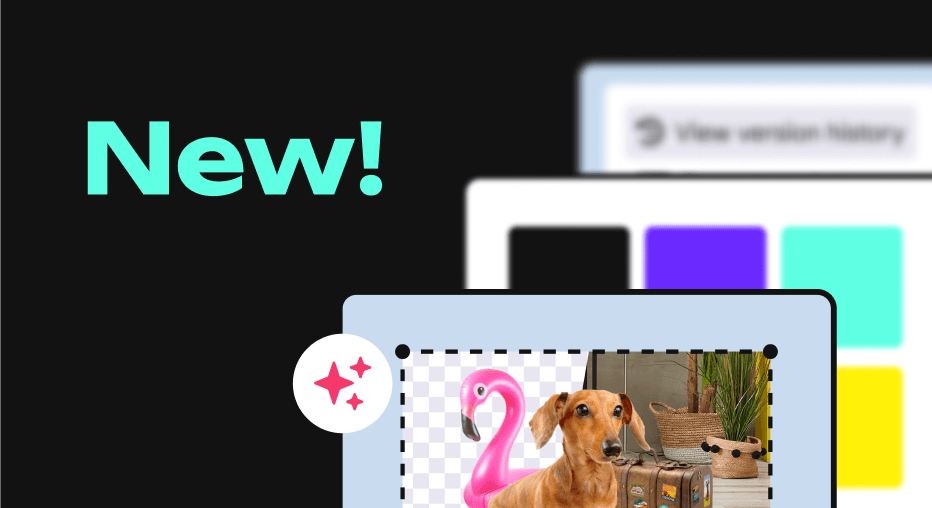
Discover how teams use Genially for eLearning, Marketing, and Communications.
K12 Schools
Explore how teachers use Genially to bring interactive learning to the classroom.
Higher Education
Discover how Learning Design teams and Faculty use Genially to build interactive courses.
Contact Sales
START CREATING
Build interactive images
Discover how to make interactive visuals and graphics.
Create interactive slides
Engage your audience with interactive slides and presentations.
Make interactive infographics
Learn how to design interactive data visualizations and diagrams.
More formats
From resumes to reports, make any kind of content interactive.
eLearning templates
Interactive resources for eLearning and corporate training courses.
K12 teaching templates
Interactive classroom resources for primary and secondary education.
Gamification templates
Escape games, quizzes, and other game-based learning activities.
Marketing templates
Interactive microsites, brochures, videos, and branding materials.
Explore all Genially templates
Browse over 1,500 pre-built designs. Save time and create professional interactive materials in minutes.
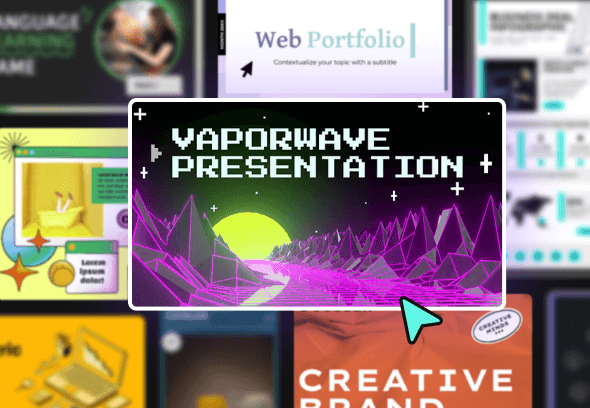
Explore Genially pricing and plans.

Plans for Teachers
Create interactive learning materials and use Genially in class with your students.

Make interactive presentations
Create show-stopping presentations and clickable slide decks with Genially’s free online presentation builder. Leave boring behind and tell a story that’s interactive, animated, and beautifully engaging.

INTERACTIVE CONTENT
A presentation that works like a website
Engage your audience with interactive slides that they can click on and explore. Add music, video, hotspots, popup windows, quiz games and interactive data visualizations in a couple of clicks. No coding required!
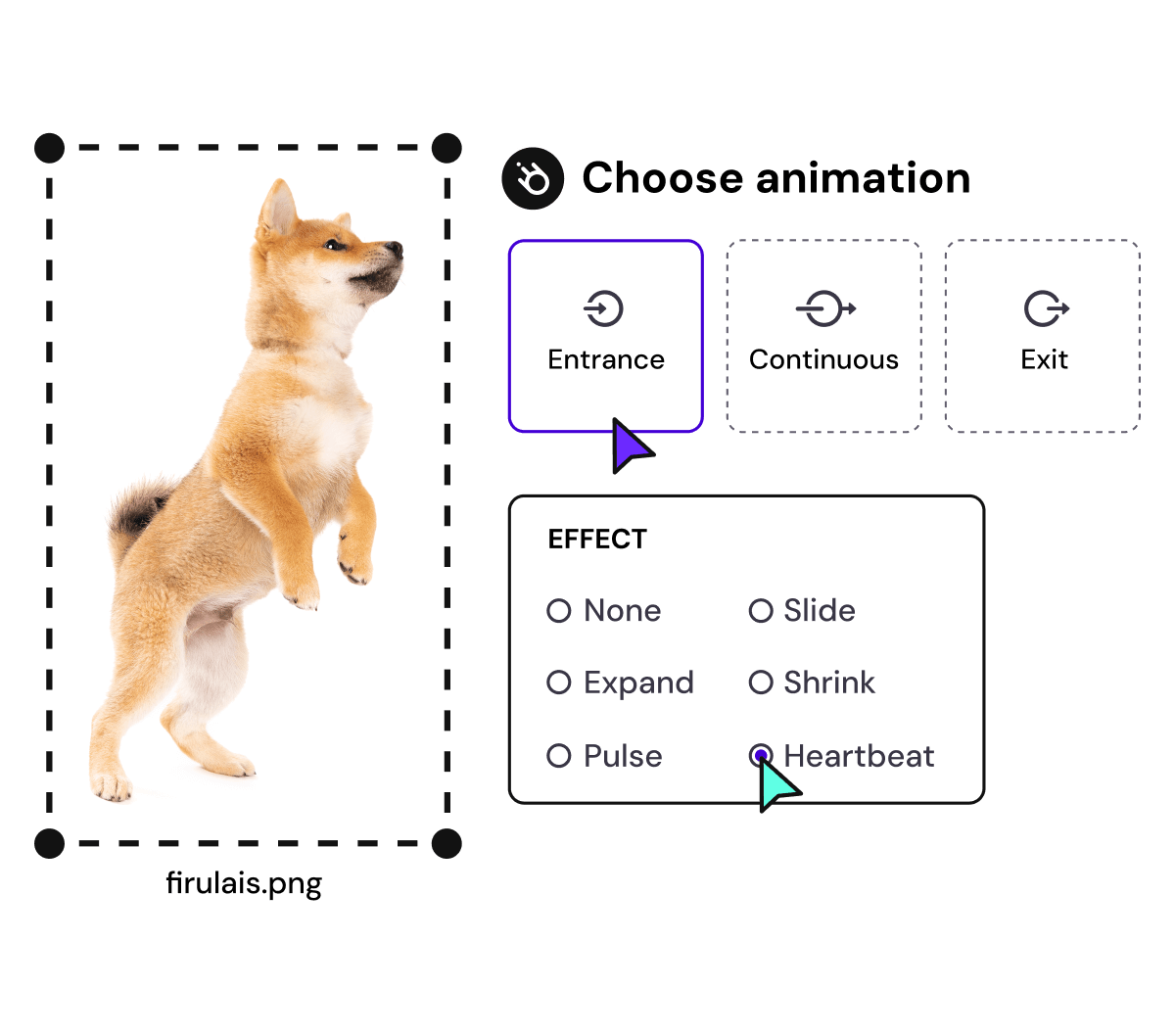
NO-CODE ANIMATION
Make your slides pop with animation
Bring a touch of movie magic to the screen with incredible visual effects and animated page transitions. Add click-trigger and timed animations to make any topic easy to understand and captivating to watch.
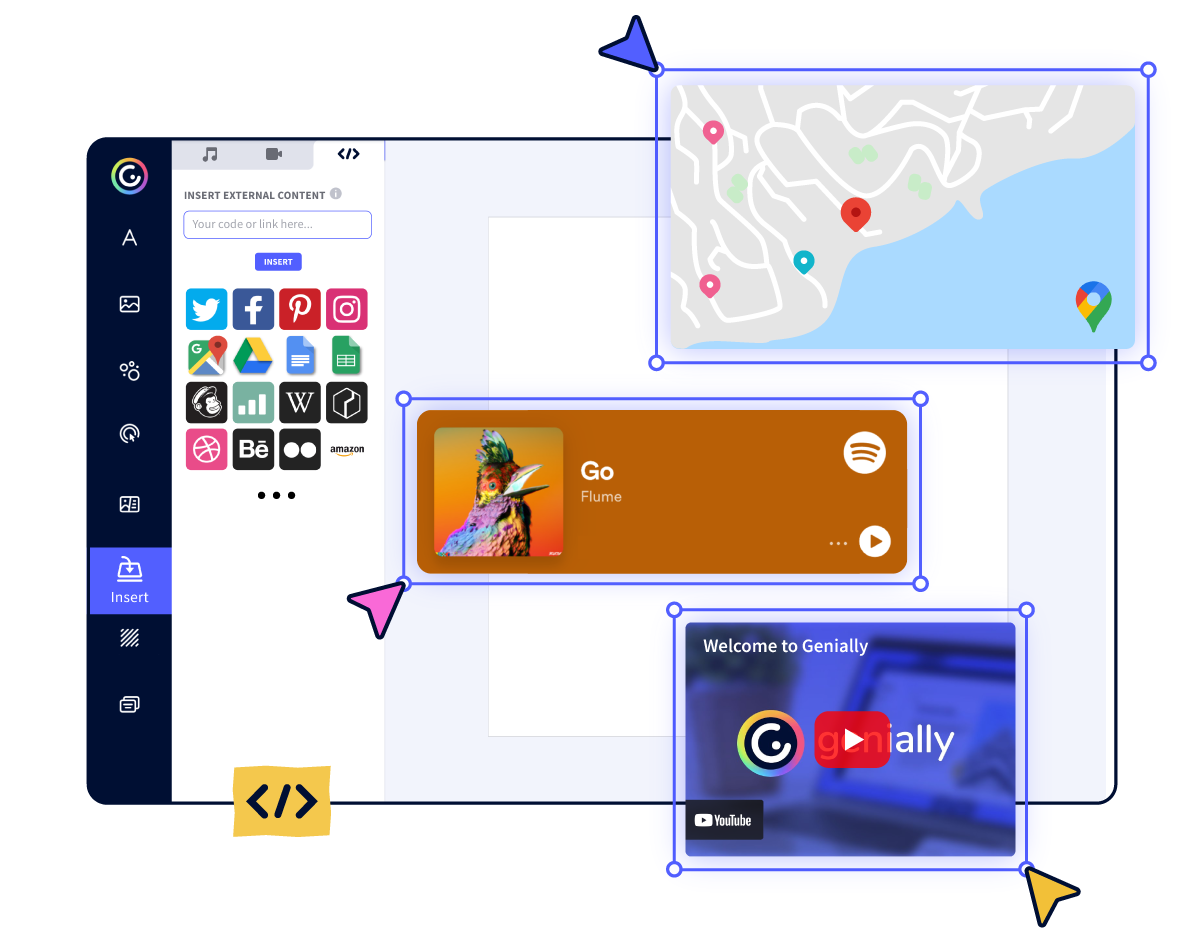
INTEGRATIONS
Live from the world wide web
Embed online content directly in your slides for a media-rich interactive experience. From YouTube and Spotify to Google Maps and Sheets, Genially works seamlessly with over 100 popular apps and websites.

TEMPLATES & TOOLKIT
Genius design tools
With Genially, anyone can create a polished and professional presentation. Choose from over 2000 pre-built templates, or create your own design using the drag-and-drop resources, color palettes, icons, maps and vector graphics.

ONLINE PLATFORM
Safe and sound in the cloud
Because Genially is online, you can relax knowing that your slides are always up-to-date. There’s no risk of forgetting to save changes or accessing the wrong file. Log in from anywhere, collaborate with your team, and make edits in real time.
All-in-one interactive presentation maker
Real-time collaboration
Co-edit slide decks with others in real time and organize all of your team projects in shared spaces.
Multi format
Present live, share the link, or download as an interactive PDF, MP4 video, JPG, HTML, or SCORM package.
Engagement Analytics
See how many people have viewed and clicked on your slides and keep tabs on learner progress with User Tracking.
Import from PPTX
Give your old decks a new lease of life by importing PowerPoint slides and transforming them with a little Genially magic.
Keep content on-brand with your logo, fonts, colors, brand assets, and team templates at your fingertips.
Quiz & Survey Builder
Use the Interactive Questions feature to add a fun quiz to your slides or gather feedback from your audience.
Beautiful templates
Make your next deck in a flash with Genially’s ready-to-use slides.
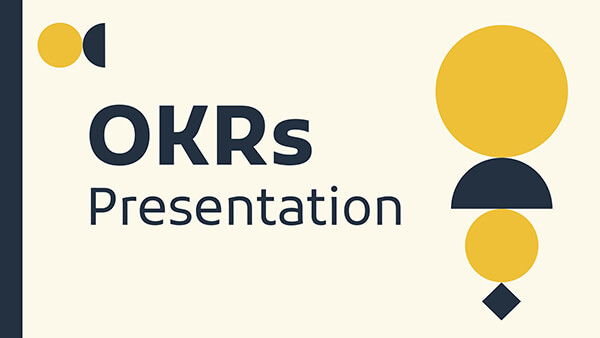
Okr shapes presentation

School notebook presentation

Animated sketch presentation

Minimal presentation

Land of magic presentation
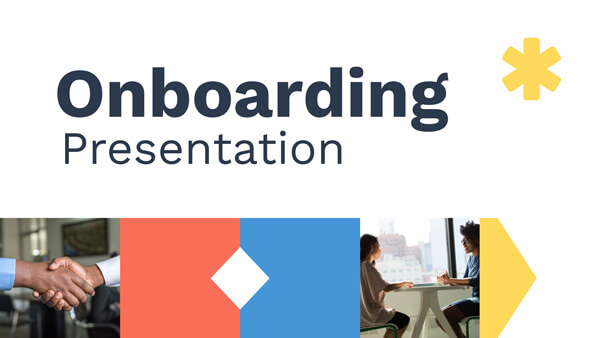
Onboarding presentation

Visual presentation
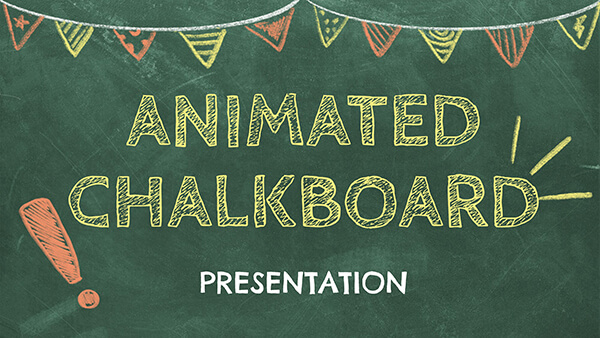
Animated chalkboard presentation

Online Education Guide
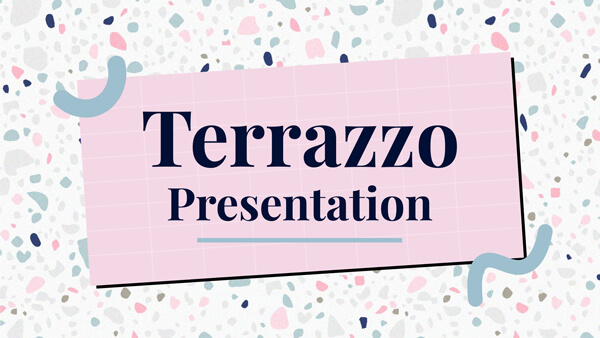
Terrazzo presentation

Startup pitch

Historical presentation
THEMES FOR EVERYONE
Interactive presentation ideas
From classroom materials to business pitches, make an impact every day with Genially.

Education presentations

Pitch decks

Business presentations

Thesis defense
Why the world loves Genially presentations

Share anywhere
Present live
From the front of the room or behind a screen, you’ll wow your audience with Genially. Heading off grid? Download in HTML to present dynamic slides without WiFi.
Share the link
Every Genially slide deck has its own unique url, just like a website! Share the link so that others can explore at their own pace, or download an MP4 video slideshow or PDF.
Post online
Embed the slides on your website or post them on social media. Upload to Microsoft Teams, Google Classroom, Moodle or any other platform.
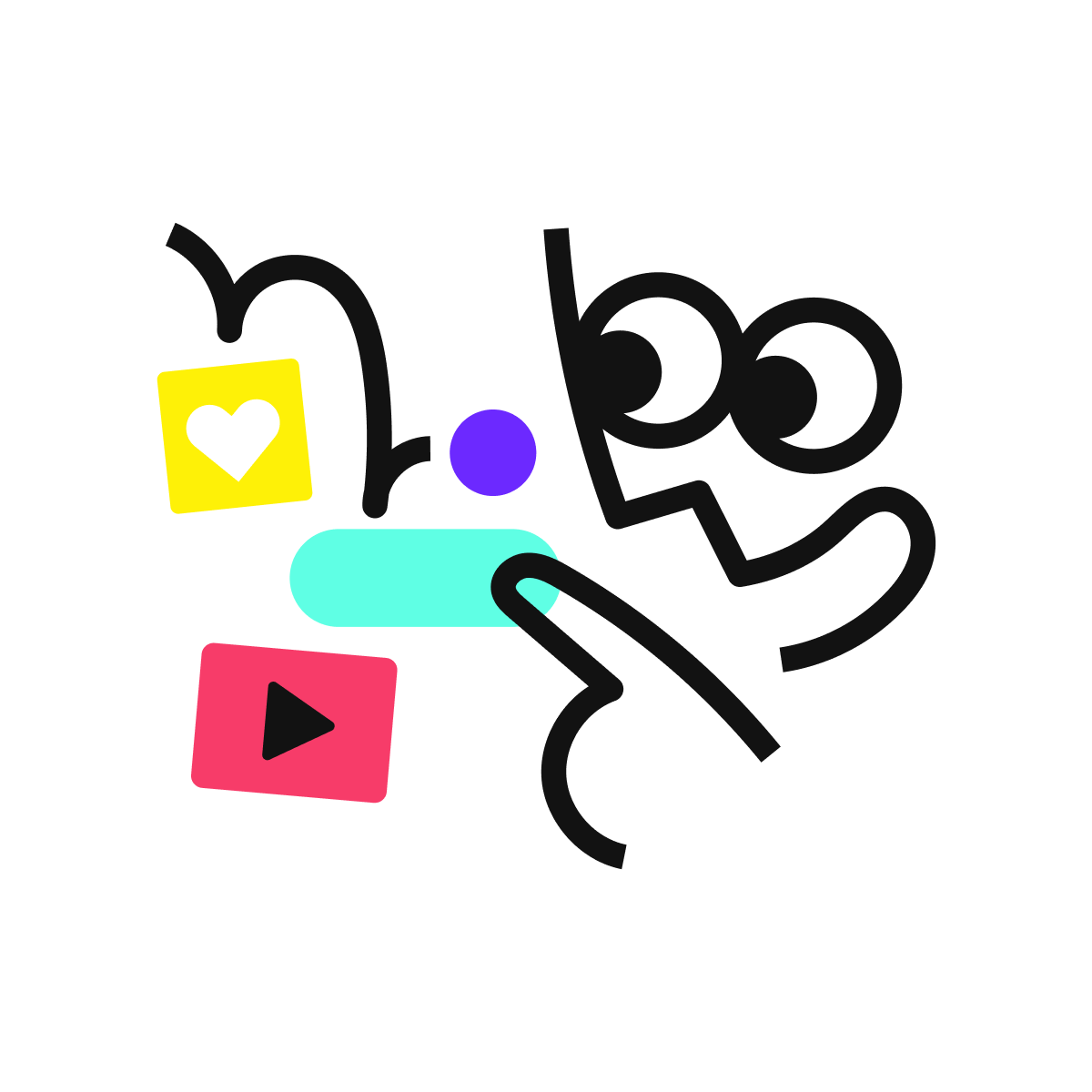
The benefits of interactive slides
🗣️ Active participation An interactive slide deck gives your audience cool things to click on and discover, boosting learning and engagement.
👂 Multi-sensory experience Audio, video, animations, and mouse interactions make your content immersive, entertaining and accessible.
🧑🤝🧑 People-friendly format Pop-ups and embeds condense more material into fewer slides so you can break information down into digestible chunks.
🎮 Gamification Games, quizzes and puzzles make information more memorable and enable you to gather feedback and check understanding.
How to make an interactive presentation
With Genially’s easy-to-use presentation platform, anyone can make incredible visual content in moments.
Choose a template or a blank canvas
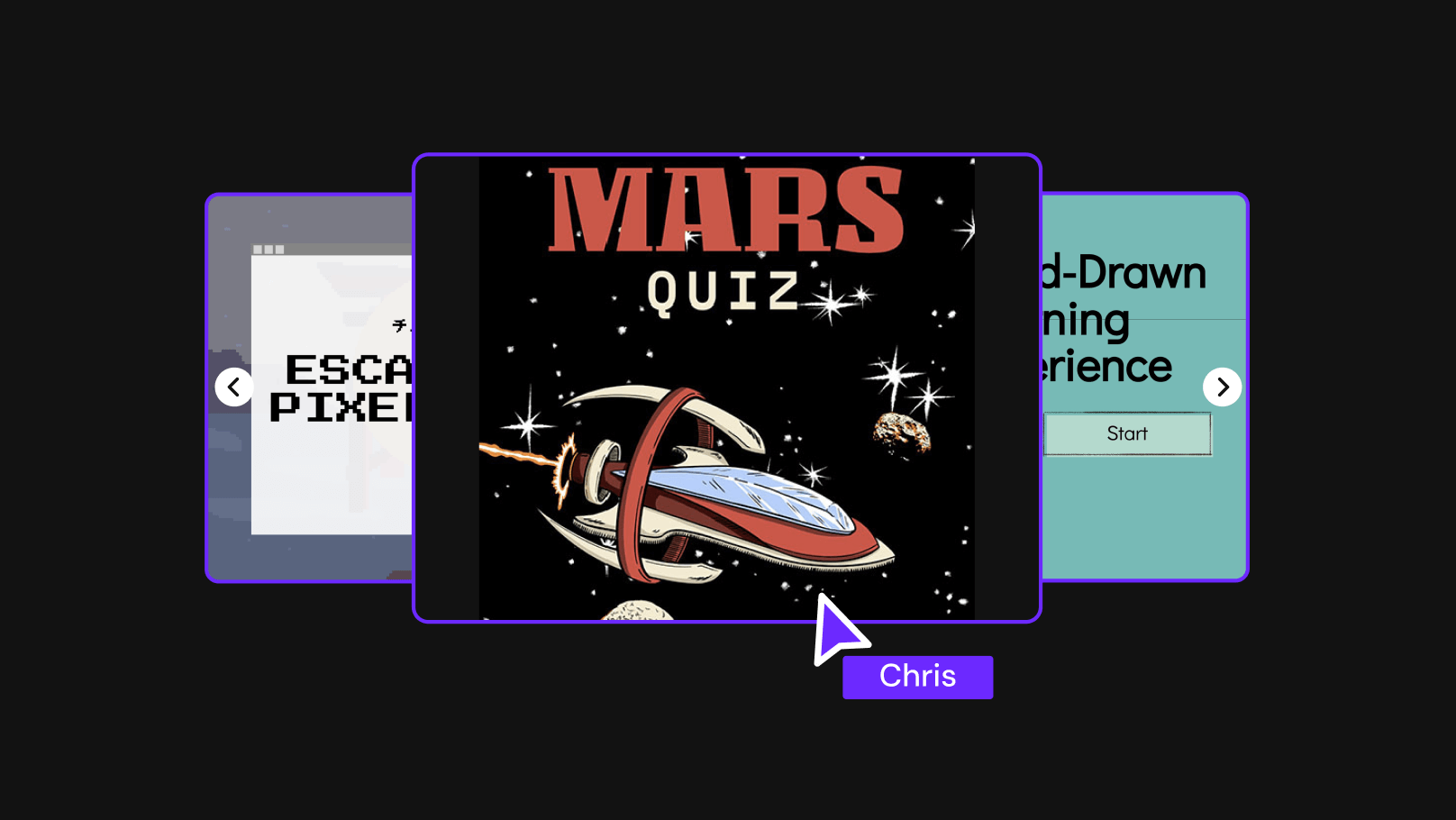
Get stunning results in less time with a ready-made template. Feeling creative? Design your own slides from scratch.
Customize the design
Add animations and interactions
Resources to become a pro presentation creator

VIDEO TUTORIAL
How to create an interactive presentation: Get started in Genially.

EXPERT TIPS
How to present data without sending your audience to sleep.
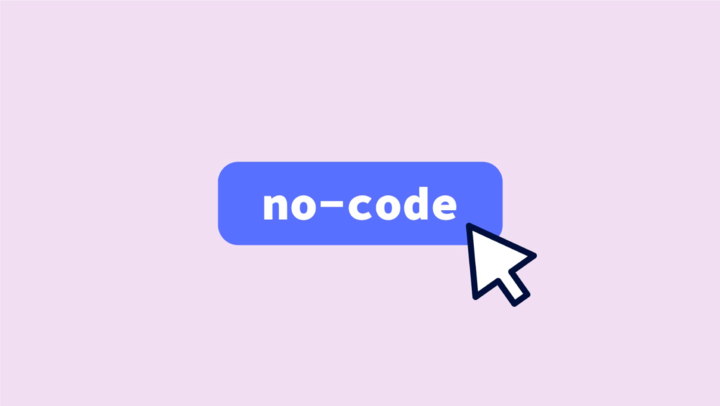
MICRO COURSE
No-code animation: Bring your slides to life with cinematic visual effects.

PRESENTATION IDEAS
The art of digital storytelling: Engage and thrill on screen.
Genially in a nutshell
How do I make a presentation interactive and how does Genially work? Find the answers to all of your slide-related questions here!
What’s an interactive presentation?
Interactive slides contain clickable hotspots, links, buttons, and animations that are activated at the touch of a button. Instead of reading or watching passively, your audience can actively interact with the content.
Genially’s interaction presentation software allows you to combine text, photos, video clips, audio and other content in one deck. It’s a great way to condense more information into fewer slides.
If you’re a teacher, you can share multiple materials in one single learning resource. Students can create their own projects using digital media and online maps. For business or training, try embedding spreadsheet data, PDFs, and online content directly in your slides.
An interactive slide deck is more user-friendly than a Microsoft PowerPoint presentation or Google Slides document. That’s because you can break information down into chunks with pop-ups, labels, voiceovers and annotated infographics.
The other benefit of interactive content is increased engagement. It’s easier to keep your audience’s attention when they’re actively participating. Try Genially’s presentation software and free slideshow maker to see how it’s better than other presentation websites. You won’t go back to standard presentation apps!
How do you make a clickable slide?
The best way to make slides clickable is to use Genially’s free interactive presentation program. Design your slide then apply an interaction. In a couple of clicks, you can add popup windows, hyperlinks, close-up images, games, animations, multimedia and other content.
Choose from the library of hotspot buttons and icons to show people what to click on. Go to Presenter View to get a preview and see how your content will appear to your audience.
How do I create presentations that look professional?
You’ve got a deadline looming and you’re staring at the screen with a blank presentation. We’ve all been there! Starting a presentation design from scratch is tricky, especially if you’re short on time.
Genially’s free online presentation maker has over 2000 ready-to-use templates for professional slide presentations, photos slideshows, and more. Each slide design has been created by our team of top graphic designers. No need to worry about fonts, centering images, or designing a matching color scheme. It’s all done for you.
Start by browsing our layouts and themes for education, business and then customize with your own text and images.
How do I share or download my slides?
Because Genially is a cloud based presentation software, you can simply share the link to your slides. Like other online presentation tools, there are no files to download or store on your computer. Everything is saved online.
When you publish your slide deck, it gets its own unique url, just like a website. Share the link with others to let them explore the content in their own time. If you’re presenting live, just click the Present button.
You can also embed your presentation on your website, company wiki, or social media. Genially is compatible with WordPress, Moodle, Google Classroom, and other platforms. If you use an LMS, you can also download your interactive design slides in SCORM format.
For slideshow videos and slideshows with music, share online or download as an MP4 video. Check out our free slideshow templates for ideas.
Can I make a free presentation in Genially?
You bet! Genially is an easy-to-use slide maker, with a free version and paid plans. The free plan allows you to create unlimited slides with interactions and animations. Subscribe to one of our paid plans for more advanced features.
Discover a world of interactive content
Join the 25 million people designing incredible interactive experiences with Genially.
- International
- Education Jobs
- Schools directory
- Resources Education Jobs Schools directory News Search

Let's get to know you Bingo Game - Icebreaker Activity | Back to School Activities
Subject: English
Age range: 3-5
Resource type: Worksheet/Activity
Last updated
23 August 2024
- Share through email
- Share through twitter
- Share through linkedin
- Share through facebook
- Share through pinterest

Let’s Get to Know You Bingo Game - Icebreaker Activity (Back to School Activities)
Make the first days of school exciting and interactive with the “Let’s Get to Know You Bingo Game”! This engaging icebreaker activity is perfect for helping students learn about each other in a fun and relaxed environment. It’s an excellent way to build a positive classroom community from day one.
What’s Included:
Bingo Cards: Printable Bingo cards with various prompts to encourage students to interact and learn about their classmates. Instructions: Clear, easy-to-follow directions to ensure a smooth and enjoyable activity. Discussion Prompts: Questions to facilitate deeper conversations and reflections after the game. Blank Bingo Cards: Customizable templates for students to create their own prompts. How It Works: Each student receives a Bingo card filled with prompts such as “Has a pet,” “Loves to read,” or “Has traveled to another country.” Students mingle and ask each other questions to find classmates who match the prompts, writing their names in the corresponding squares. The first student to complete a row, column, or diagonal shouts “Bingo!” and shares their findings with the class.
Encourages Interaction: Helps students break the ice and start conversations with their peers. Builds Classroom Community: Fosters a sense of belonging and connection among students. Promotes Social Skills: Encourages communication, active listening, and interpersonal skills. Engages Students: Fun and interactive, keeping students excited and involved.
Perfect For:
Back to School: Ideal for the first week of school to help students get to know each other. All Grade Levels: Adaptable for elementary, middle, and high school students. Team Building: Great for any group setting where building rapport and understanding is important. Kick off the school year with a bang using the “Let’s Get to Know You Bingo Game” – an icebreaker activity that makes learning about each other fun and memorable!
Key Features:
Formats: PDF, PPTX AND JPG.
Page Size: 8.5 x 11 inches.
Resolution: High-quality 300 DPI.
Page Count: 02 pages.
Tes paid licence How can I reuse this?
Your rating is required to reflect your happiness.
It's good to leave some feedback.
Something went wrong, please try again later.
This resource hasn't been reviewed yet
To ensure quality for our reviews, only customers who have purchased this resource can review it
Report this resource to let us know if it violates our terms and conditions. Our customer service team will review your report and will be in touch.
Not quite what you were looking for? Search by keyword to find the right resource:

IMAGES
COMMENTS
Are you prepping for a presentation? Don't forget the importance of engaging your listeners! To keep your group's attention, we've compiled 14 fun interactive presentation games.
Audience engagement is not easy to win, but with these 11 interactive presentation games for large and small events, you can confidently present knowing your voice's heard.
Add some friendly competition to your next class or team meeting with these interactive presentation games powered by Poll Everywhere for your audience.
20 Interactive Presentation Games. 1. Project Jeopardy. This game is designed to make the presentation of reports more fun and interactive. The lead person on the report creates cards that have answers from the report. For example, the card reads "25%.". The rest of the team is supposed to ask the correct question corresponding to the "25 ...
From quizzes to polls, captivate your audience and make your presentations unforgettable with 15 interactive presentation games.
Creative Games for the Classroom, for your Workshop and to engage your Participants. Playing Audience Games lightens the mood, strengthens teamwork and allows for a better learning experience.
Engage your audience with these interactive PowerPoint Games. Customize these templates to fit your very own topic and presentation. The file includes templates for Interactive Quizzes, Family Feud, Wheel of Fortune, Memory, Hangman, Jeopardy, and a PowerPoint Puzzle! Download PowerPoint Game Templates.
Discover 15 innovative 5-minute interactive presentation ideas to captivate your audience and take your presentations to the next level.
Engage your audience with interactive presentation games. From live trivia to icebreakers and quizzes, these activities make presentations memorable.
20 interactive PowerPoint activities to add awesome to classes PowerPoint lets students collaborate and display ideas effectively. Create animation, story books, video galleries and more. Here are 20 ideas for using PowerPoint in your classroom.
Google Slides isn't just for delivering presentations to an audience. Here are 30 activities that bring interactive learning to students.
We've compiled 12 of our favorite interactive PowerPoint activities you can use with your students. All of the activities are designed to engage your students in ways they'll love. Even better, these activities let you use a tool you're probably already familiar with. And read to the end for an exciting new announcement!
If you're looking for the perfect icebreaker to open your presentation and connect with your audience from the get-go, look no further! With the help of our presentation experts here at 24Slides, we have compiled the ultimate list of icebreakers you can use in your next presentation, meeting, or conference.
Interactive presentations help engage students by having them participate in the lessons instead of passively listening to lectures. This reduces boredom and gives students a sense of responsibility to be attentive. grade 74% of students feel they are engaged in school, but by the 10 grade those numbers fall to the 30% range.
Need to make your presentation memorable? Make it interactive and really impress your audience with all of our tips and tricks!
There's a huge variety of different presentation games available, spanning loads of the topics covered in primary school learning. There are starter activity ideas, whole-class presentations, and even some fun interactive quizzes.
Discover these interactive presentation ideas, which are ideal for classes with children or teens of any age. Keep your students engaged with this inspiration!
Effective presentation games for large teams include 'Elimination', 'Topic of the Day', 'Assumptions', 'Fill Gaps', and '30 Seconds' for dynamic interaction. These games keep the audience engaged, encourage participation, and make complex topics more approachable. 'Bring into Practice' and 'Duo Assignment' stimulate practical application and ...
There are several benefits to using PowerPoint games in the classroom. They provide an opportunity to model an activity or a game (especially with large classes), they can be fun to play, they are easy to create or edit and they don't require an internet connection. Great for station rotations and partner work as well! Can be used on ANY device!
Here are some effective ways to make presentations more interactive and get students involved: 1. Use polls/surveys. 2. Use quizzes, leaderboards, and points to make the content feel more game-like and fun. 3. Pose questions and cold call on students to answer and discuss their thinking. 4.
Build stronger remote and hybrid teams with our online interactive games. Use Slides With Friends to bring your remote team together with icebreakers, happy hour games, real-time surveys, interactive training, and much more.
Learn how you can use interactive presentation games and tools as a powerful training tool that helps teachers make critical thinking playful and engaging!
Create clickable presentations and slide decks with animation, infographics, multimedia and beautiful design. Easy to use. 1000+ templates.
All Grade Levels: Adaptable for elementary, middle, and high school students. Team Building: Great for any group setting where building rapport and understanding is important. Kick off the school year with a bang using the "Let's Get to Know You Bingo Game" - an icebreaker activity that makes learning about each other fun and memorable!